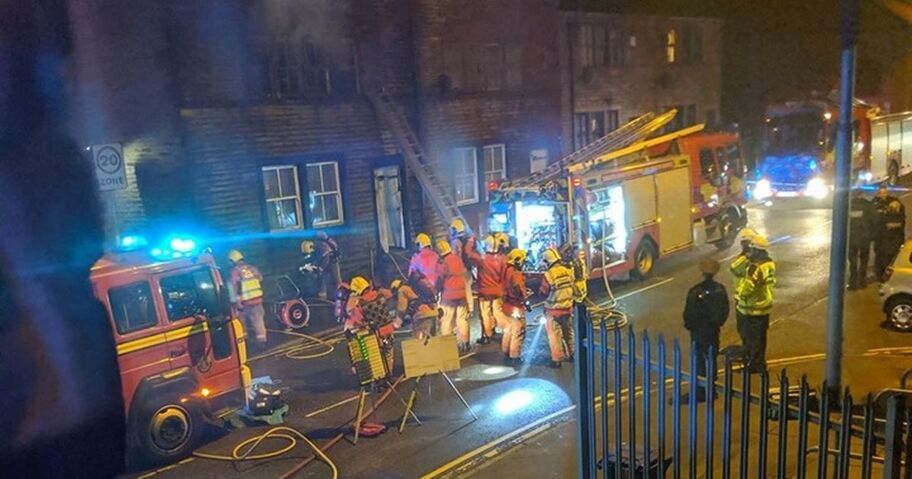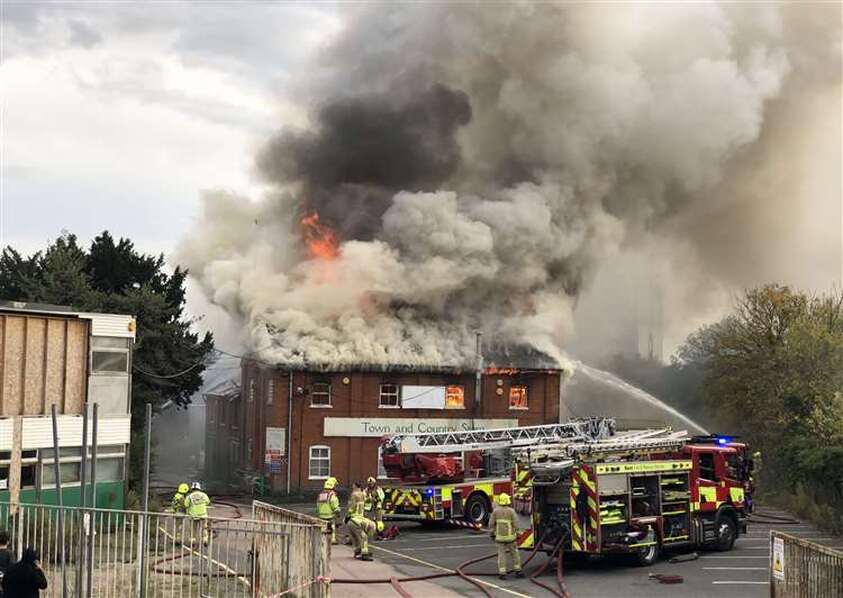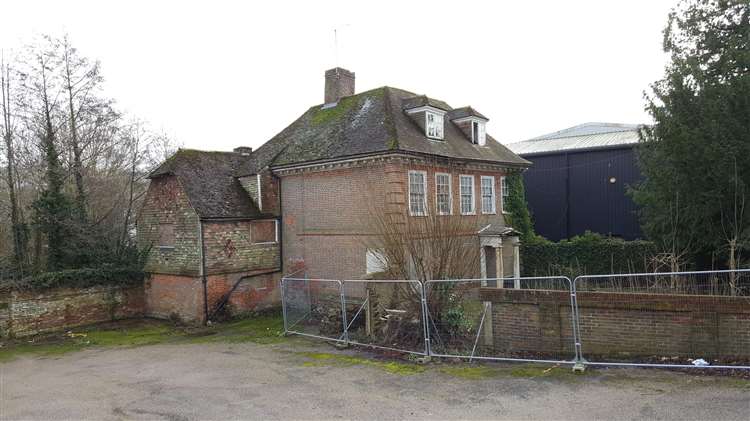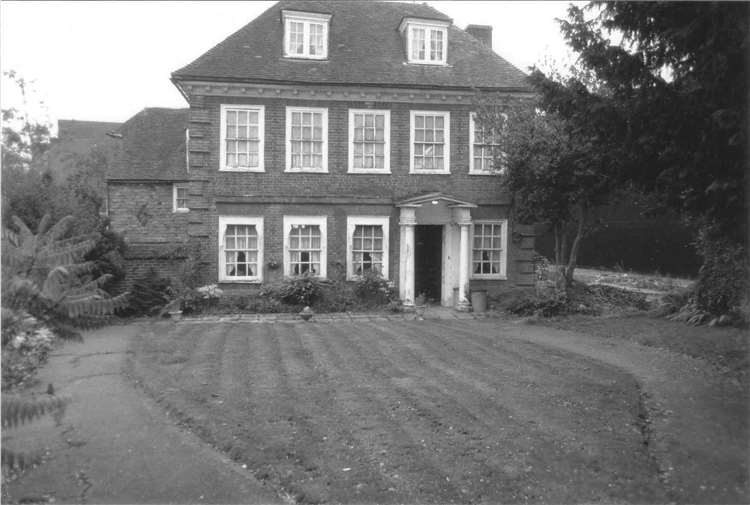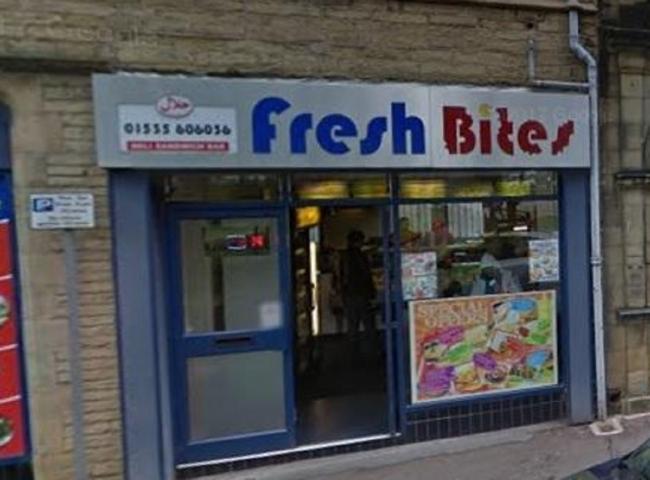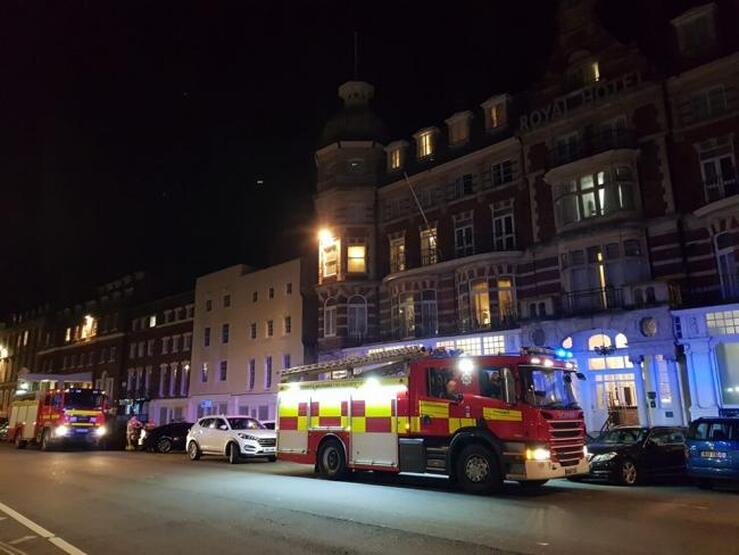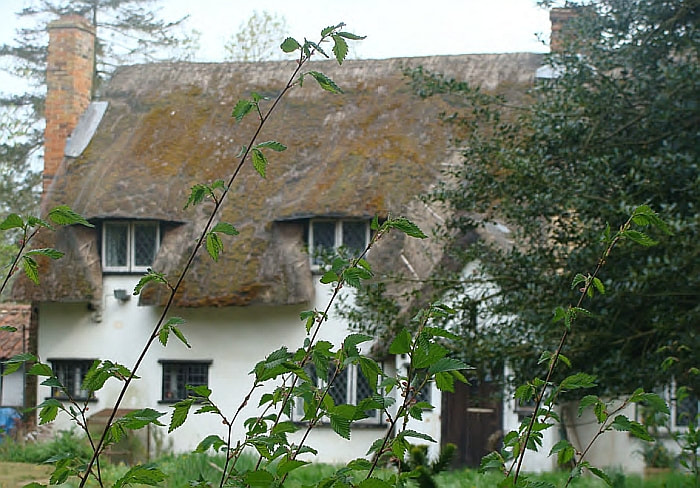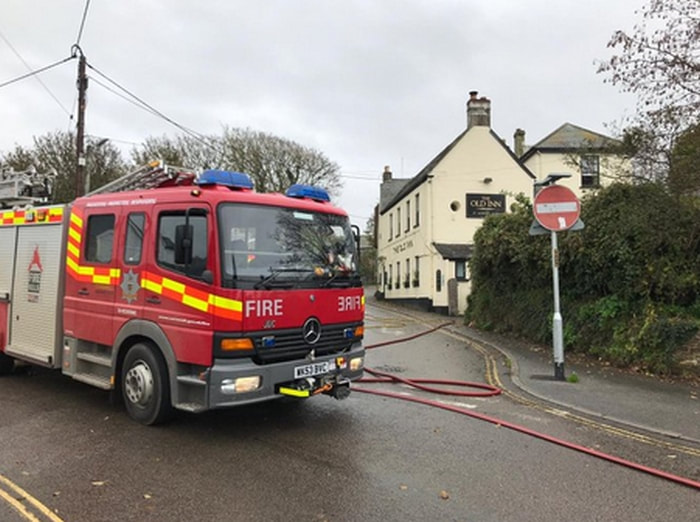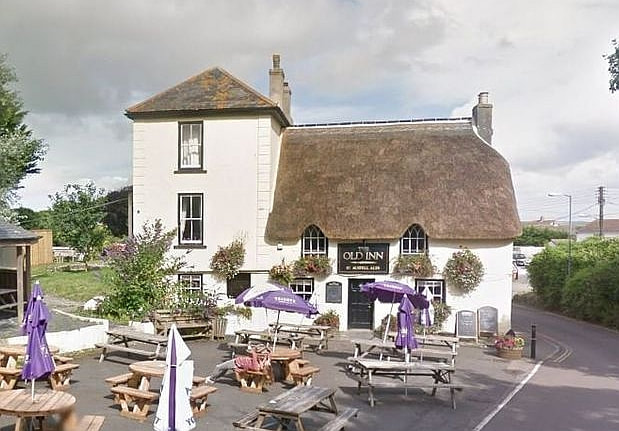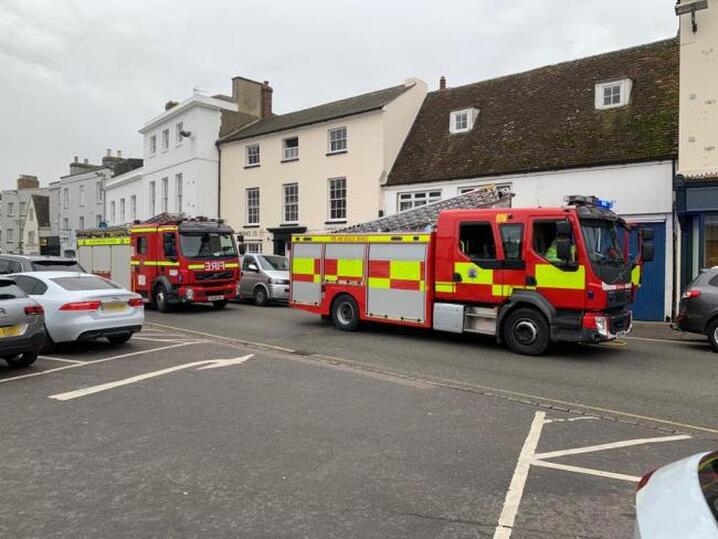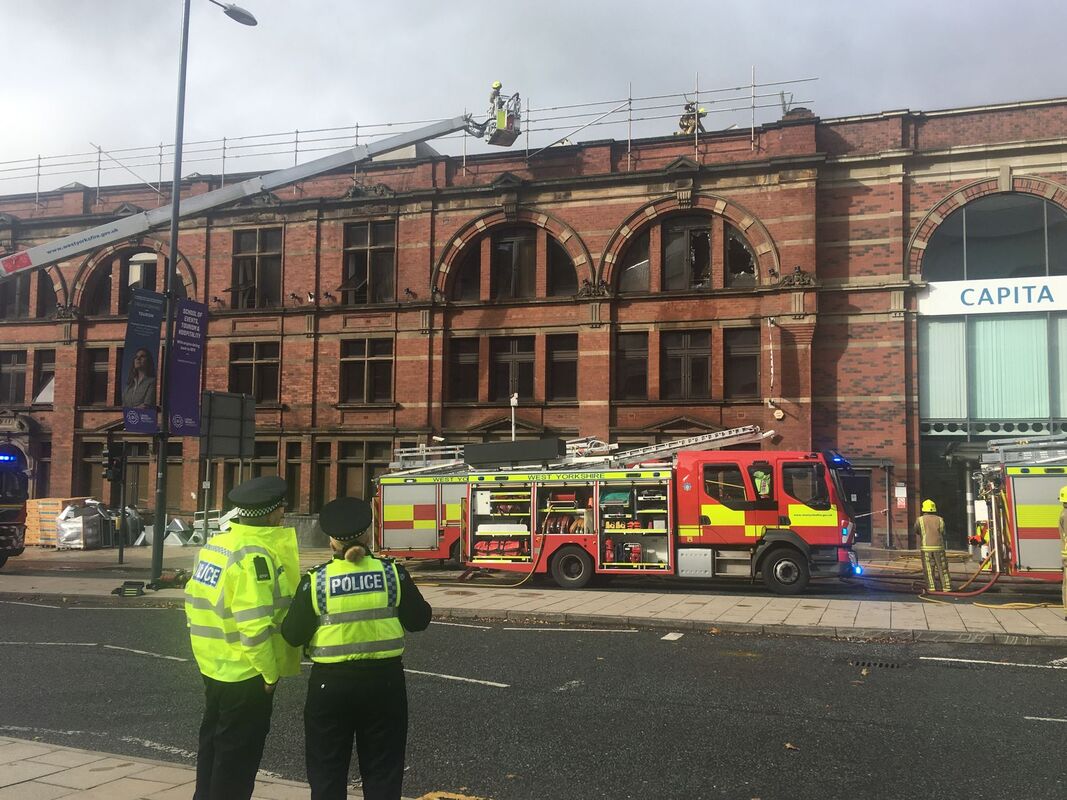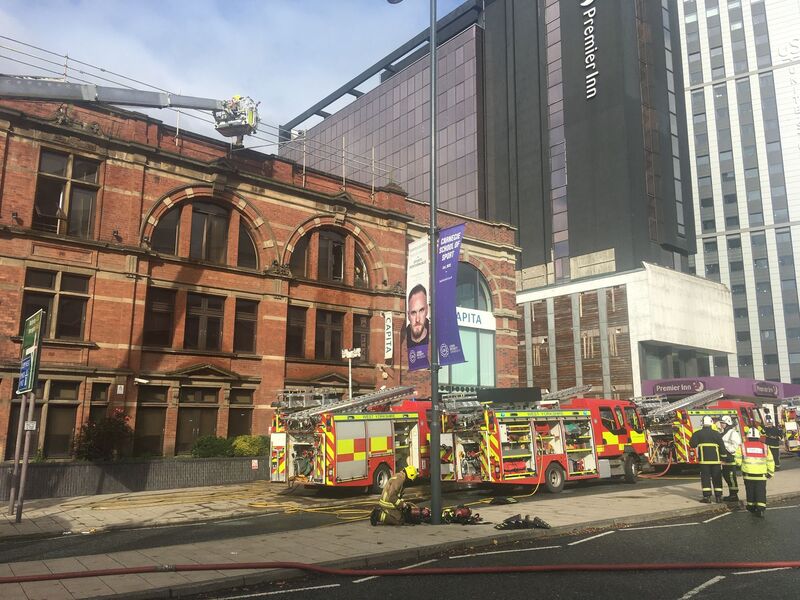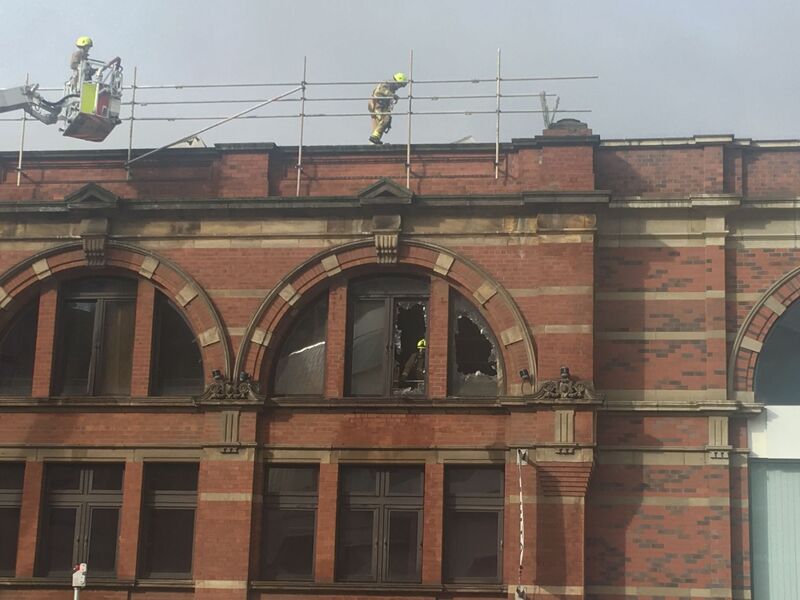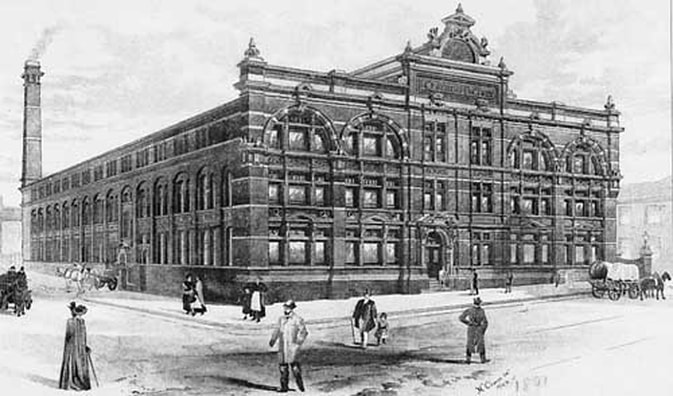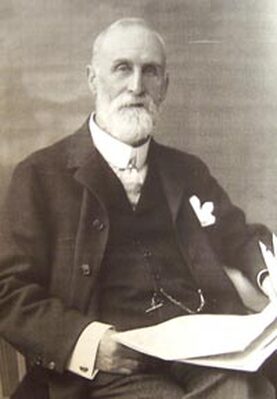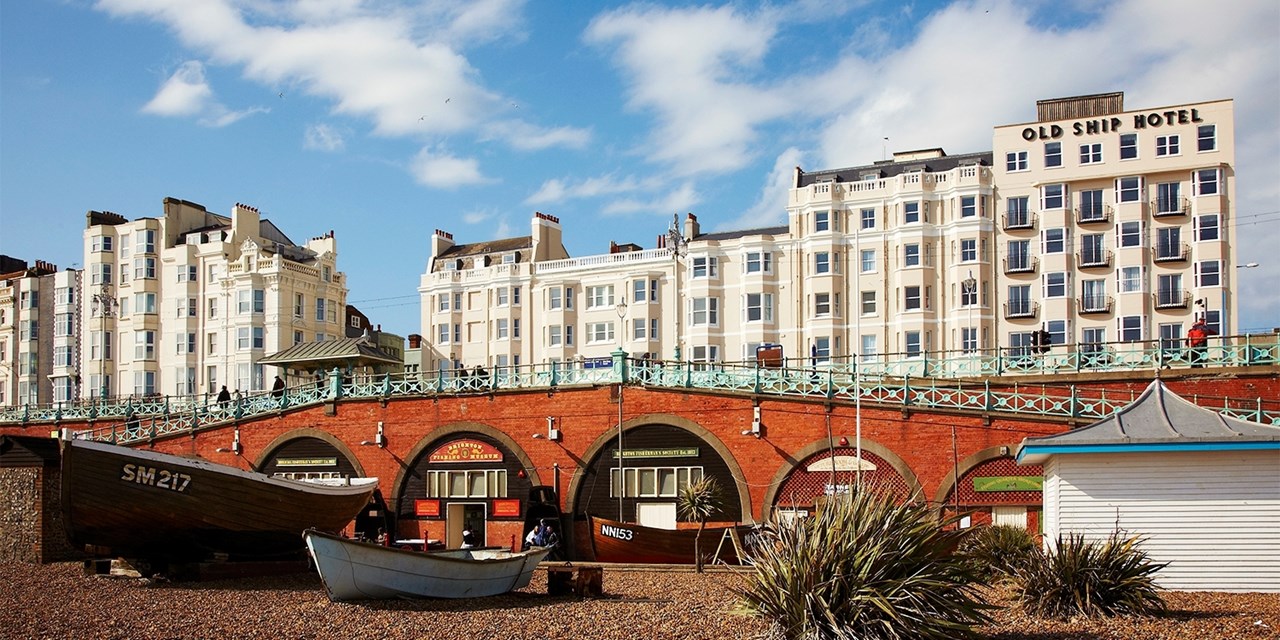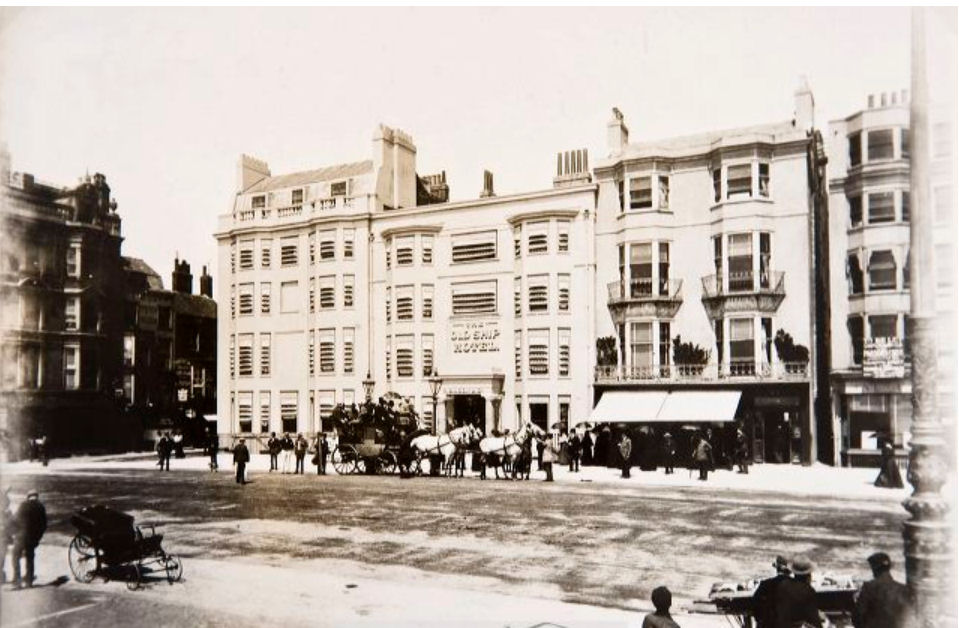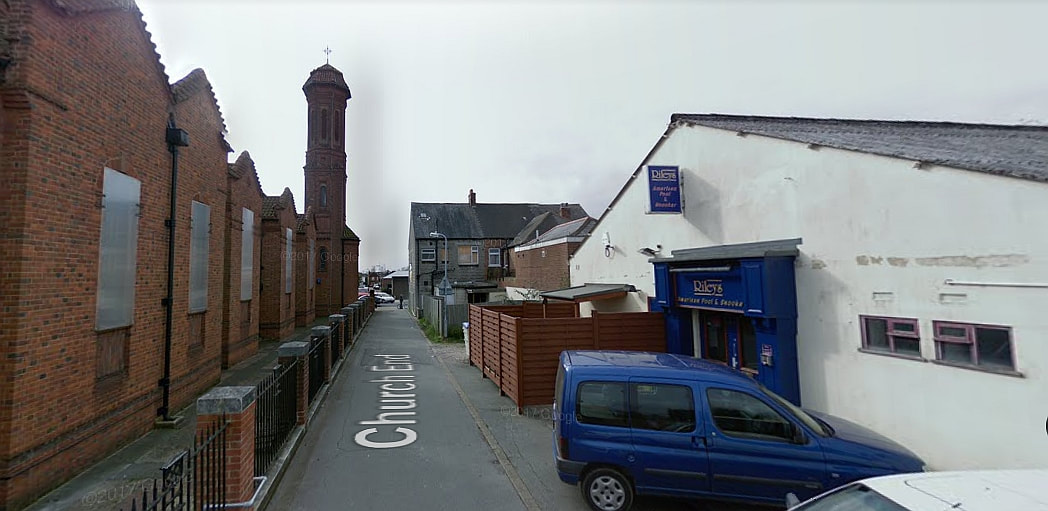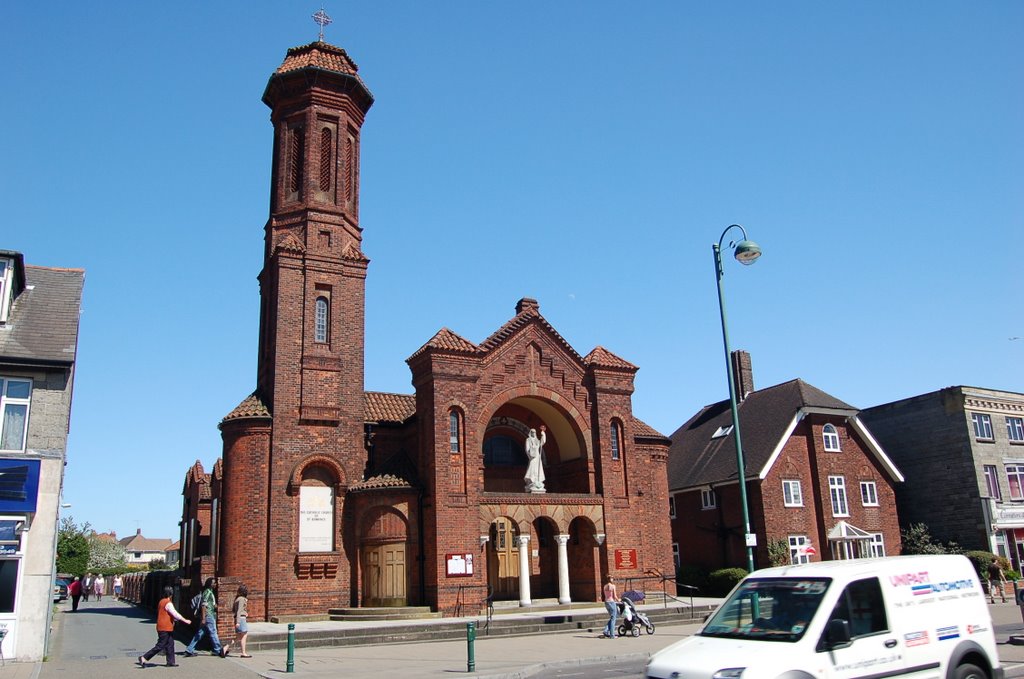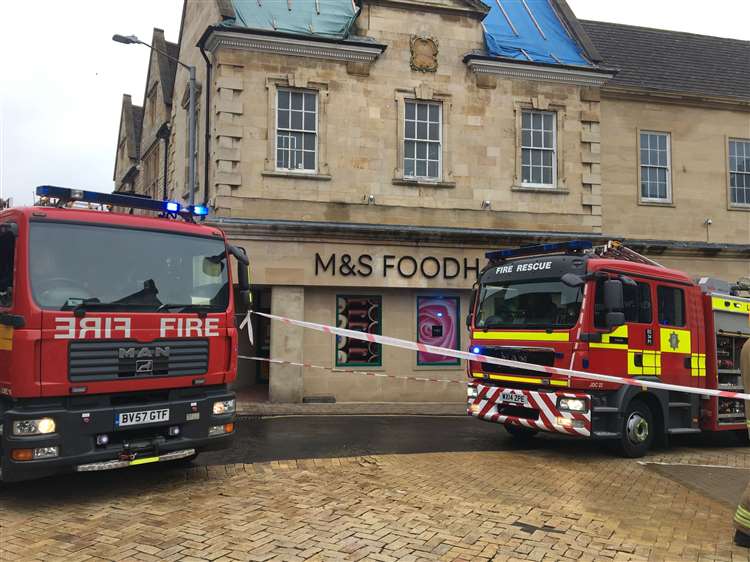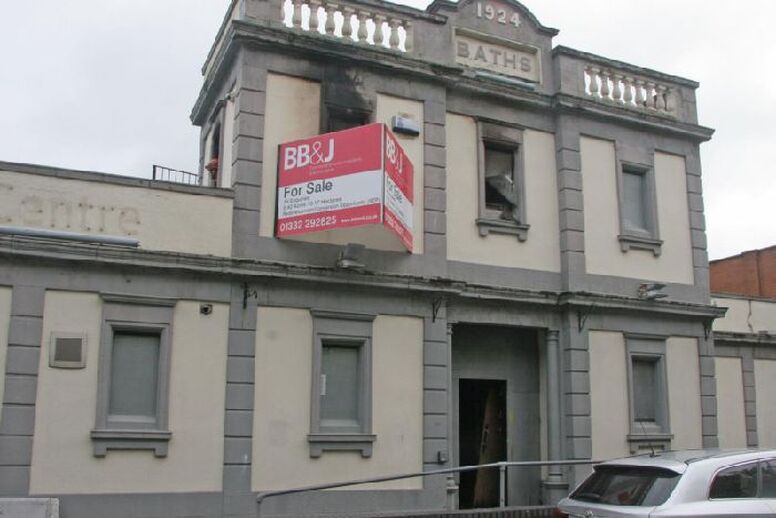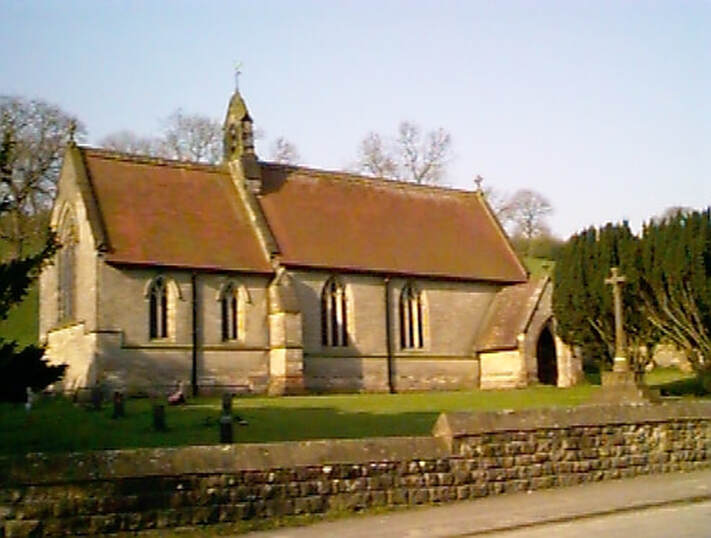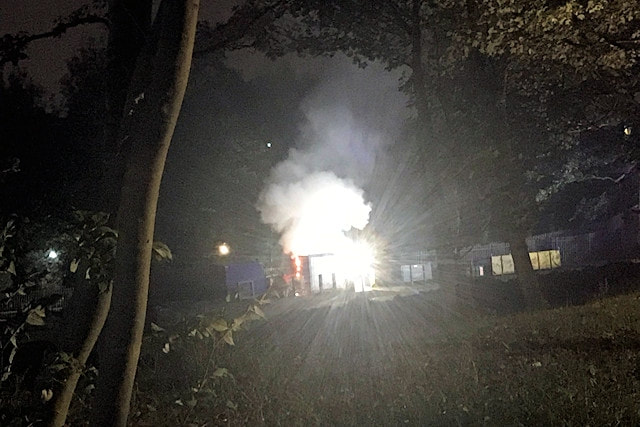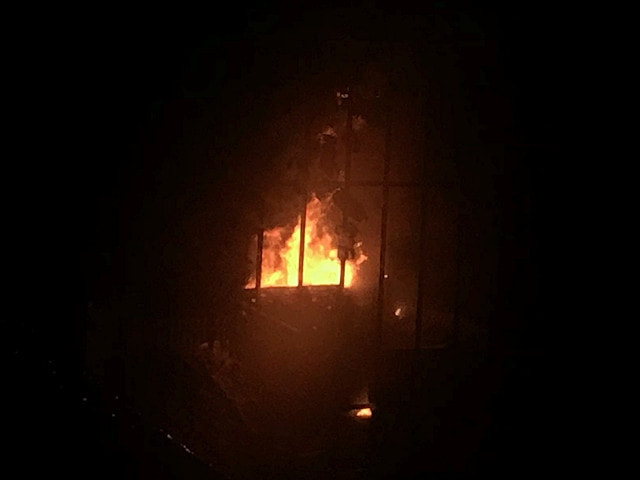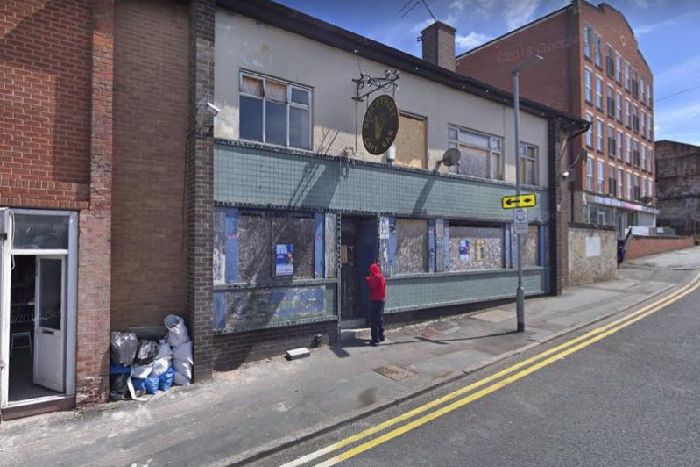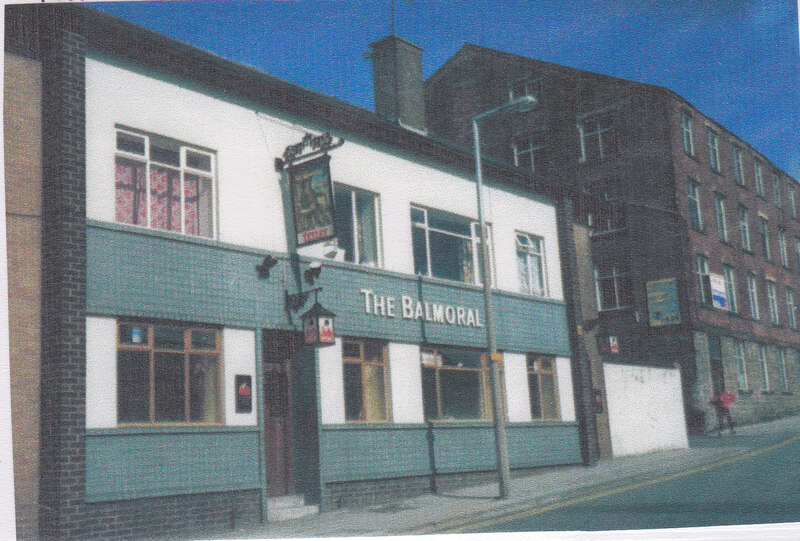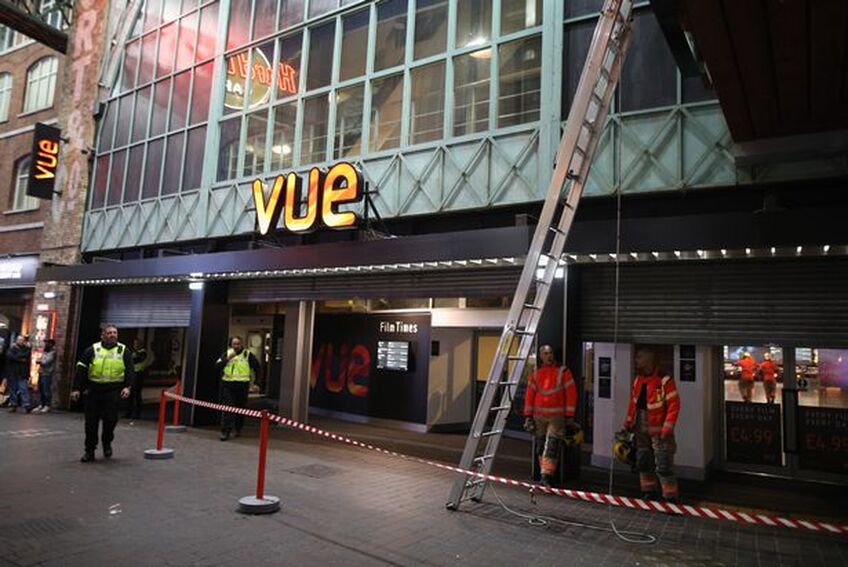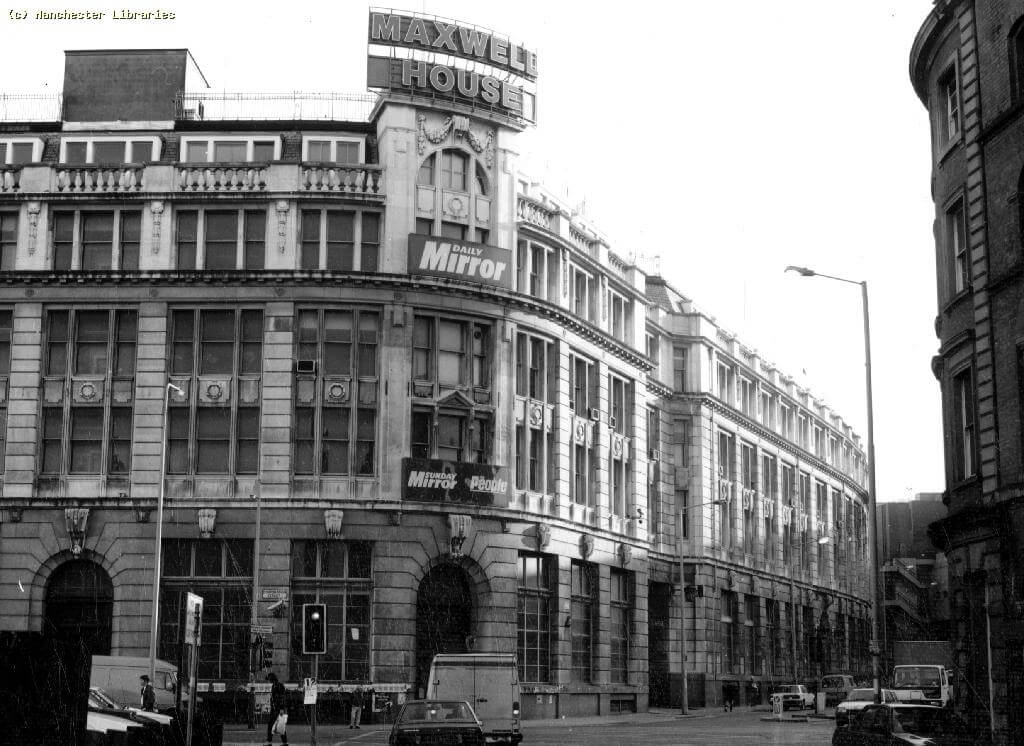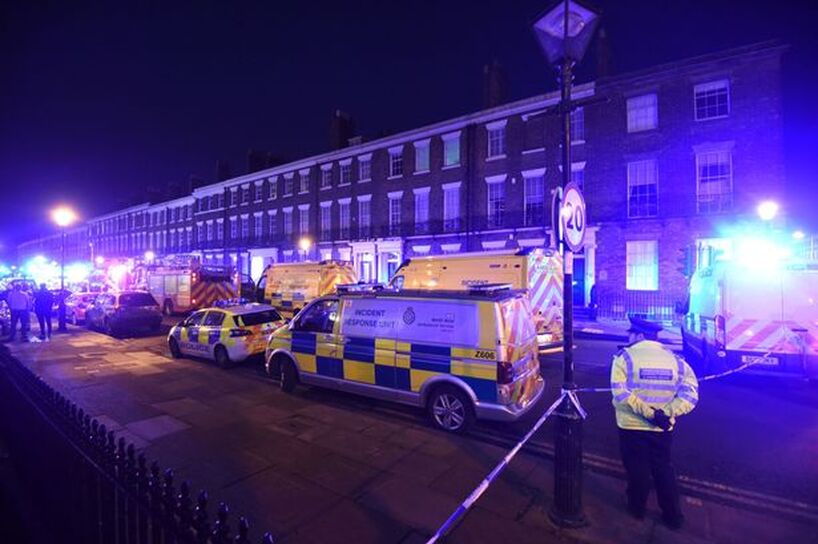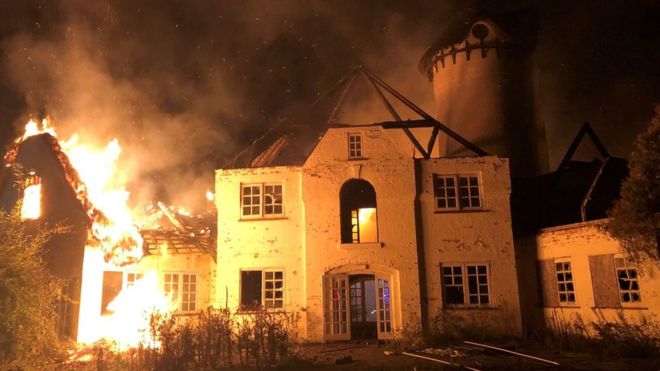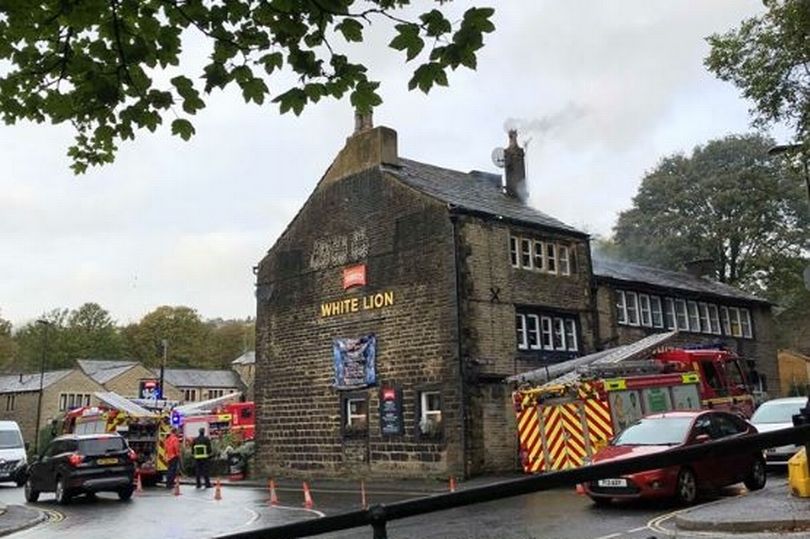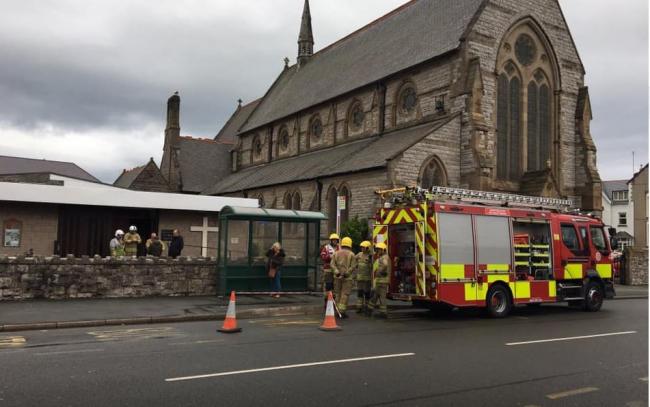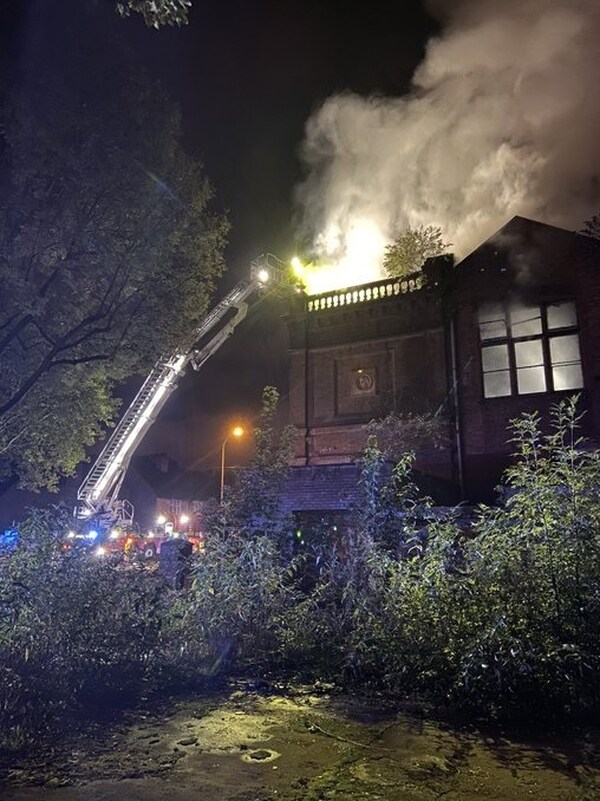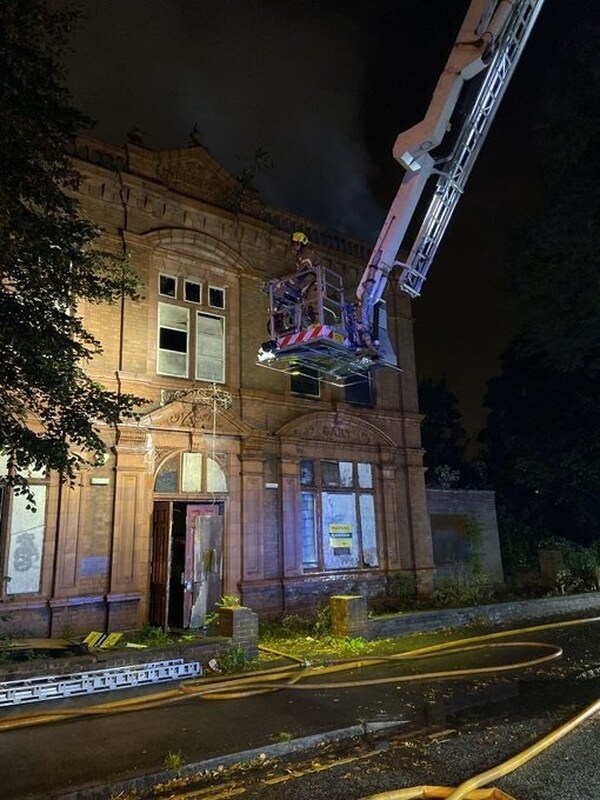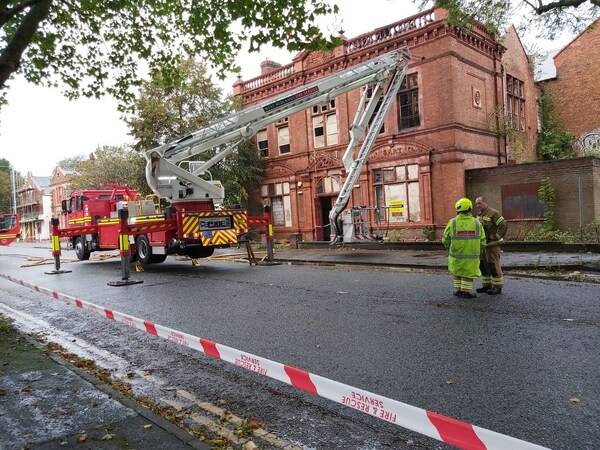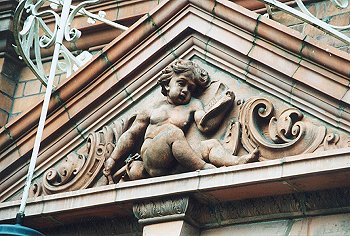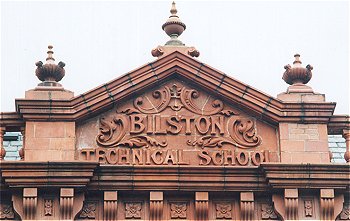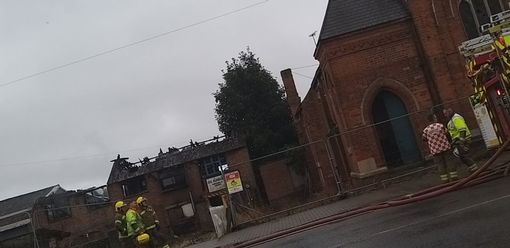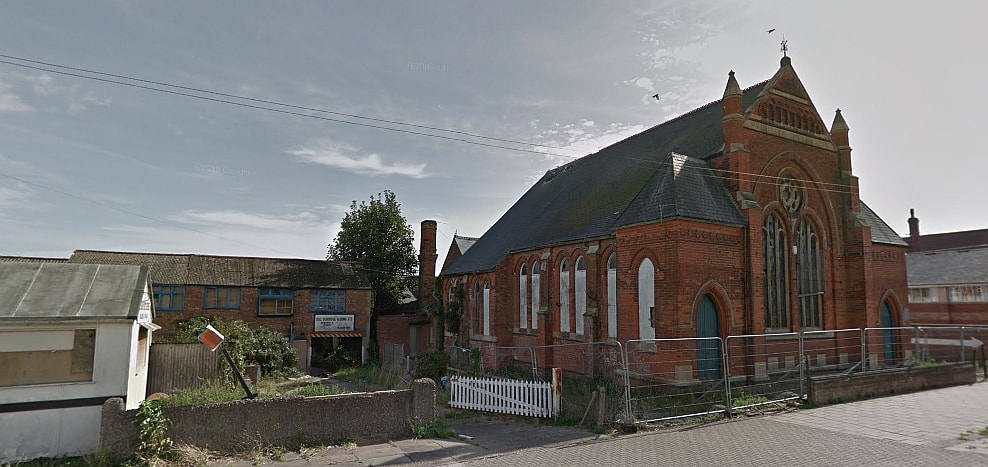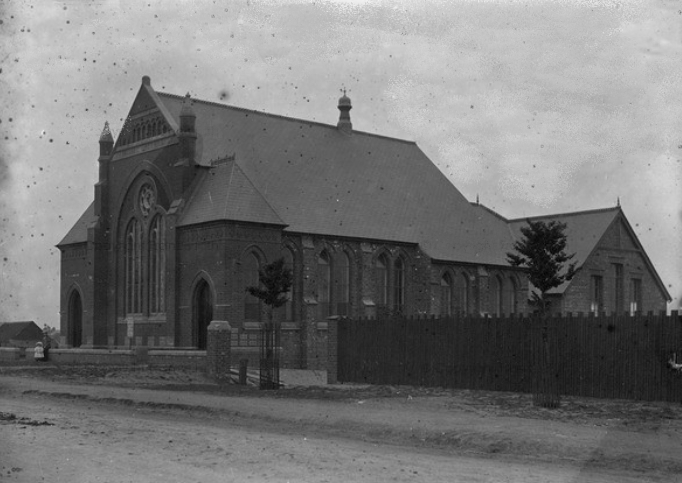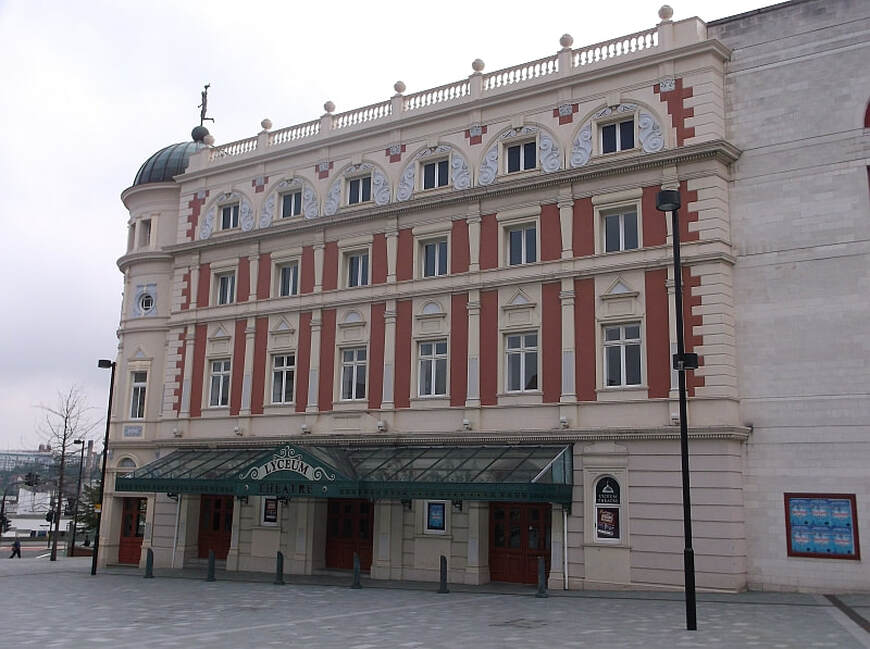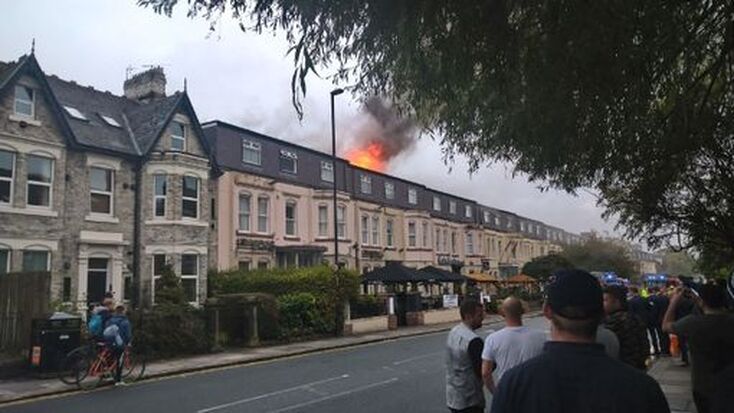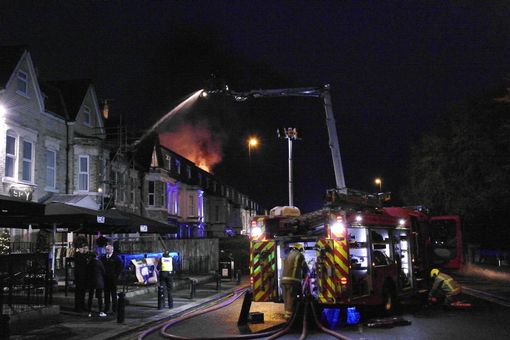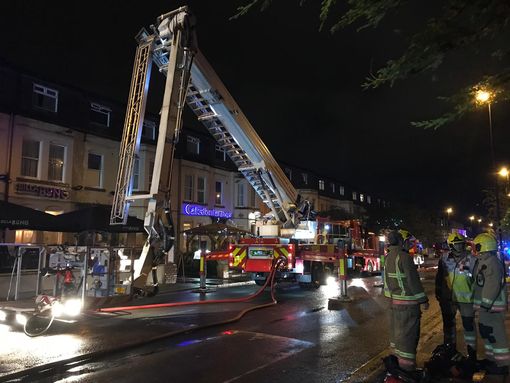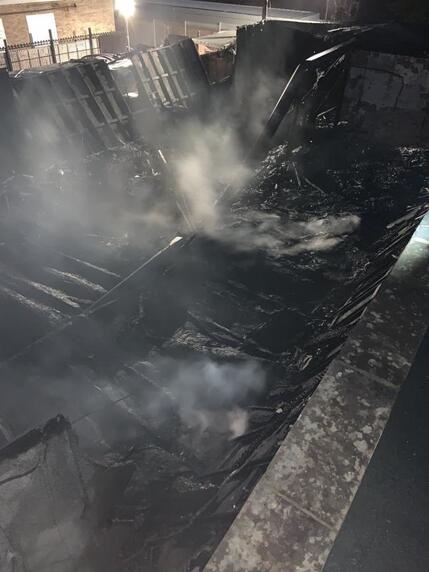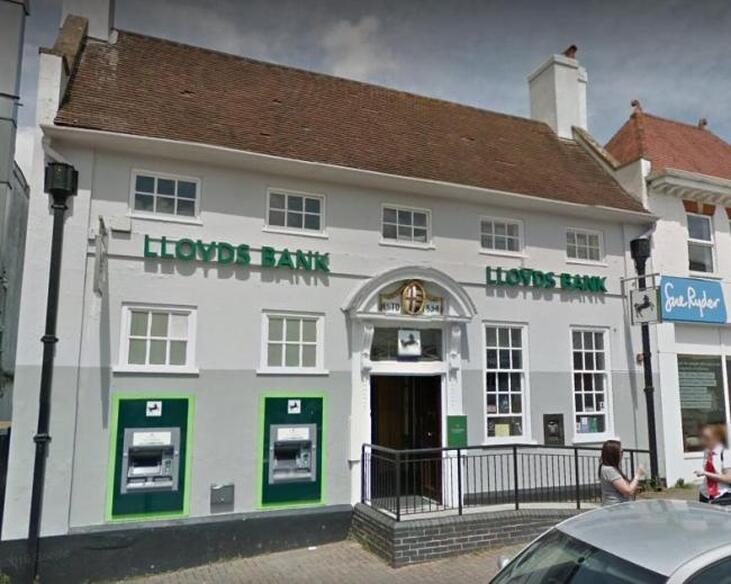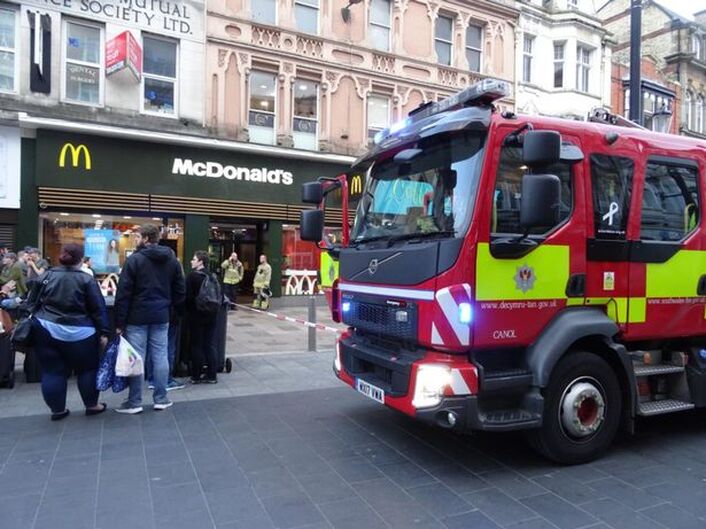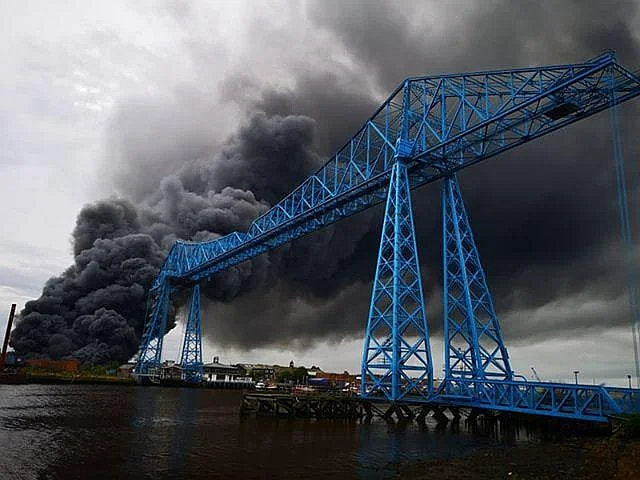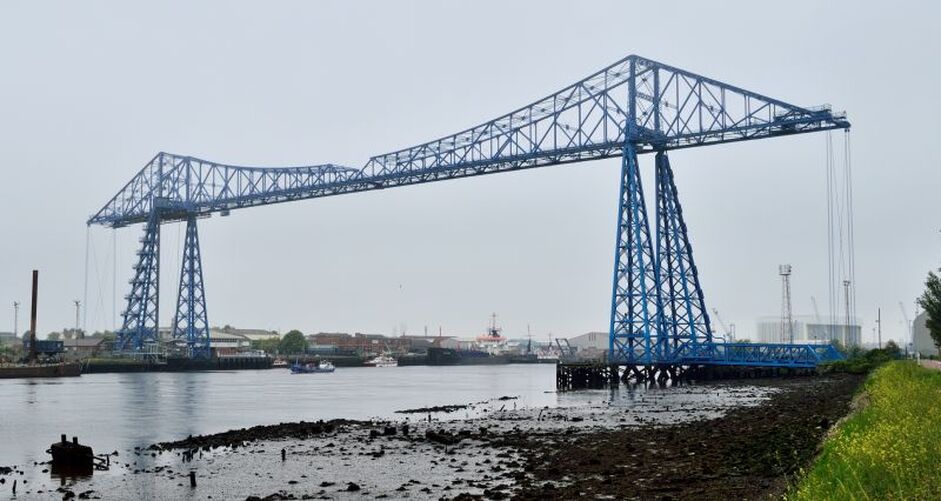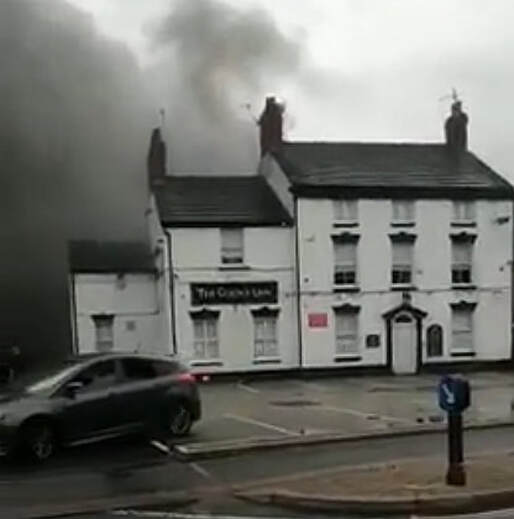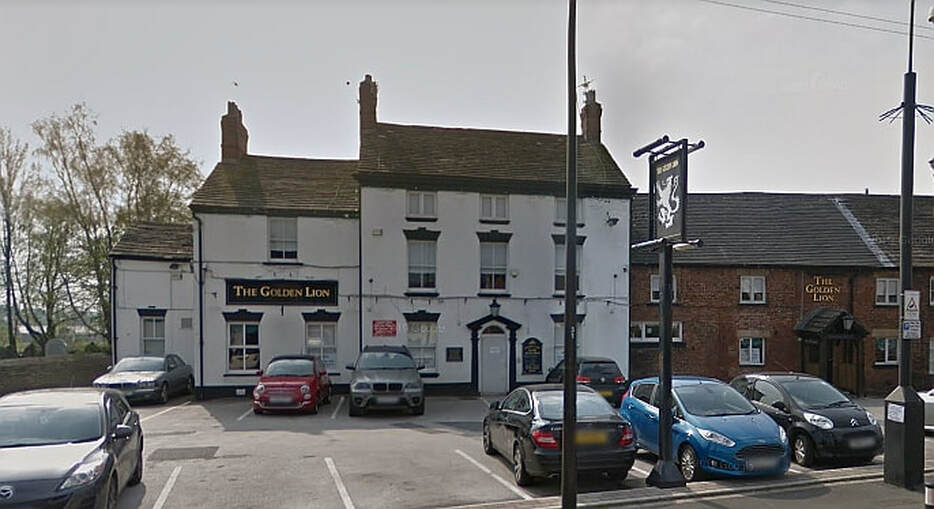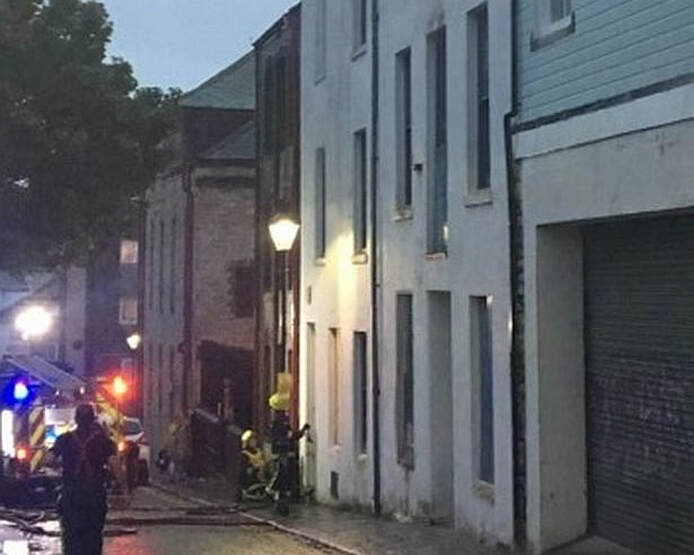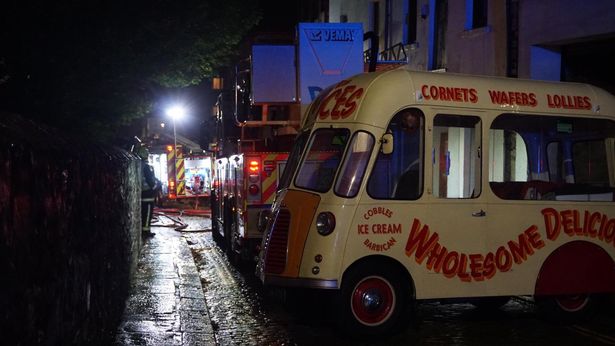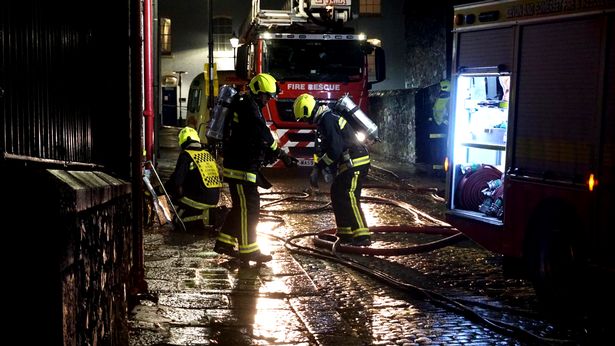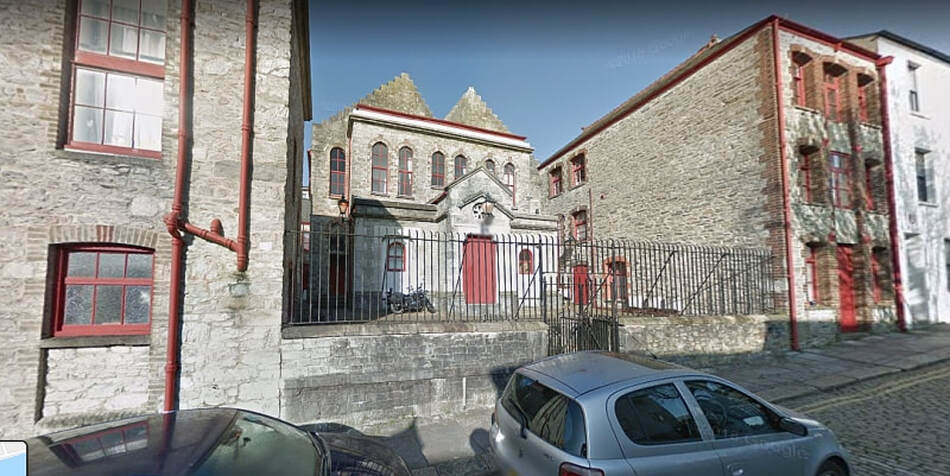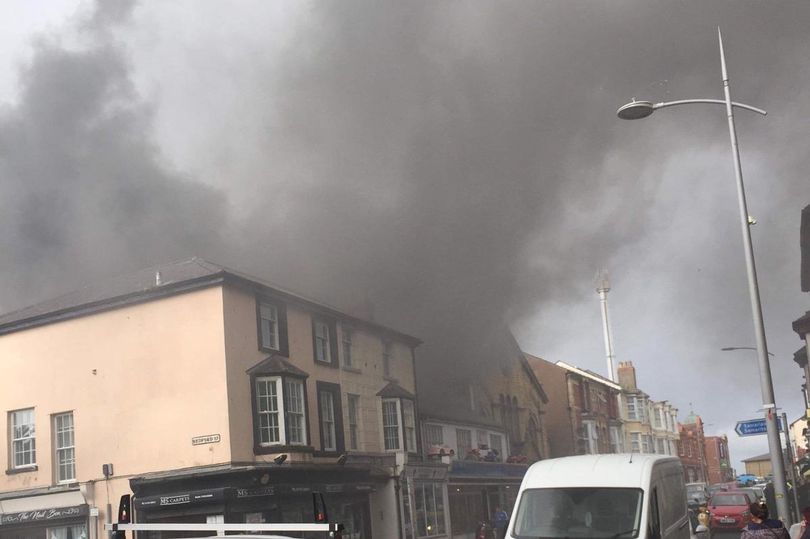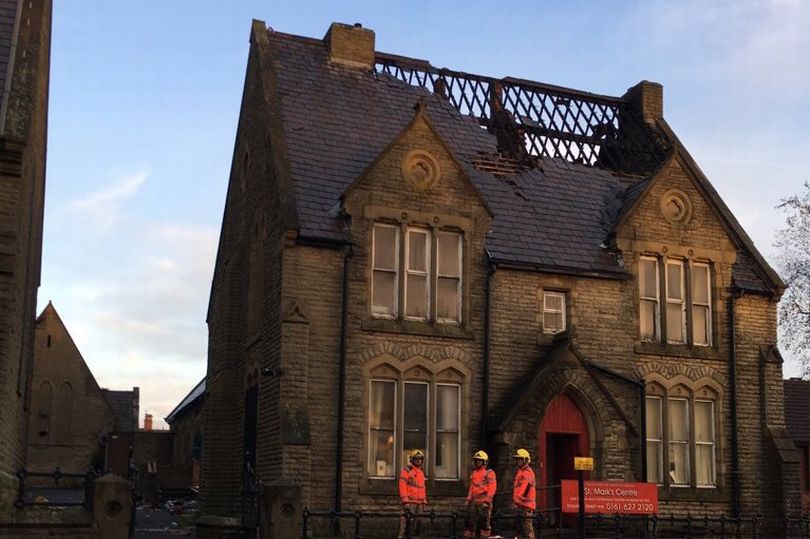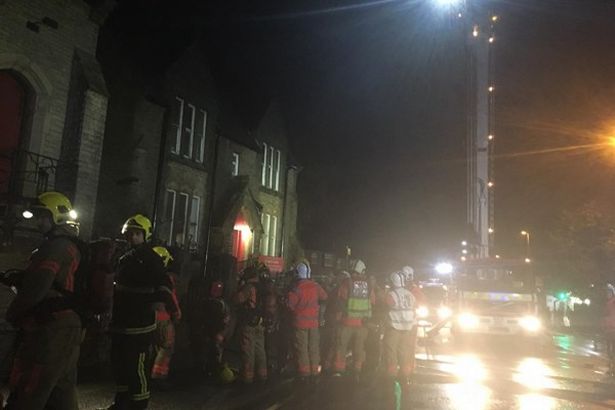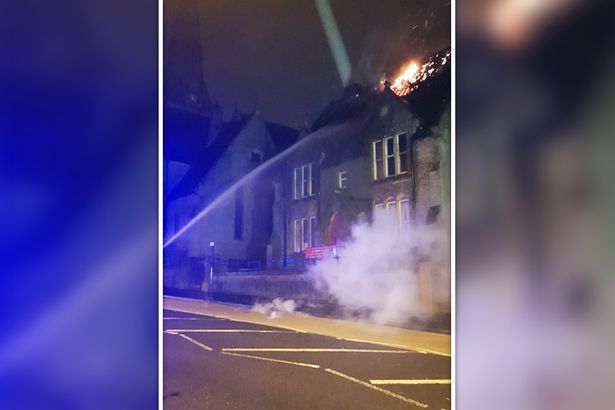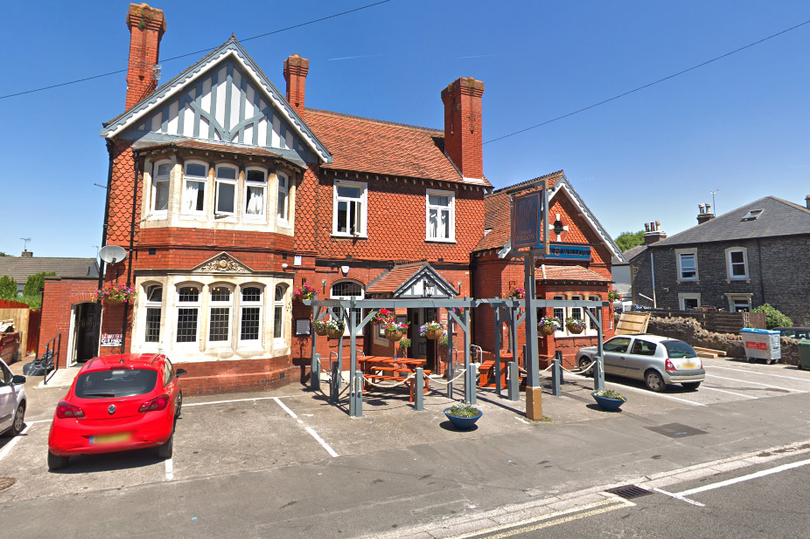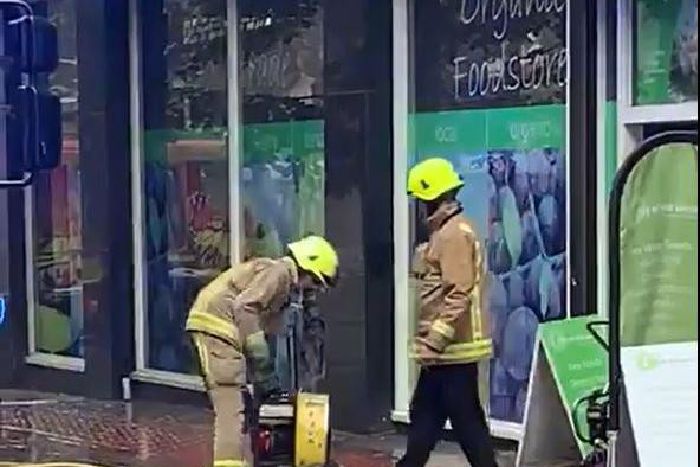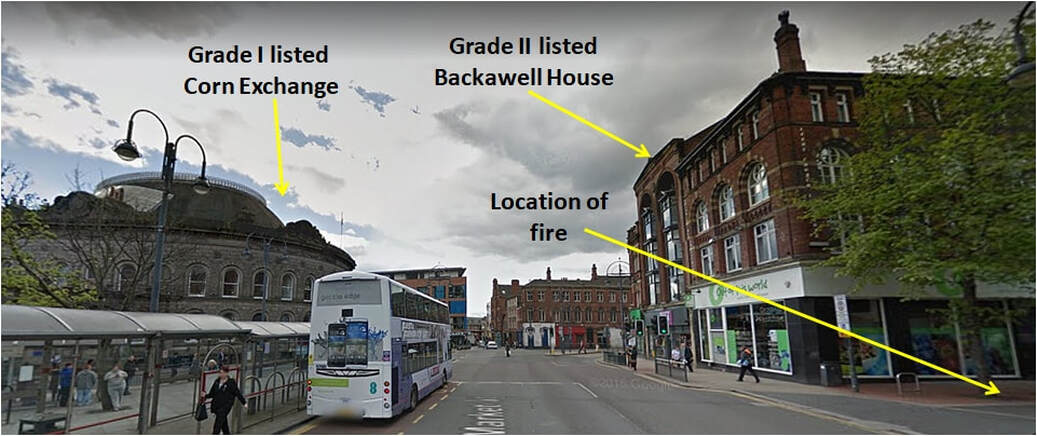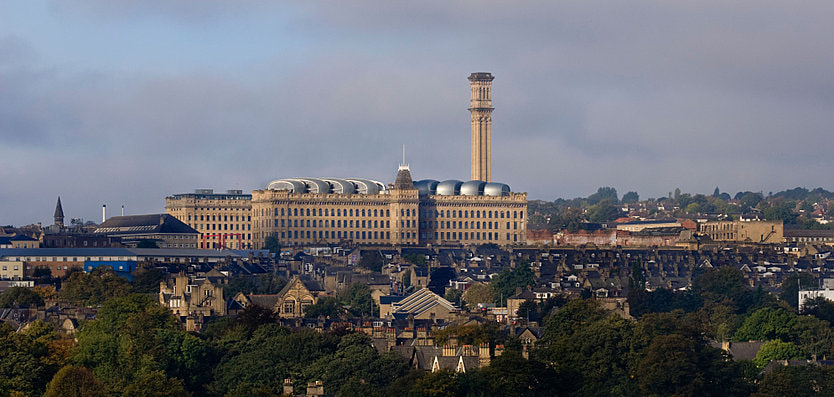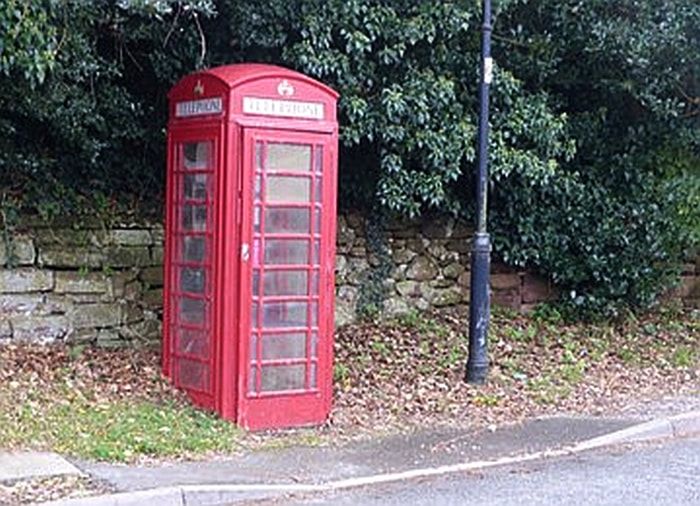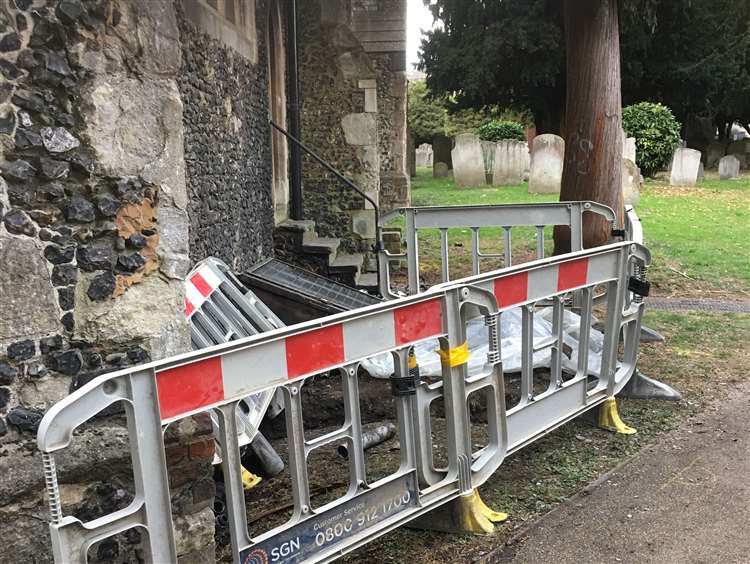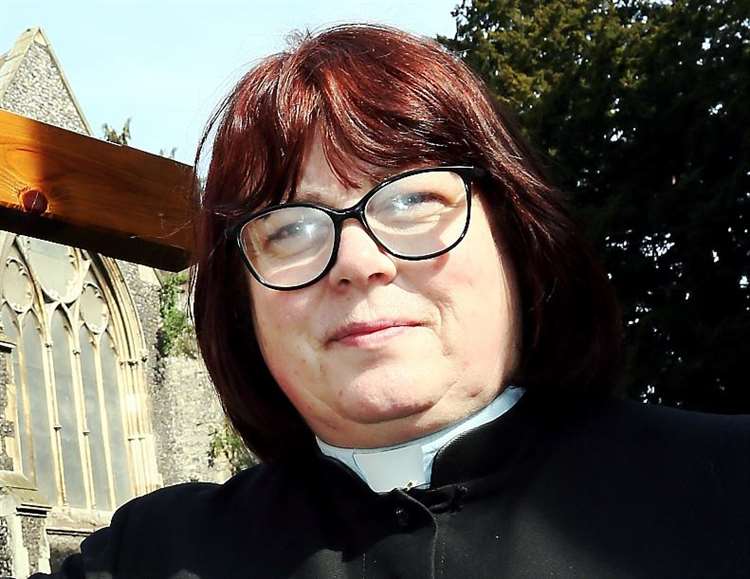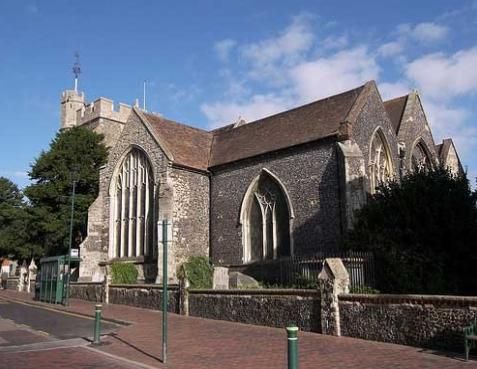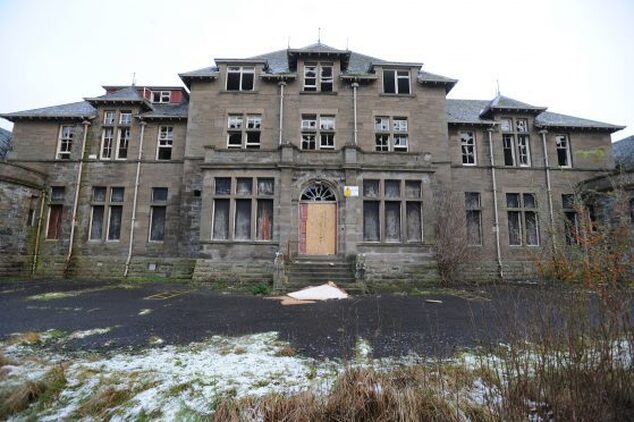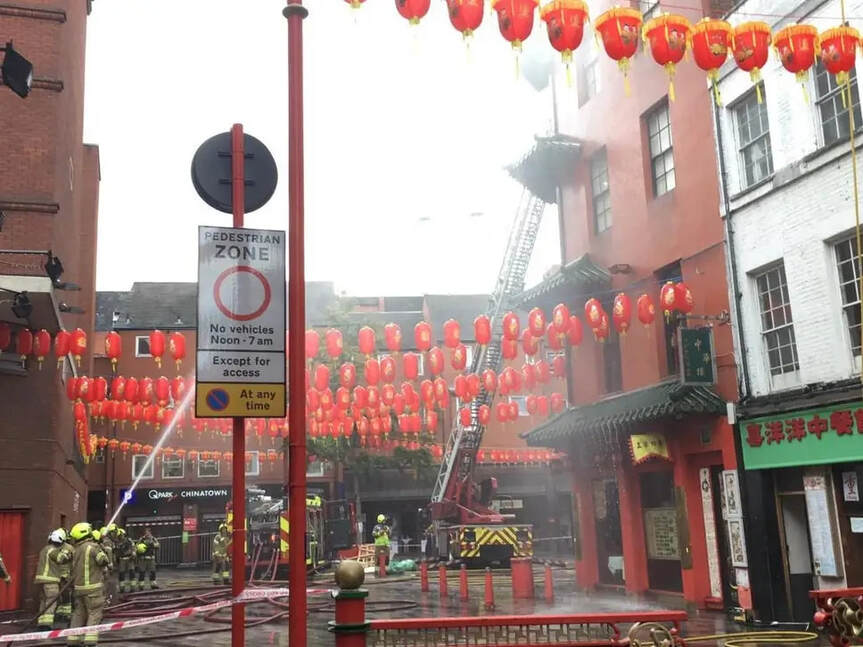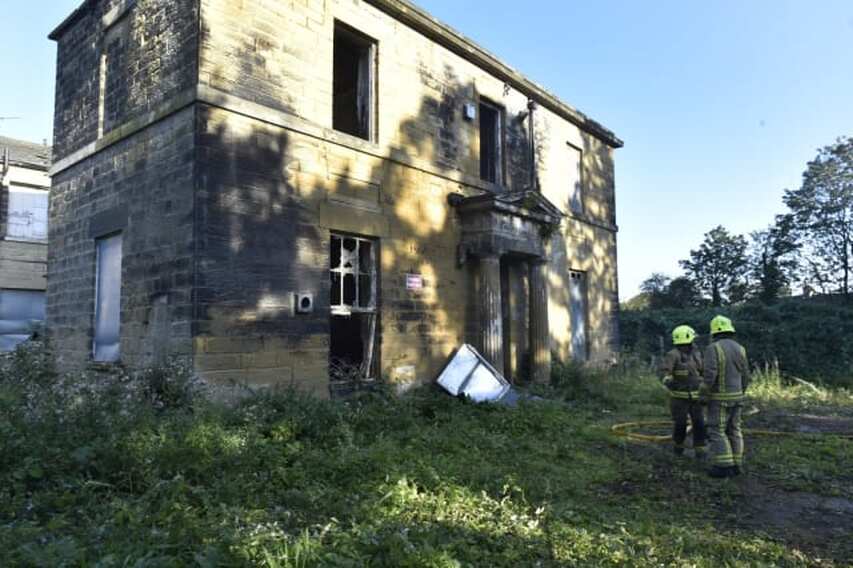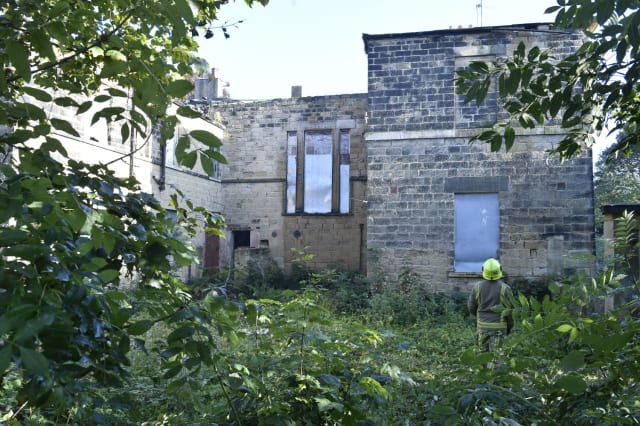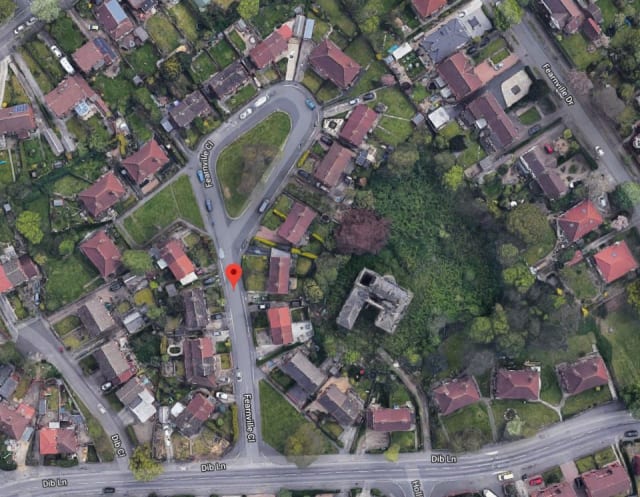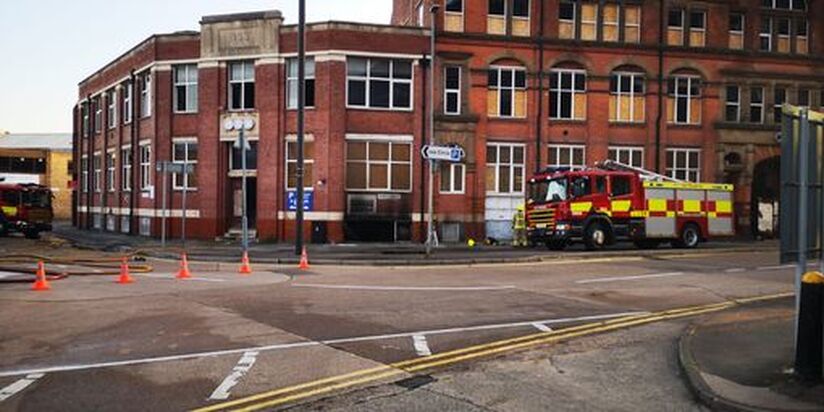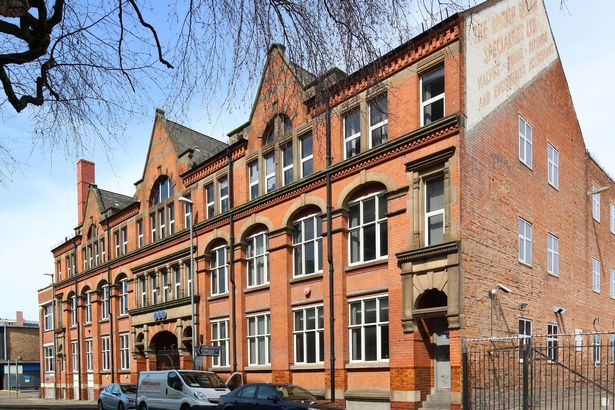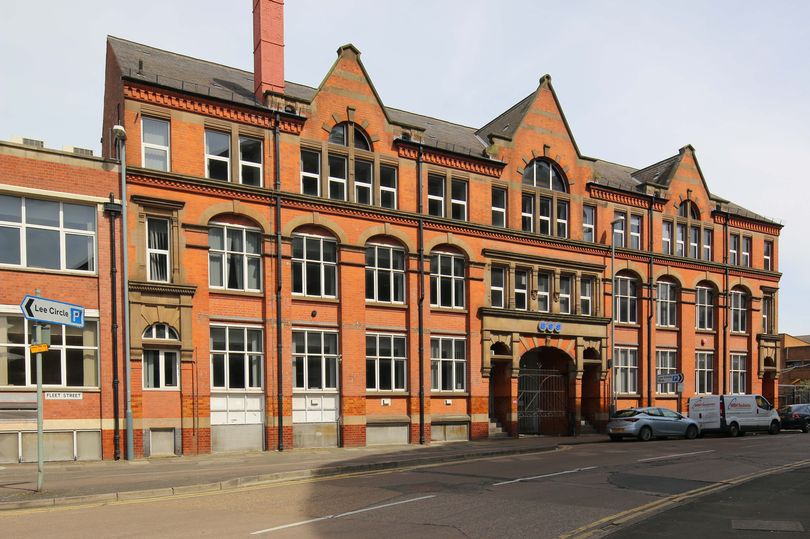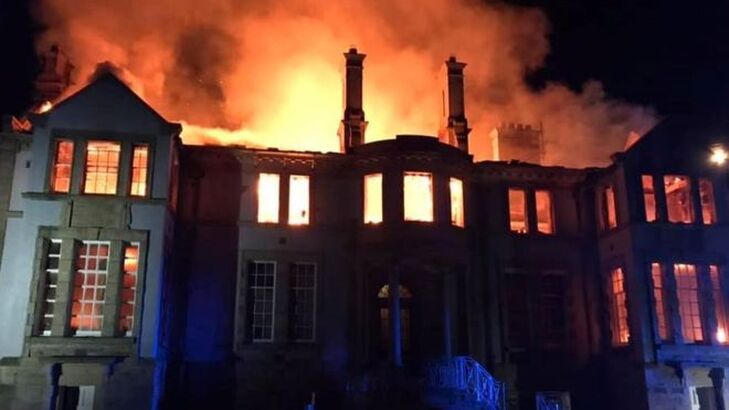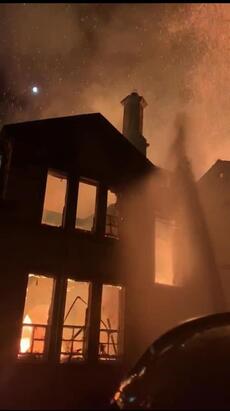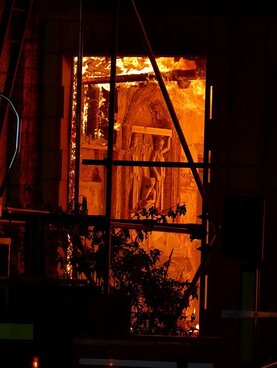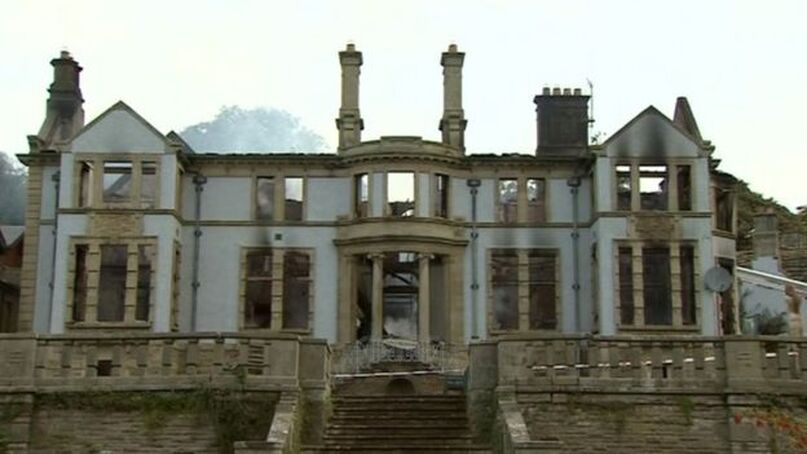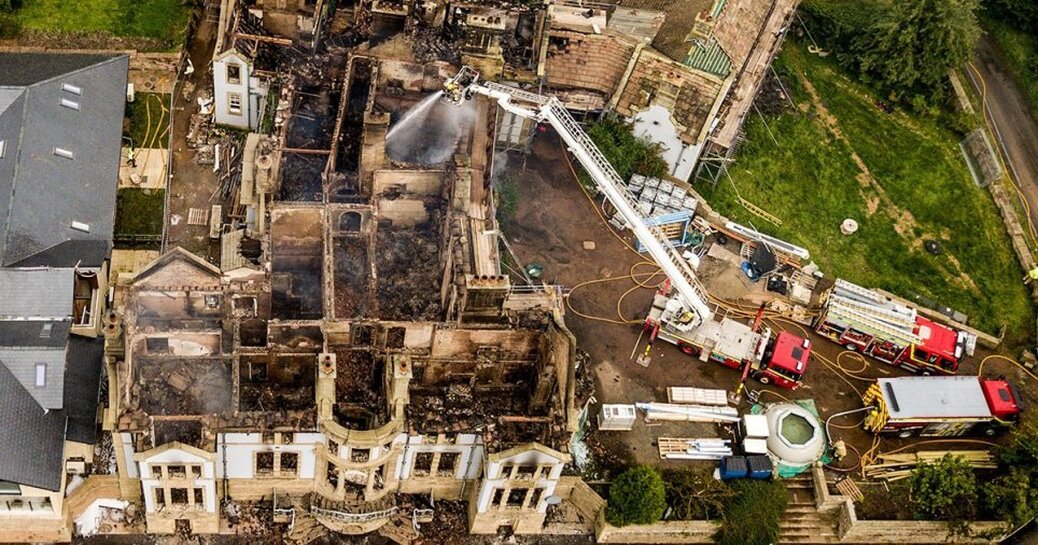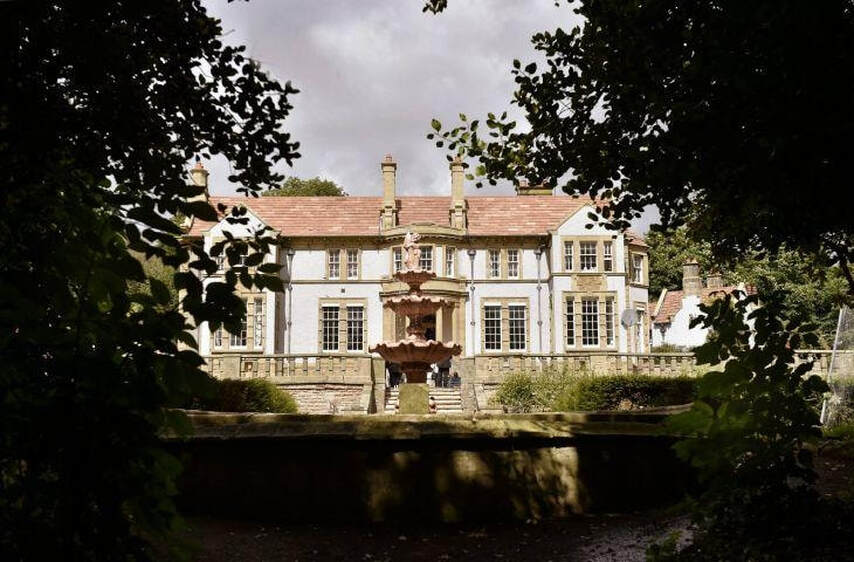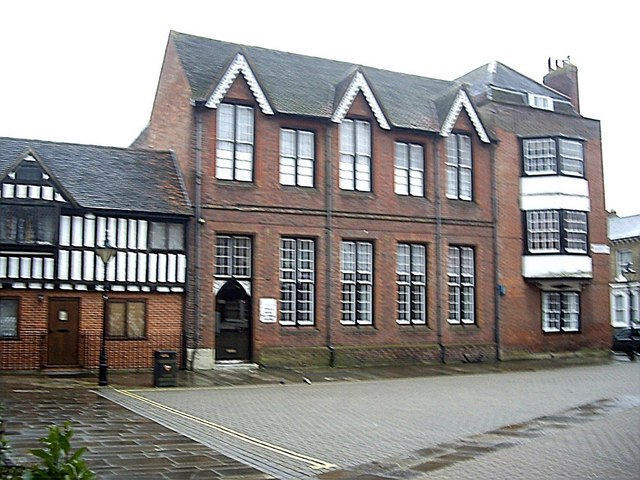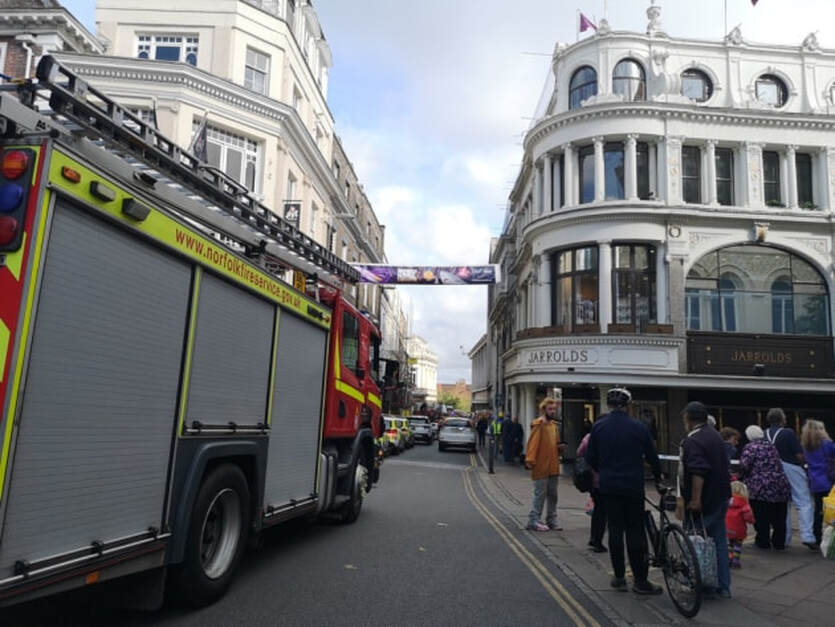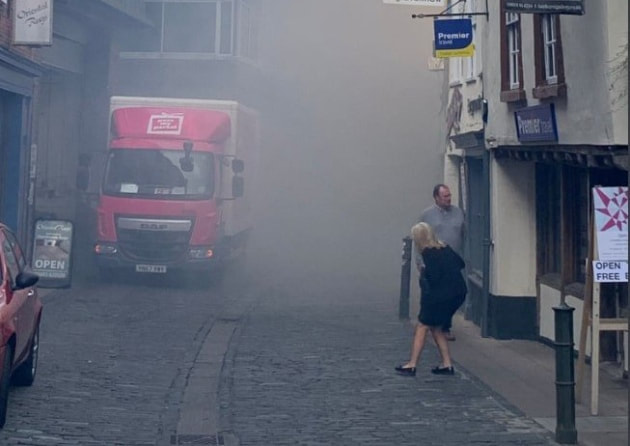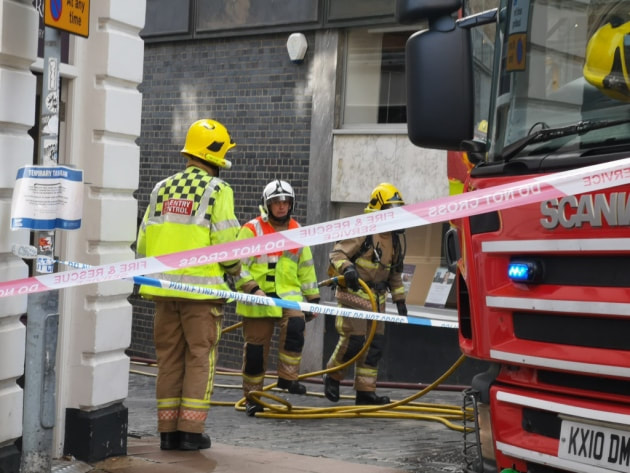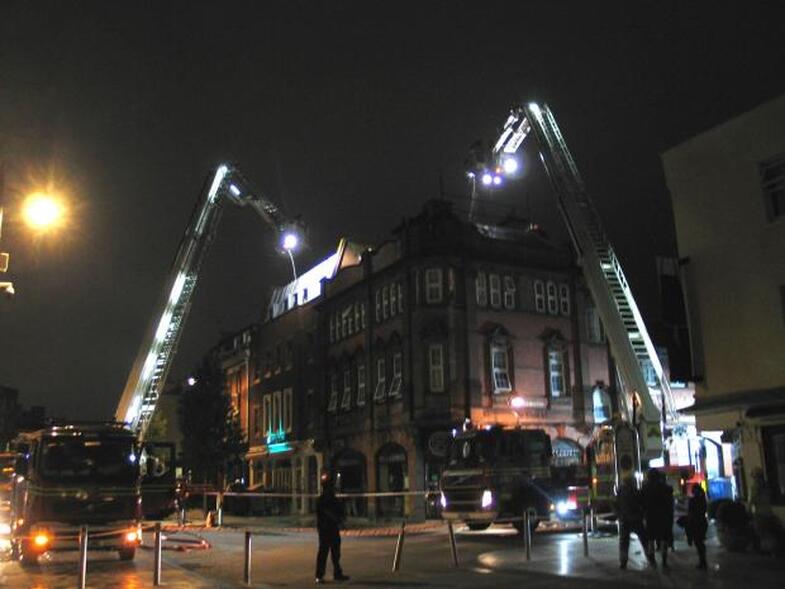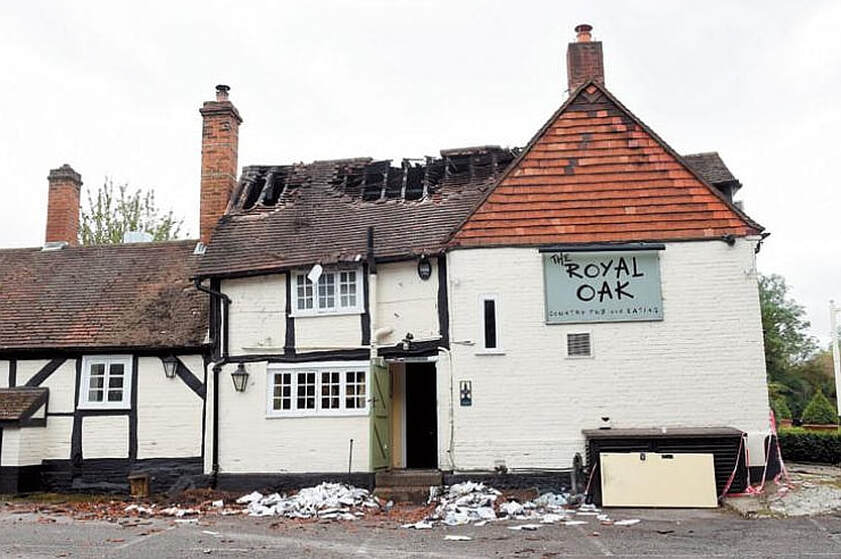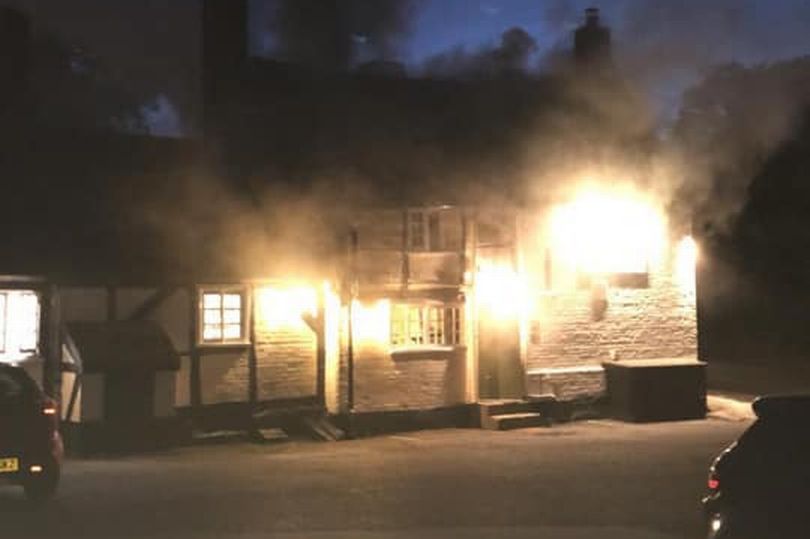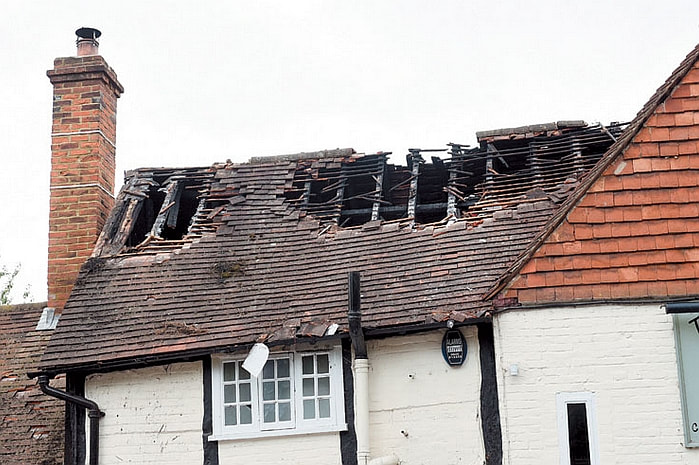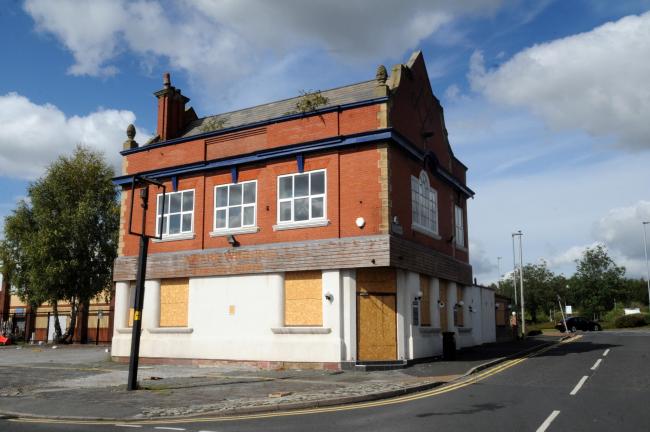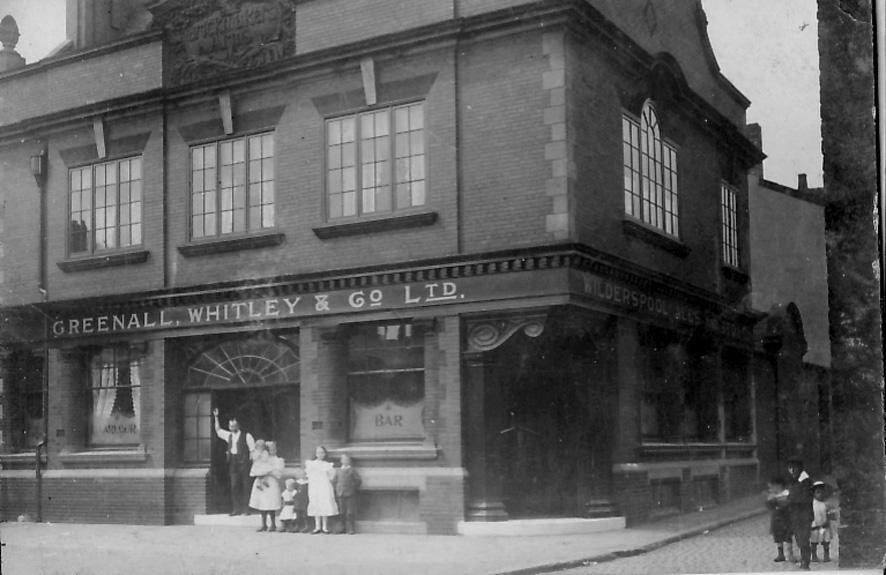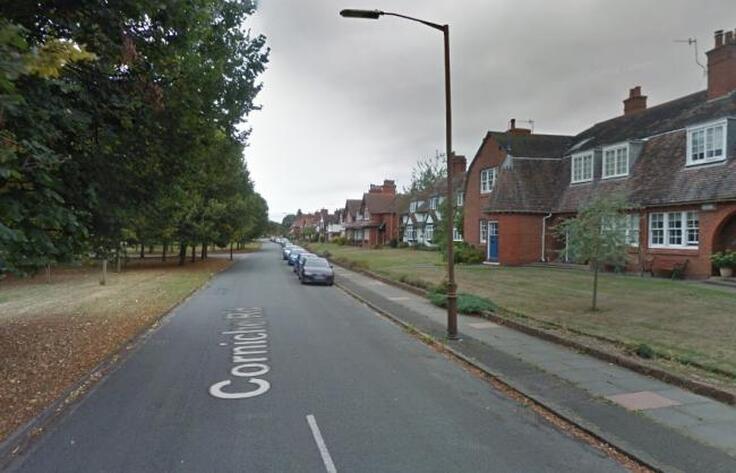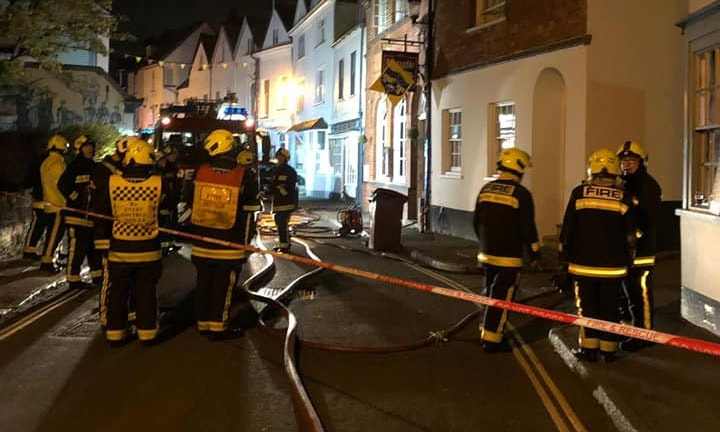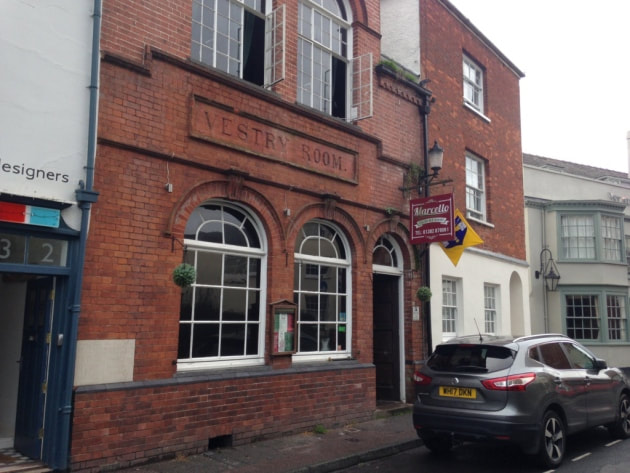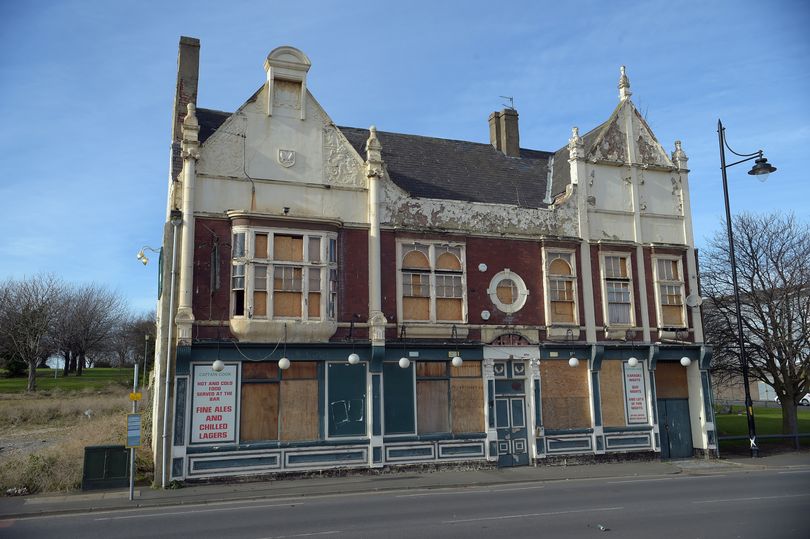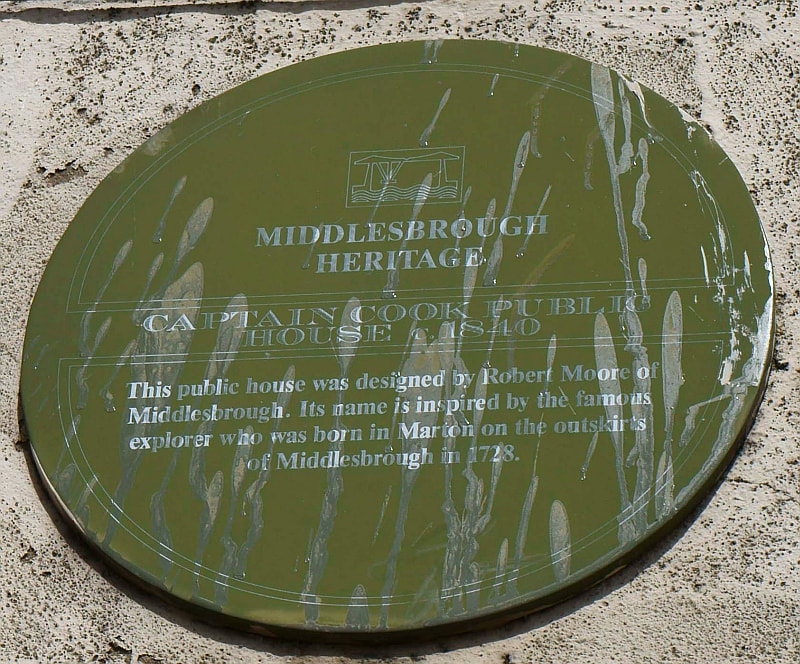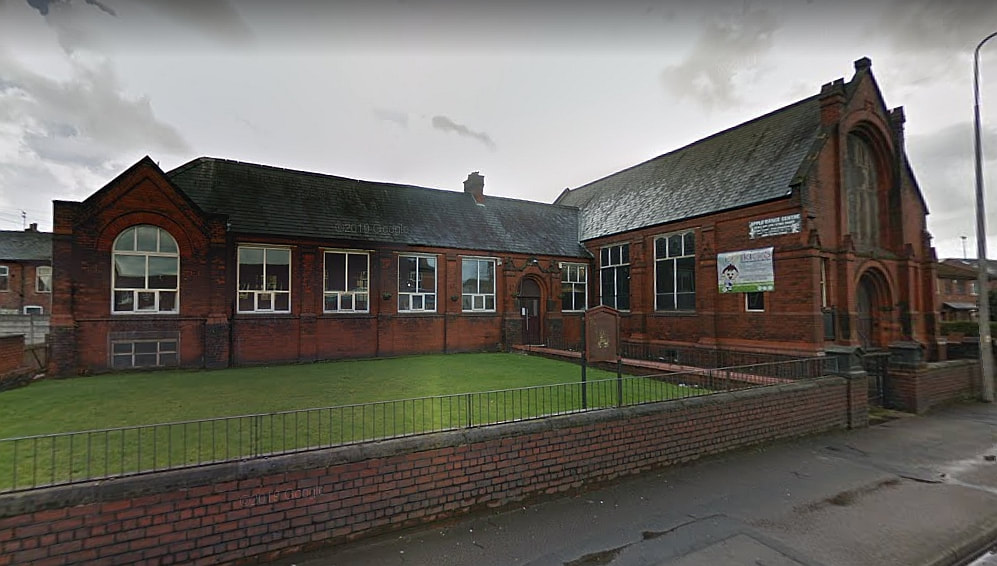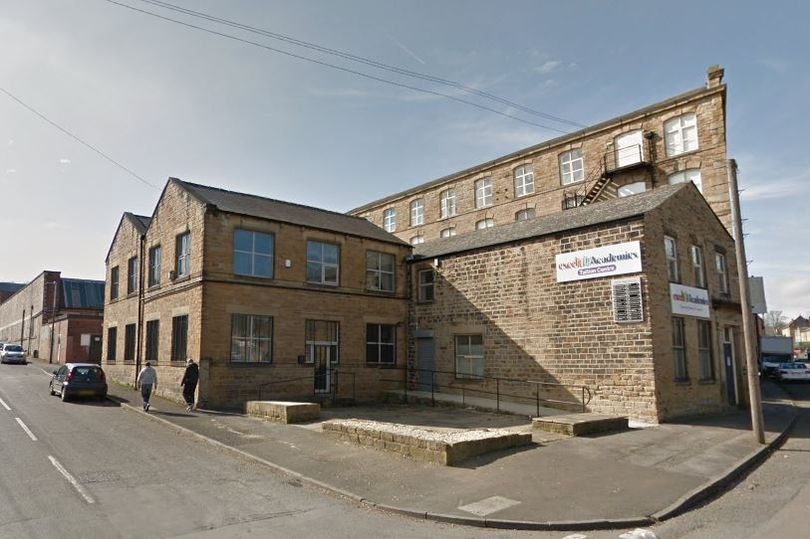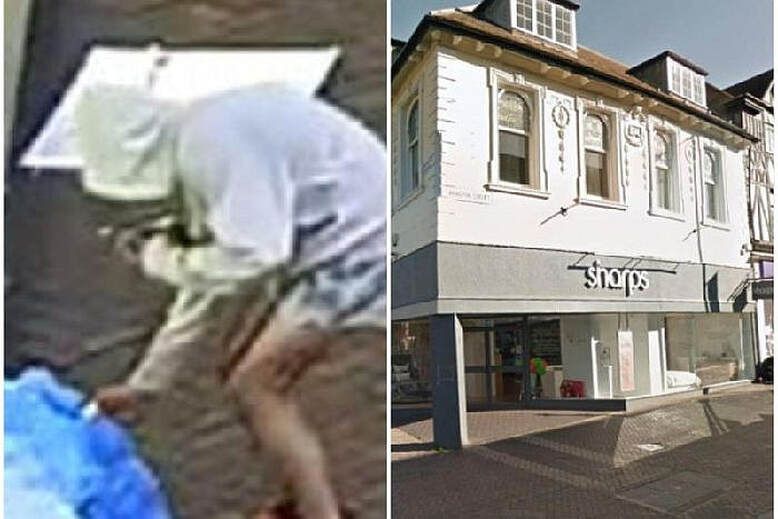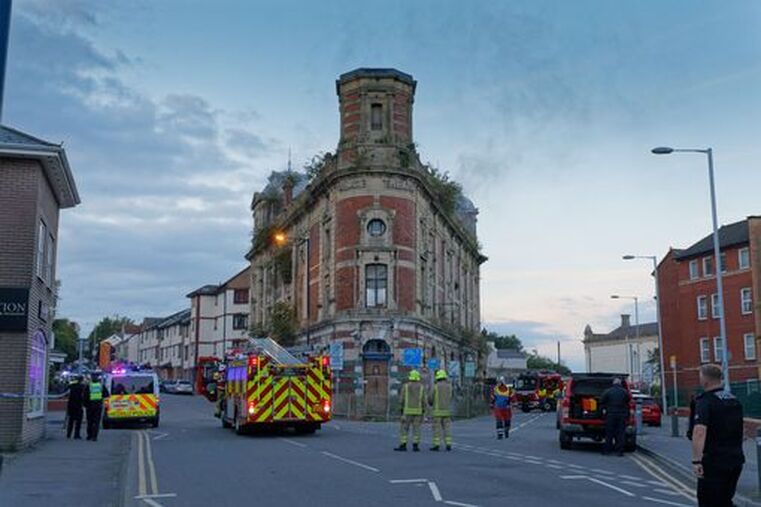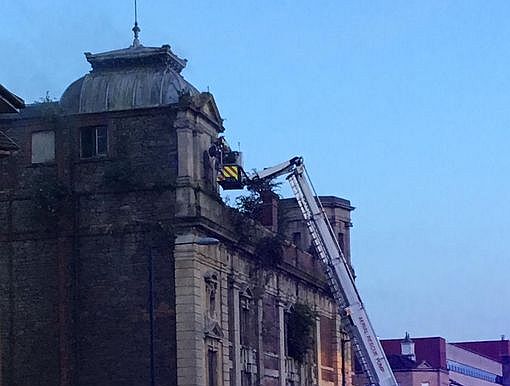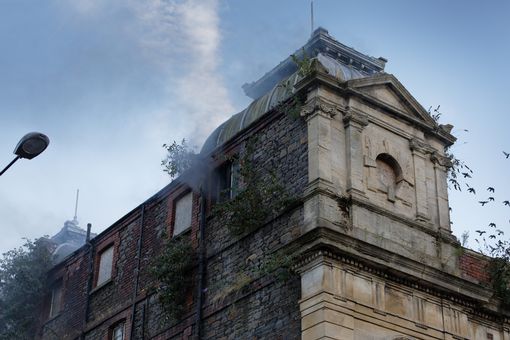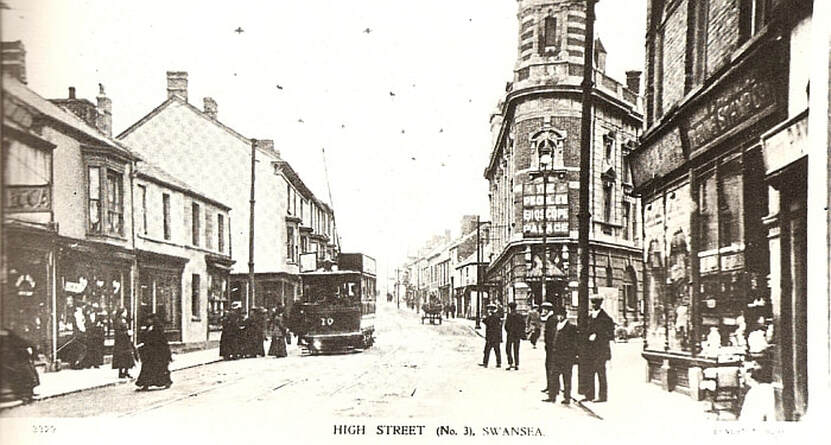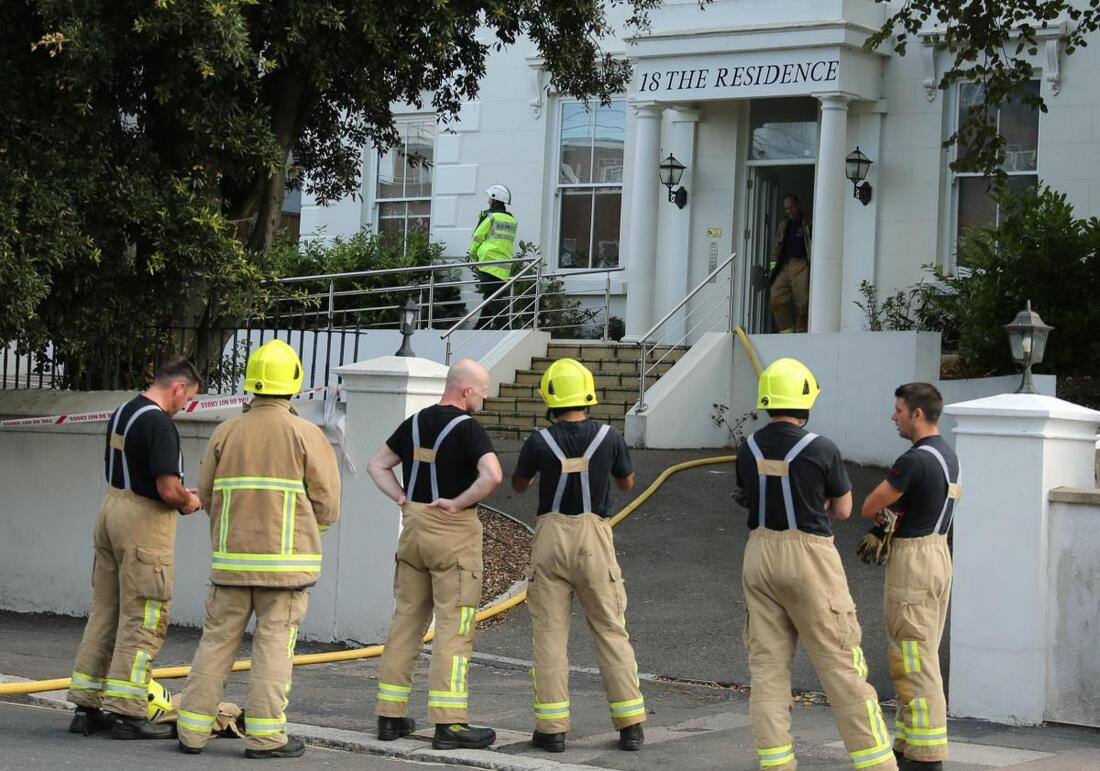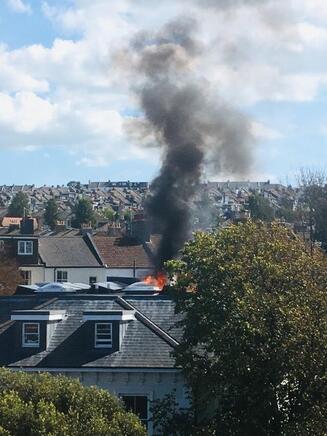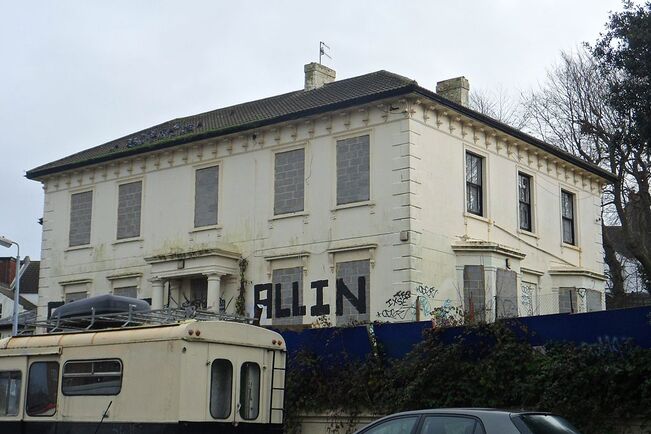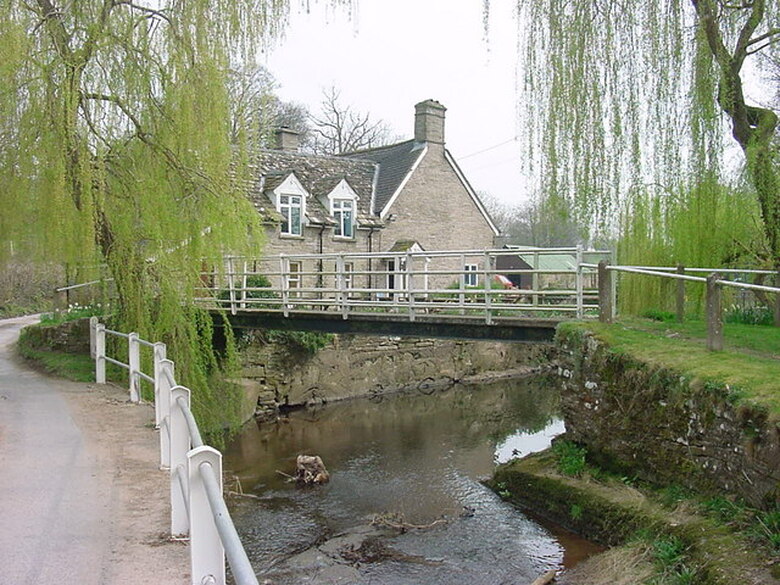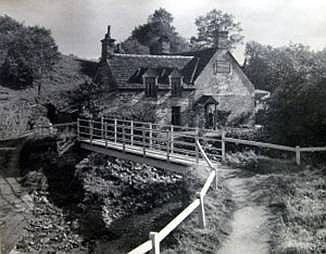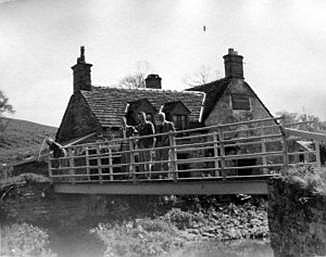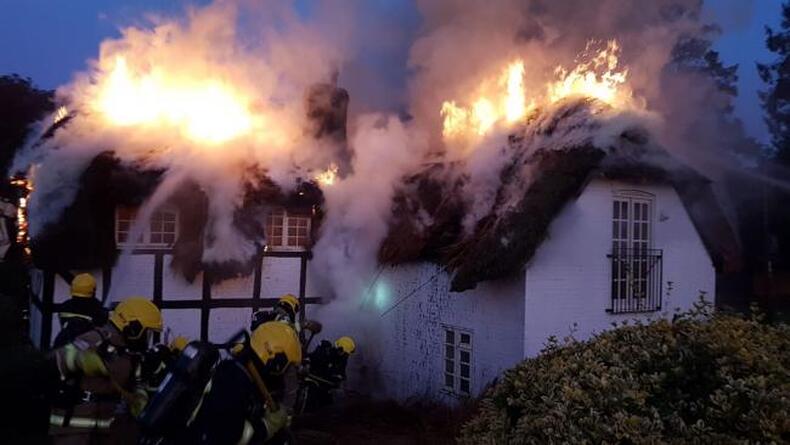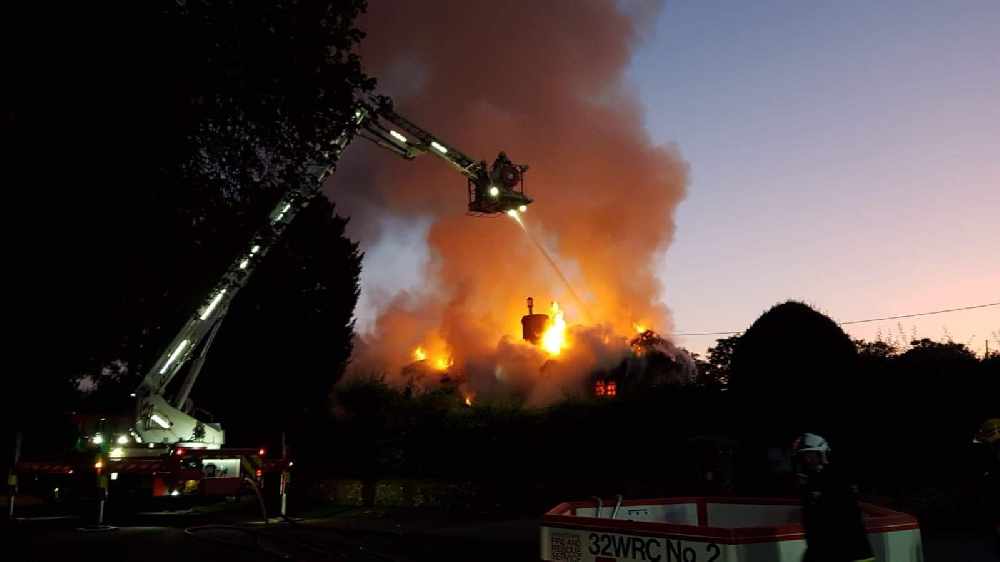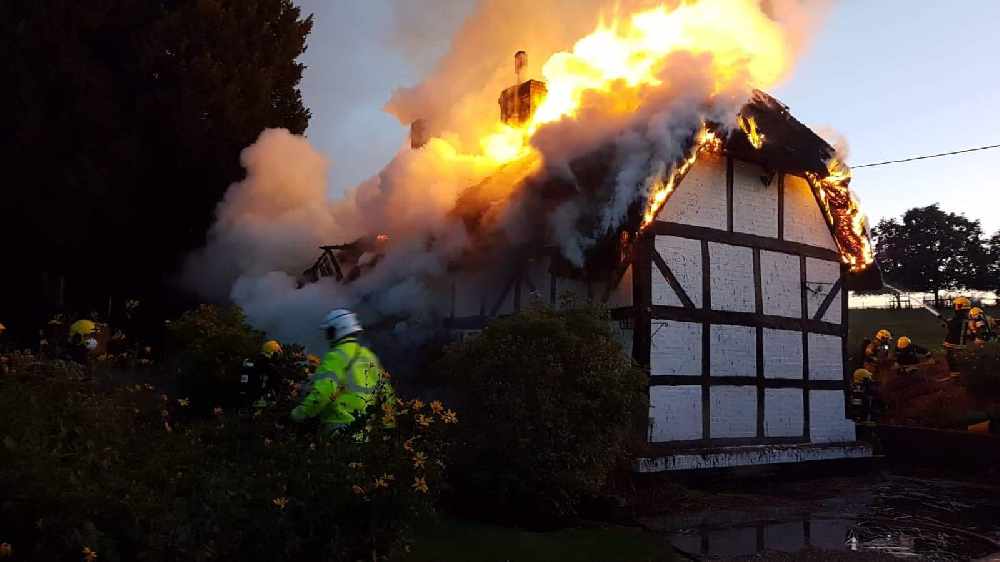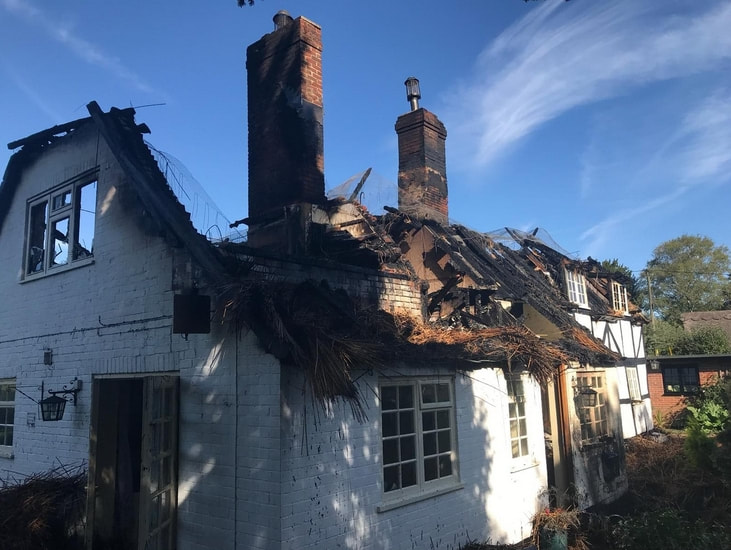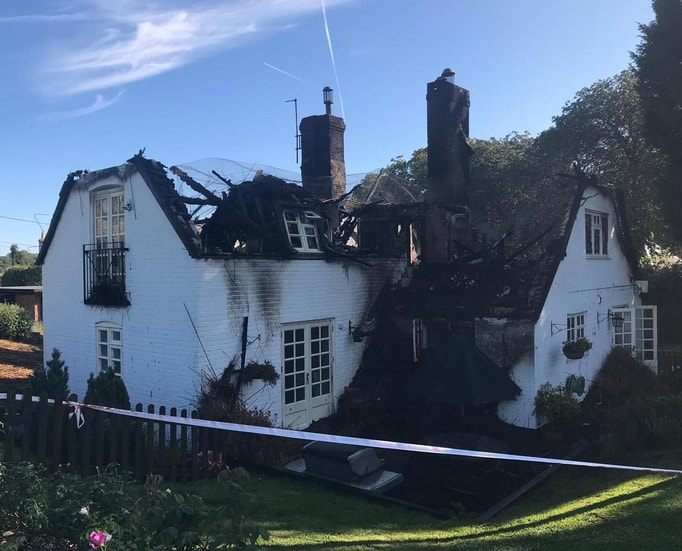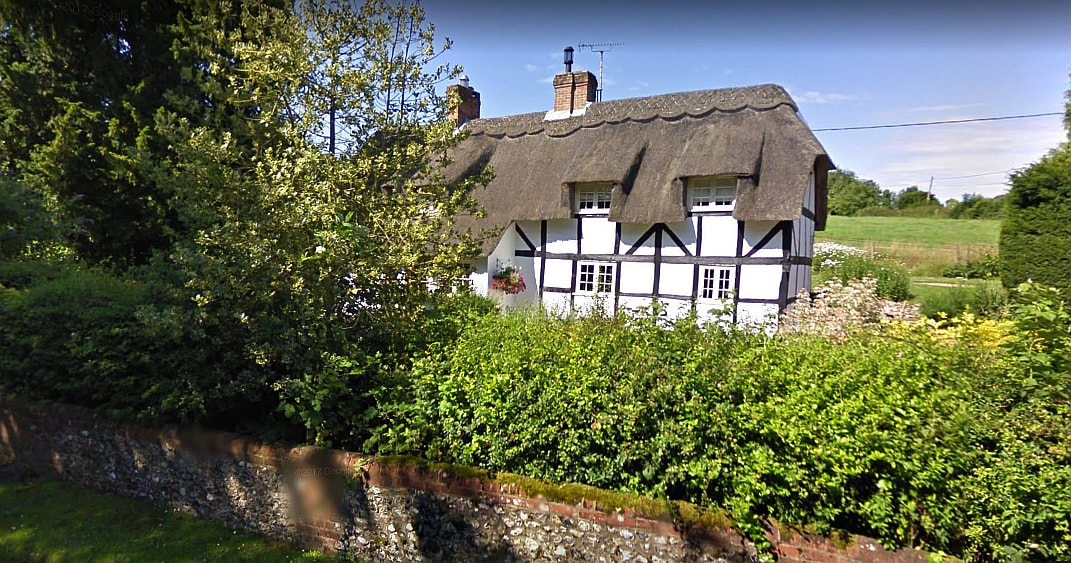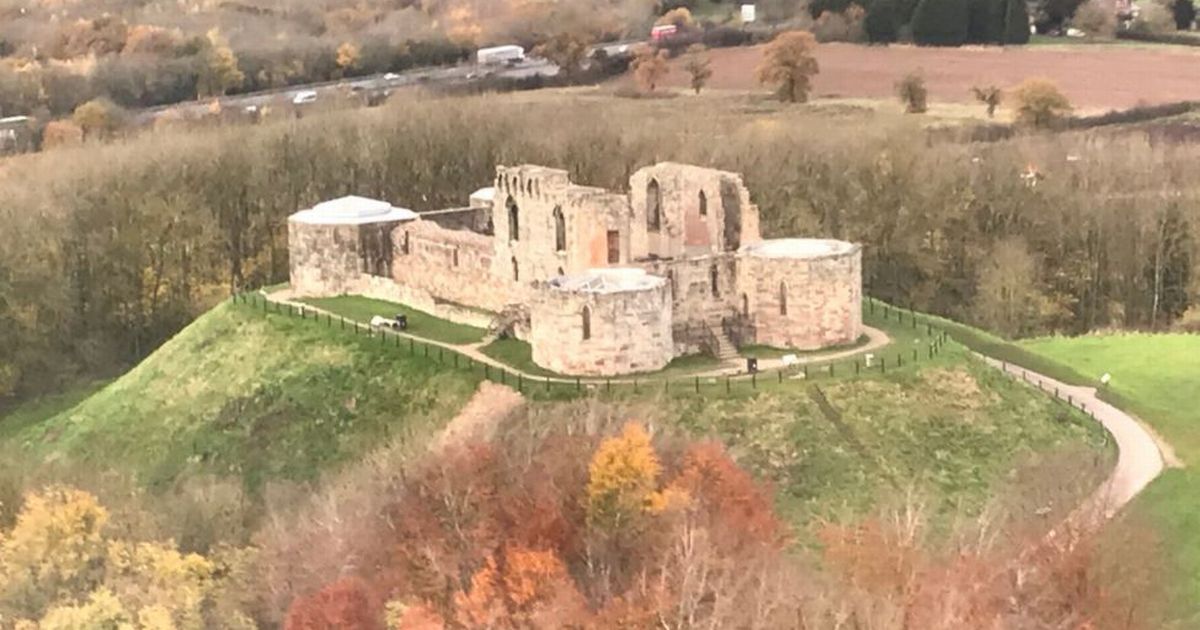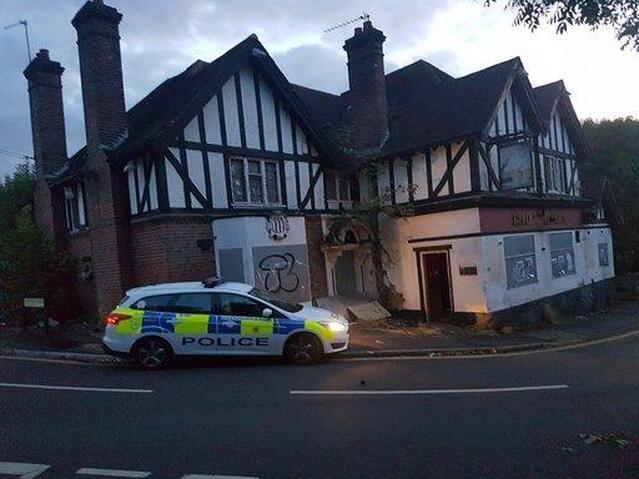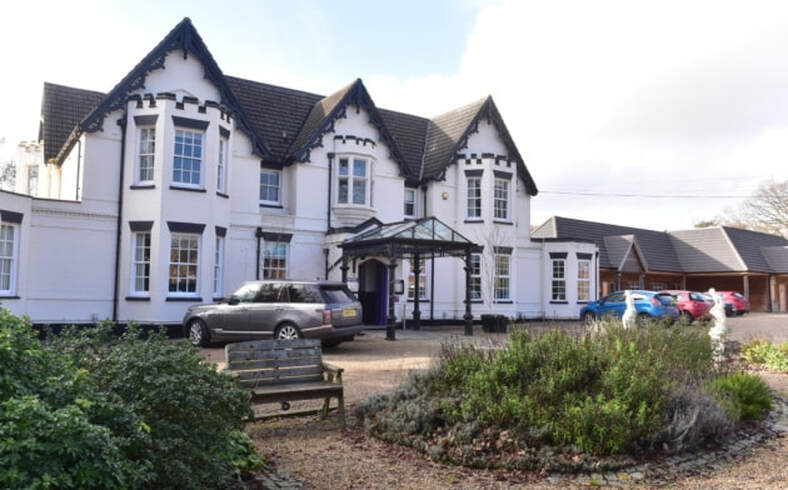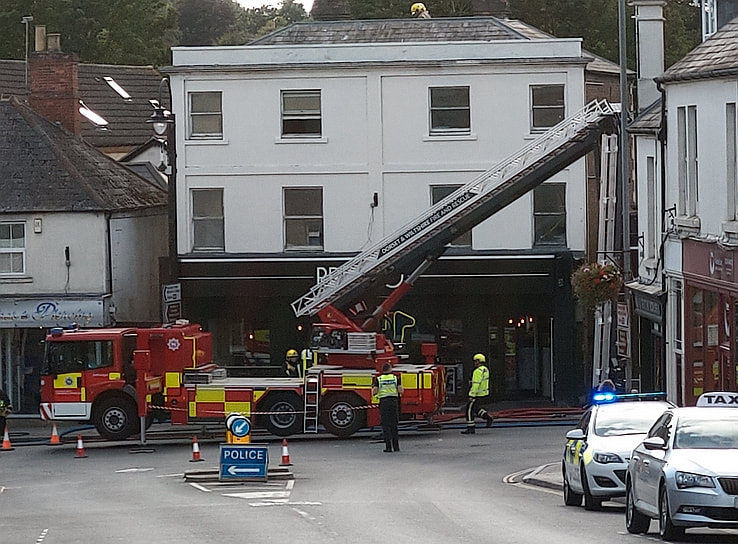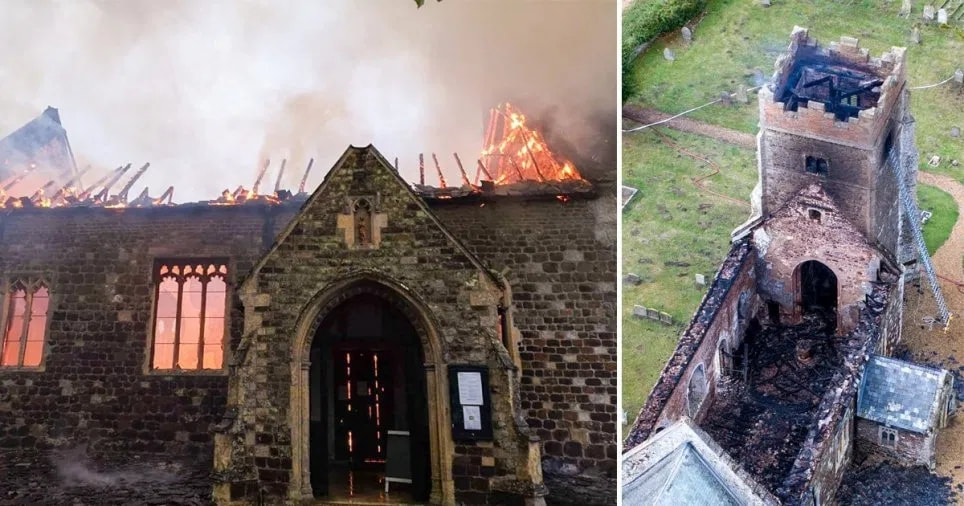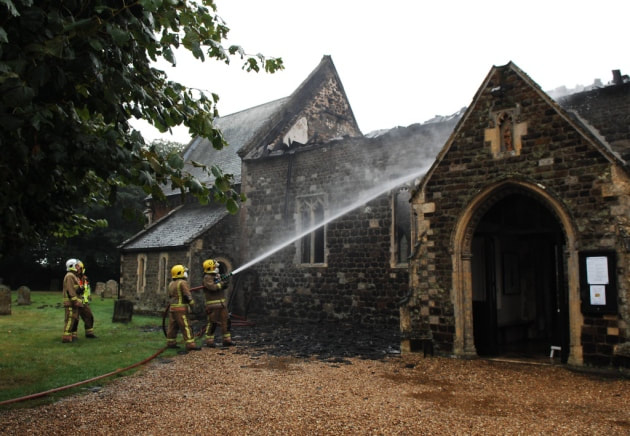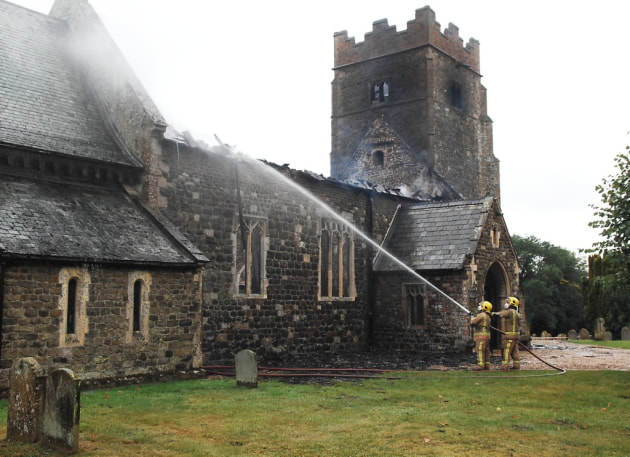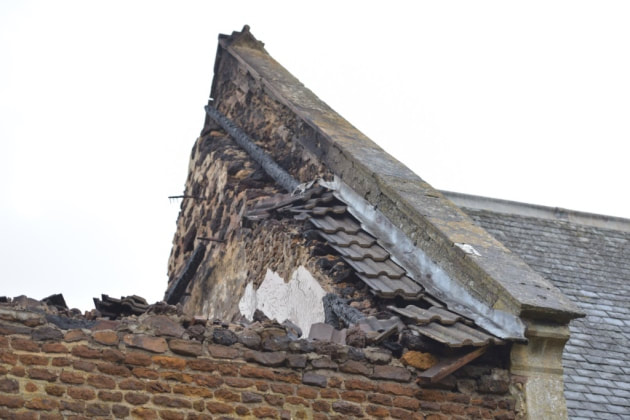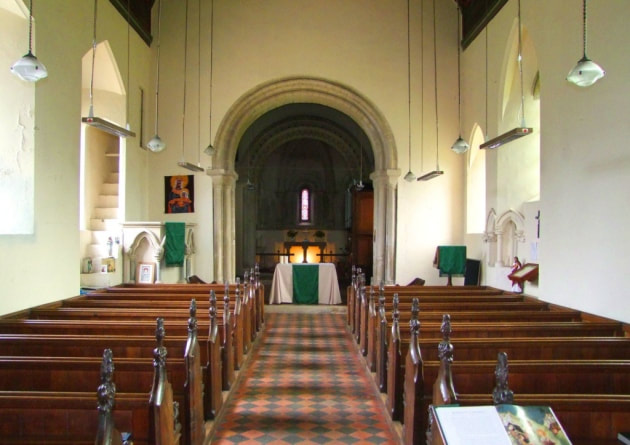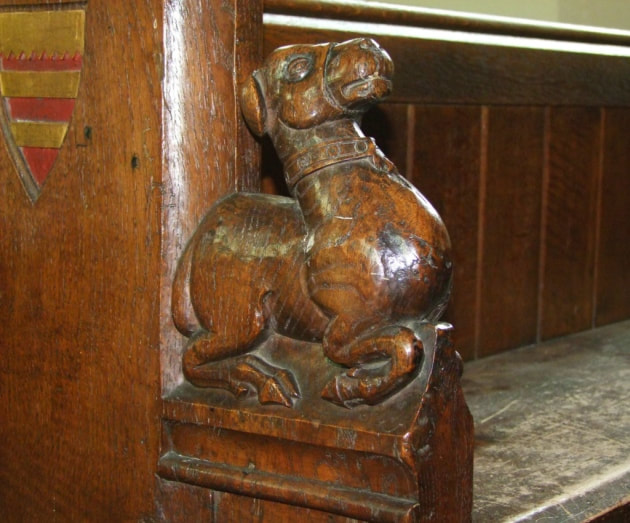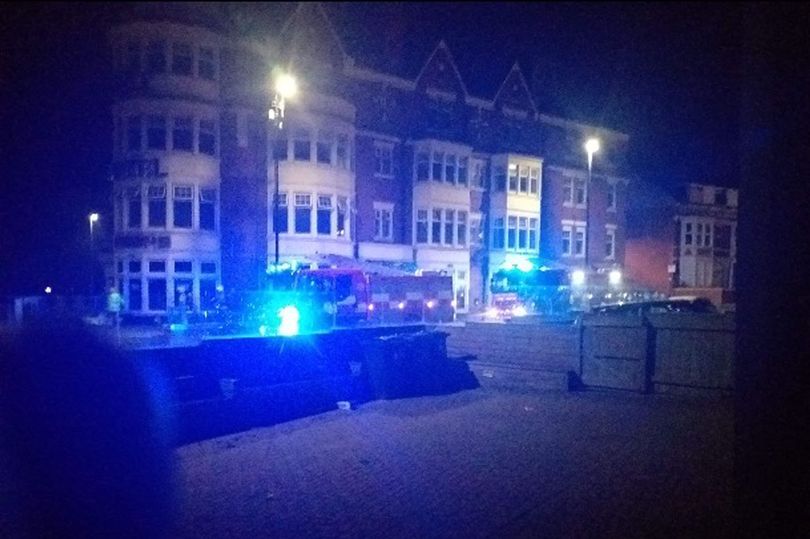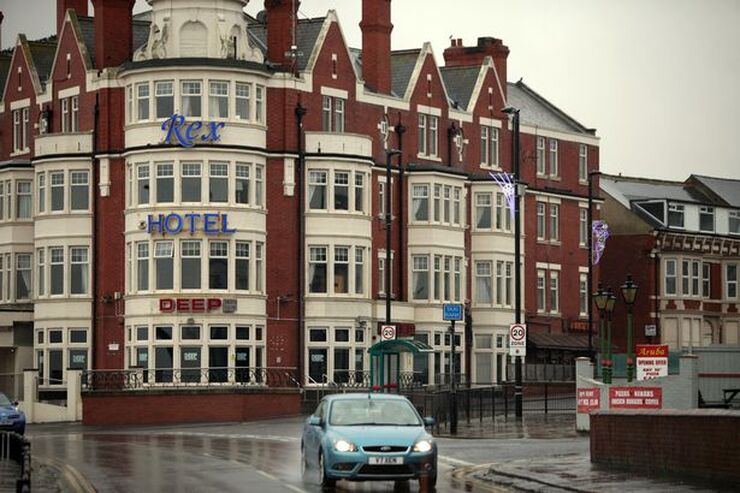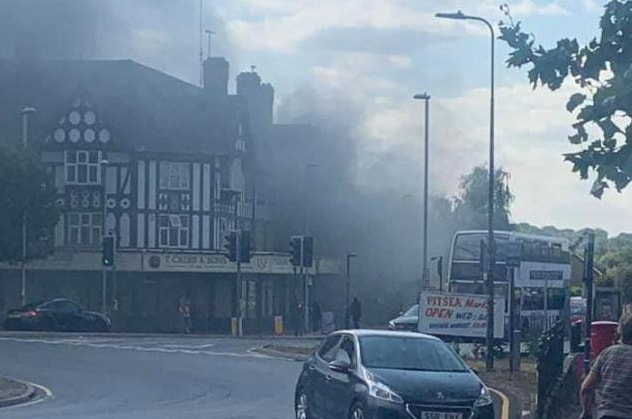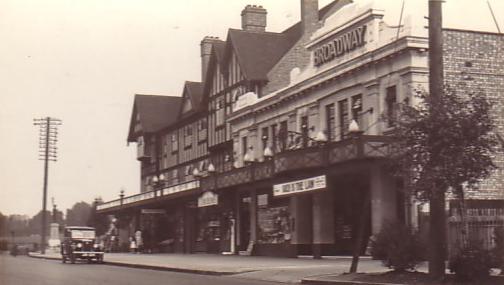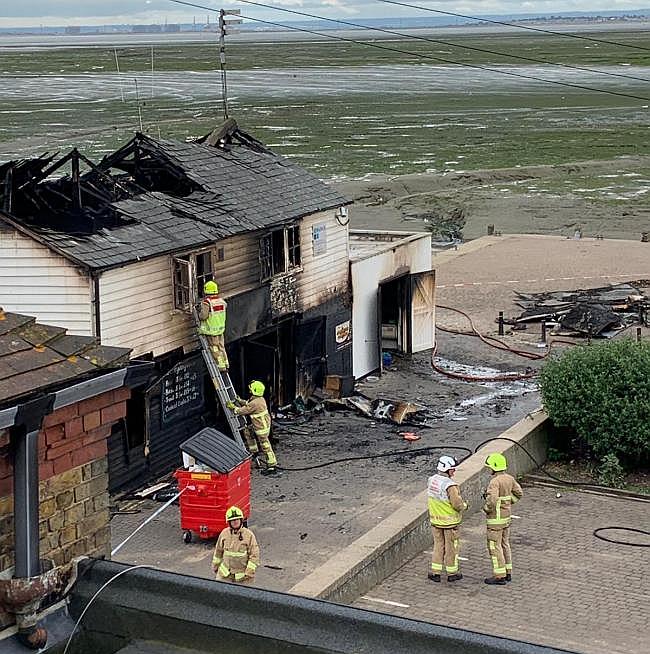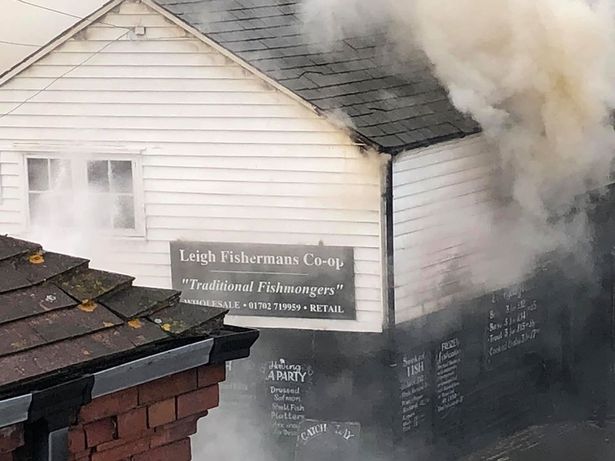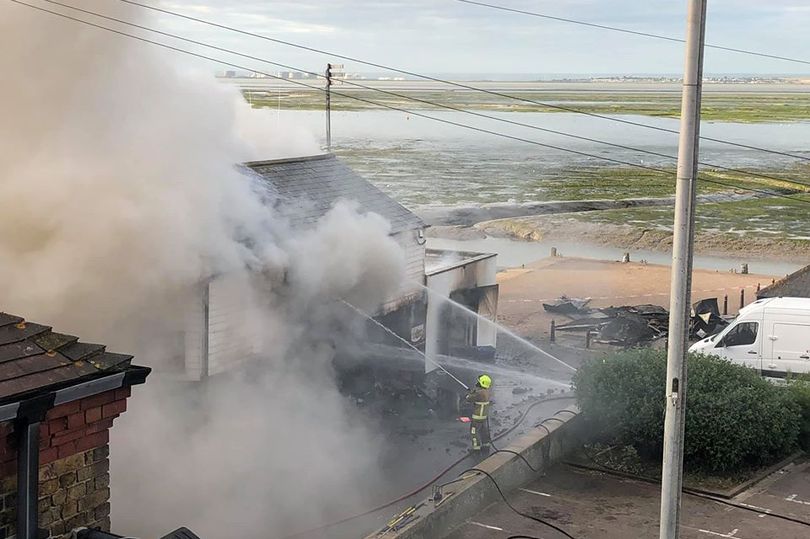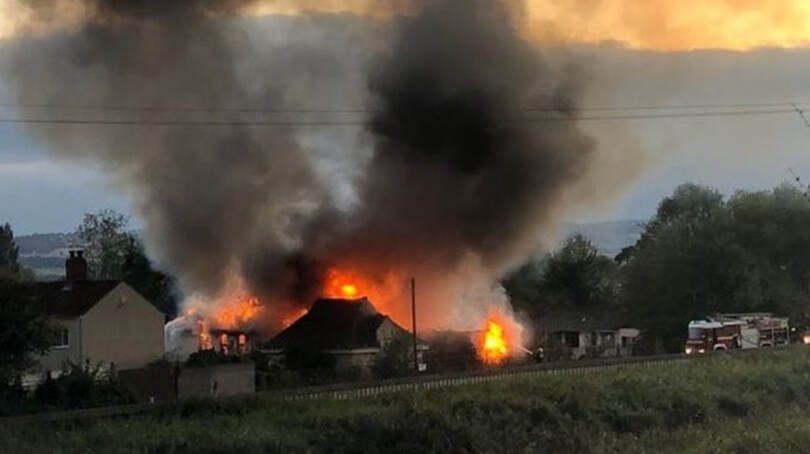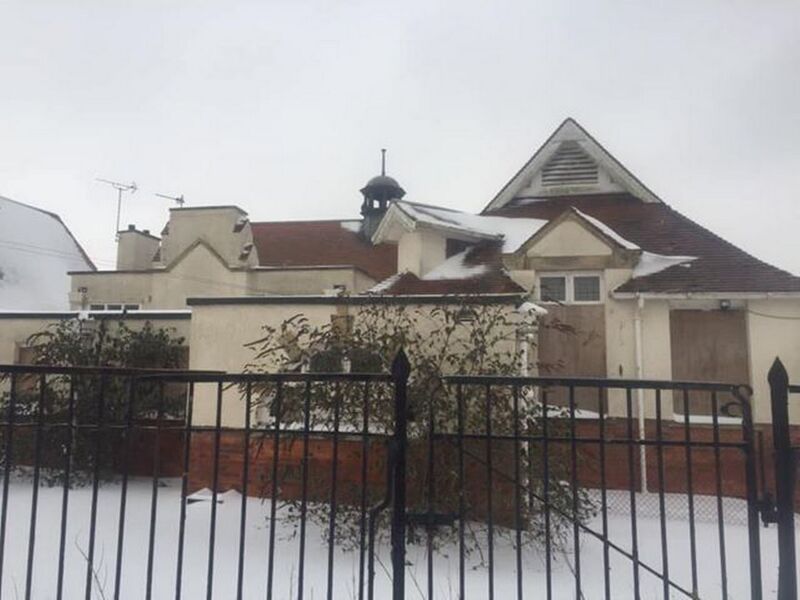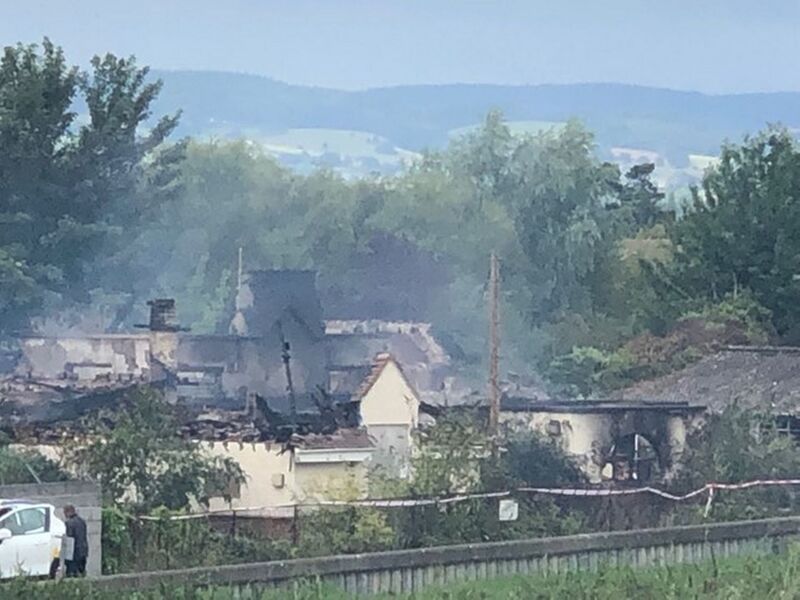55 Fires & 13 Near Misses in
Heritage Buildings Recorded on the 2019 Database in
September & October.
(A Fire is defined as an uncontrolled and unwanted burning event (including explosion) causing damage to a heritage building and/or contents by at least one of the following: flame, heat, smoke or blast)
(A Near Miss is defined as an event in a heritage building that had the potential to start a fire, or a fire adjacent to a heritage building that, without intervention, could have spread to that building)
* on the incident time indicates only the approximate time of the incident is known
Heritage Buildings Recorded on the 2019 Database in
September & October.
(A Fire is defined as an uncontrolled and unwanted burning event (including explosion) causing damage to a heritage building and/or contents by at least one of the following: flame, heat, smoke or blast)
(A Near Miss is defined as an event in a heritage building that had the potential to start a fire, or a fire adjacent to a heritage building that, without intervention, could have spread to that building)
* on the incident time indicates only the approximate time of the incident is known
Fires Index < Click here
hOME / About / Places of Worship / Heritage Buildings / Domestic listed properties / Country estates / grant /CONTACT US / Fires
|
“It is impossible to find words in which to express our grief over the destruction by fire of the glorious Abbey Church of Selby in Yorkshire. Although the church should be restored, it will be a building without the charm of age and the historic evidences of its structural growth through eight centuries which lent it interest and made it venerable.”
Church Times, 26th October 1906 |
Subscribe to our newsletterOur Newsletter is out now with articles on all things related to fires, fire prevention, protection and restoration of heritage buildings - See this and our previous Newsletters HERE. "Our Heritage Under Fire" brings interesting, informative and enlightening news and comment for everyone who has an interest in the protection of the UKs built heritage.
Subscribe by clicking the button below to be added to our mailing list. Don't miss an issue. You are signing up only to receive our newsletter, we will not use your contact details, nor pass them on to third parties, for any other purpose. You may unsubscribe from the list at any time. |
Click on the HEADLINE to expand the article.
Heritage & Ecclesiastical Fire Protection
Preventing Fire, Protecting Life, Preserving Heritage
Click HERE for Expert Specialist Fire Safety Risk Assessments for Historic and Listed Buildings
Preventing Fire, Protecting Life, Preserving Heritage
Click HERE for Expert Specialist Fire Safety Risk Assessments for Historic and Listed Buildings
Phone: 07840 351458 Email: [email protected]
October - 22 Fires & 6 Near Misses
30 October 2019 (19:46) - Two household pets die in fire at a 200-year-old cottage in Rochdale
Two household pets died after a fire broke out at a 200-year-old cottage in Rochdale. Crews were called to Dale Street in Milnrow just after 7.45pm on Wednesday. The blaze was understood to be on the first floor of one of the 19th century properties known as the Weaver's cottages. Six fire engines attended the scene with firefighters spraying water onto flames from the outside. Greater Manchester Fire and Rescue service later tweeted that a parrot and a dog had died in the blaze. No one else was hurt in the incident.
Images from Dale Street show several pumps lined up along the street, which has been taped off by emergency services. A spokesman for Greater Manchester Fire and Rescue said: "We were called at 7.46pm to a fire on the first floor of a three-storey end-terrace house on Dale Street. Six crews at in attendance using breathing apparatus and hose reels to fight the fire."
The building is one of two semi-detached Grade II listed buildings on the street known as the Weavers' cottages, where hand-loom weavers used to work in the top-storey.
News Source: Manchester Evening News
Images from Dale Street show several pumps lined up along the street, which has been taped off by emergency services. A spokesman for Greater Manchester Fire and Rescue said: "We were called at 7.46pm to a fire on the first floor of a three-storey end-terrace house on Dale Street. Six crews at in attendance using breathing apparatus and hose reels to fight the fire."
The building is one of two semi-detached Grade II listed buildings on the street known as the Weavers' cottages, where hand-loom weavers used to work in the top-storey.
News Source: Manchester Evening News
Listing Details
|
Entry Name: 45 and 47, Dale Street
Listing Date: 23 April 1986 Grade: II Source: Historic England Source ID: 1068492 English Heritage Legacy ID: 213426 Location: Rochdale, OL16 County: Rochdale Electoral Ward/Division: Milnrow and Newhey Built-Up Area: Milnrow Traditional County: Lancashire Lieutenancy Area (Ceremonial County): Greater Manchester Church of England Parish: Milnrow St James Church of England Diocese: Manchester |
Coordinates
Latitude: 53.6104 / 53°36'37"N Longitude: -2.1108 / 2°6'38"W OS Eastings: 392769 OS Northings: 412650 OS Grid: SD927126 Mapcode National: GBR FVPP.TJ Mapcode Global: WHB8Y.KJ32 |
Near Miss
28 October 2019 (14:55) - Fire at former Kent Wool Growers site on Tannery Lane in Ashford
28 October 2019 (14:55) - Fire at former Kent Wool Growers site on Tannery Lane in Ashford
A major blaze has taken hold at a former town centre gun shop. The building - situated in the former Kent Wool Growers site on Tannery Lane, Ashford - now has a heavy emergency service presence. The building's roof has now collapsed, and a Fire and Rescue Service Command Support Unit is on the scene. Though close, the Grade II* listed Whist House - also located on the site - appears to be out of harm's way.
A spokeswoman for the fire service said: "We are responding to a fire in a commercial building in Tannery Lane, Ashford. Five fire engines and a height vehicle are at the scene, and crews are using hose reel jets and water from a hydrant to tackle the blaze. People living and working near Tannery Lane in Ashford are advised to close windows and due to smoke, while firefighters deal with a fire in a commercial building. There are currently no reported casualties."
A police dog unit is present, alongside a throng of spectators. Major delays should be expected if driving through the town. In a statement issued just before 7pm, the fire service said: "The earlier advice for people living and working near Tannery Lane in Ashford to close windows and doors due to smoke, has been lifted. At the height of the fire, which was within a derelict commercial building, six fire engines and a height vehicle were in attendance. This has now been scaled down with crews damping down remaining hot spots. There are no reported injuries and the cause is not yet known."
Earlier this year, controversial plans to build more than 200 flats including a 14-storey block on the former business site were approved. As part of the plans, the listed building on the site will be transformed into a bar and restaurant.
Whist House was last used as a residential property in 1995. Since then, the building has fallen into a state of disrepair. It was built by Richard Greenhill in 1707, who was a successful businessman, working as a clockmaker before becoming a tanner.
News Source: Kent Online
A spokeswoman for the fire service said: "We are responding to a fire in a commercial building in Tannery Lane, Ashford. Five fire engines and a height vehicle are at the scene, and crews are using hose reel jets and water from a hydrant to tackle the blaze. People living and working near Tannery Lane in Ashford are advised to close windows and due to smoke, while firefighters deal with a fire in a commercial building. There are currently no reported casualties."
A police dog unit is present, alongside a throng of spectators. Major delays should be expected if driving through the town. In a statement issued just before 7pm, the fire service said: "The earlier advice for people living and working near Tannery Lane in Ashford to close windows and doors due to smoke, has been lifted. At the height of the fire, which was within a derelict commercial building, six fire engines and a height vehicle were in attendance. This has now been scaled down with crews damping down remaining hot spots. There are no reported injuries and the cause is not yet known."
Earlier this year, controversial plans to build more than 200 flats including a 14-storey block on the former business site were approved. As part of the plans, the listed building on the site will be transformed into a bar and restaurant.
Whist House was last used as a residential property in 1995. Since then, the building has fallen into a state of disrepair. It was built by Richard Greenhill in 1707, who was a successful businessman, working as a clockmaker before becoming a tanner.
News Source: Kent Online
Listing Details
|
Entry Name: Whist House
Listing Date: 24 September 1951 Last Amended: 4 June 1976 Grade: II* Source: Historic England Source ID: 1299918 English Heritage Legacy ID: 180059 Location: Ashford, Kent, TN23 County: Kent District: Ashford Town: Ashford Electoral Ward/Division: Victoria Built-Up Area: Ashford (Ashford) Traditional County: Kent Lieutenancy Area (Ceremonial County): Kent |
Coordinates
Latitude: 51.146 / 51°8'45"N Longitude: 0.8773 / 0°52'38"E OS Eastings: 601345 OS Northings: 142465 OS Grid: TR013424 Mapcode National: GBR SY7.0M3 Mapcode Global: VHKKN.5G49 |
27 October 2019 (18:00*) - Fire breaks out at Keighley sandwich bar
Staff had to evacuate a Keighley town-centre sandwich bar when a fire broke out in the basement. The blaze started in an electrical box at Fresh Bites, Cooke Street, and filled the premises with smoke. Firefighters wore breathing apparatus to tackle the flames and used a special high-powered ventilation fan to help clear the smoke.
The fire was brought under control quickly, but firefighters remained at the scene for more than two hours until Northern Powergrid engineers had attended to ensure the electrics were safe. Crews from Keighley and Bingley were called out to the incident shortly after 6pm yesterday. Watch commander Ahsan Ali, of Keighley Fire Station, said: "When we arrived the building was full of smoke. Staff had raised the alarm and evacuated the premises.We managed to confine the fire to the basement area, but there was smoke damage to the rest of the building."
The building was constructed in 1892 (date stone with initials JB). It lies within the Keighley Town Centre Conservation Area where it is said to make a positive contribution to the area.
News Source: Telegraph and Argus
The fire was brought under control quickly, but firefighters remained at the scene for more than two hours until Northern Powergrid engineers had attended to ensure the electrics were safe. Crews from Keighley and Bingley were called out to the incident shortly after 6pm yesterday. Watch commander Ahsan Ali, of Keighley Fire Station, said: "When we arrived the building was full of smoke. Staff had raised the alarm and evacuated the premises.We managed to confine the fire to the basement area, but there was smoke damage to the rest of the building."
The building was constructed in 1892 (date stone with initials JB). It lies within the Keighley Town Centre Conservation Area where it is said to make a positive contribution to the area.
News Source: Telegraph and Argus
26 October 2019 (21:00*) - Fire service called to Royal Hotel, Weymouth Esplanade
Four crews of firefighters attended the Royal Hotel on Weymouth Esplanade. Two fire engines from Weymouth, one from Portland and an aerial ladder platform team from Yeovil were called out after the alarm was raised yesterday evening. "Upon arrival the crews inspected the premises and discovered that a motor in the hotel's recycling unit had over heated, causing it to smoke," a spokesman for the fire service said. "Crews made the machine safe and remained on scene until satisfied there was no further risk. Our thanks to the residents for their cooperation and patience during this incident."
Building of the Grade II listed Royal Hotel was started in 1897 and completed 1899, and designed by C Orlando Law.
News Source: Dorset Echo
Building of the Grade II listed Royal Hotel was started in 1897 and completed 1899, and designed by C Orlando Law.
News Source: Dorset Echo
Listing Details
|
Entry Name: Royal Hotel and Queens Ballroom
Listing Date: 14 June 1974 Last Amended: 22 December 1997 Grade: II Source: Historic England Source ID: 1365861 English Heritage Legacy ID: 467598 Location: Dorset, Dorset, DT4 County: Dorset Electoral Ward/Division: Melcombe Regis Built-Up Area: Weymouth Traditional County: Dorset Lieutenancy Area (Ceremonial County): Dorset Church of England Parish: Radipole and Melcombe Regis Church of England Diocese: Salisbury |
Coordinates
Latitude: 50.6138 / 50°36'49"N Longitude: -2.4535 / 2°27'12"W OS Eastings: 368012 OS Northings: 79435 OS Grid: SY680794 Mapcode National: GBR PY.D9HD Mapcode Global: FRA 57RG.202 |
26 October 2019 (18:30) - Chimney fire at thatched cottage in Great Hallingbury
Firefighters were called to a fire in a thatched cottage in Great Hallingbury on Saturday (October 26). Crews were called to reports of a chimney fire at a thatched cottage in Church Lane, at 6.30pm. The fire, which was burning within the chimney, was extinguished by 7.29pm. A spokesman for Essex County Fire & Rescue Service said the cause was accidental.
The cottage is Grade II listed (now called Hunters End) and was built in the 16th – 17th century. It is the only thatched cottage in the Great Hallingbury Conservation Area.
News Source: Saffron Walden Reporter
The cottage is Grade II listed (now called Hunters End) and was built in the 16th – 17th century. It is the only thatched cottage in the Great Hallingbury Conservation Area.
News Source: Saffron Walden Reporter
Listing Details
|
Entry Name: 18 and 19, Church Lane
Listing Date: 13 June 1983 Grade: II Source: Historic England Source ID: 1322667 English Heritage Legacy ID: 120459 Location: Great Hallingbury, Uttlesford, Essex, CM22 County: Essex District: Uttlesford Civil Parish: Great Hallingbury Traditional County: Essex Lieutenancy Area (Ceremonial County): Essex Church of England Parish: Great Hallingbury St Giles Church of England Diocese: Chelmsford |
Coordinates
Latitude: 51.8564 / 51°51'22"N Longitude: 0.1945 / 0°11'40"E OS Eastings: 551230 OS Northings: 219805 OS Grid: TL512198 Mapcode National: GBR MDZ.G11 Mapcode Global: VHHLW.BL6S |
25 October 2019 (10:00*) - Fire breaks out at thatched roof pub in Cornwall
A fire has broken out at thatched-roof pub on the Lizard. The blaze started in a deep-fat fryer in the kitchen at the Old Inn, Mullion, just after 10am on Friday morning. Firefighters from Mullion, Helston, St Keverne, Tolvaddon, Falmouth and St Just were all on the scene at Churchtown.
Crews have successfully stopped the flames from spreading to the roof. Traffic was said to be 'gridlocked' and drivers were being urged to avoid the area. In an update at 12.10, the fire service said: "The oil from the fryers have been drained and removed from the building. Firefighters are ensuring that the scene is left in a safe condition. The fire appliances have been moved to allow the road to reopen."
The Grade II listed sixteenth-century Old Inn at Mullion is a traditional thatched and beamed pub located in the heart of this smuggling village.
News Source: Pirate FM
Crews have successfully stopped the flames from spreading to the roof. Traffic was said to be 'gridlocked' and drivers were being urged to avoid the area. In an update at 12.10, the fire service said: "The oil from the fryers have been drained and removed from the building. Firefighters are ensuring that the scene is left in a safe condition. The fire appliances have been moved to allow the road to reopen."
The Grade II listed sixteenth-century Old Inn at Mullion is a traditional thatched and beamed pub located in the heart of this smuggling village.
News Source: Pirate FM
Listing Details
|
Entry Name: The Old Inn
Listing Date: 10 July 1957 Grade: II Source: Historic England Source ID: 1328500 English Heritage Legacy ID: 64663 Location: Mullion, Cornwall, TR12 County: Cornwall Civil Parish: Mullion Built-Up Area: Mullion Traditional County: Cornwall Lieutenancy Area (Ceremonial County): Cornwall Church of England Parish: Mullion Church of England Diocese: Truro |
Coordinates
Latitude: 50.028 / 50°1'40"N Longitude: -5.2428 / 5°14'33"W OS Eastings: 167845 OS Northings: 19242 OS Grid: SW678192 Mapcode National: GBR Z2.HCXF Mapcode Global: VH13J.2KQD |
24 October 2019 (09:00*) - Fire in Bicester coffee shop: staff praised for evacuation
Firefighters were called to a small fire in a coffee shop this morning. Oxfordshire Fire and Rescue said crews from Bicester Fire Station dealt with a small fire in a coffee shop on in the Market Square in Bicester. On arrival, the fire had been extinguished and the coffee shop staff and customers were able to escape safely. The fire service said this highlighted 'the benefits of training staff in what to do in the event of a fire.' The fire service added: "We’re making sure everyone is safe and removing light smoke from the shop to enable it to carry in trading as soon as possible!"
This 17th century building is Grade II listed, as are almost all the buildings in the triangular Market Square. The Square lies within Bicester Conservation Area.
News Source: Oxford Mail
This 17th century building is Grade II listed, as are almost all the buildings in the triangular Market Square. The Square lies within Bicester Conservation Area.
News Source: Oxford Mail
Listing Details
|
Entry Name: 34, Market Square
Listing Date: 20 March 1970 Grade: II Source: Historic England Source ID: 1200451 English Heritage Legacy ID: 243563 Location: Bicester, Cherwell, Oxfordshire, OX26 County: Oxfordshire District: Cherwell Civil Parish: Bicester Built-Up Area: Bicester Traditional County: Oxfordshire Lieutenancy Area (Ceremonial County): Oxfordshire Church of England Parish: Bicester with Caversfield Church of England Diocese: Oxford |
Coordinates
Latitude: 51.8966 / 51°53'47"N Longitude: -1.1509 / 1°9'3"W OS Eastings: 458522 OS Northings: 222346 OS Grid: SP585223 Mapcode National: GBR 8XJ.3TJ Mapcode Global: VHCX4.0LDF |
21 October 2019 (10:50*) - Fire at Capita building in Leeds city centre
Crews from seven different fire stations across West Yorkshire were called to Clay Pit Lane shortly before 11am, following reports of a fire at the Capita building.
West Yorkshire Fire & Rescue used an overhead platform and huge jet reels to tackle the blaze, with crews from Leeds, Hunslet, Killingbeck, Wakefield, Otley, Skelmanthorpe & Cookridge fire stations all at the scene. Staff were evacuated from the building as fire fighters rushed onto the scene. It is not yet known whether anyone has been injured.
Clay Pit Lane has been closed to traffic at Providence Place while the incident remains ongoing.
Seven fire engines and dozens of employees were seen standing outside the nearby first direct arena as emergency service battled the blaze. No fire or smoke was visible from Clay Pit Lane. One of the buildings windows was smashed but it is not clear whether this is connected to the fire. The window has since been boarded up.
Capita House was originally known as The Providence Mill and Hepworth House. It was the premises of Joseph Hepworth and Son. Hepworth's clothing company began in 1865. The Providence Works on Clay Pit Lane was designed by H.A. Cheers and built in 1891. Unfortunately, it had to be rebuilt after a fire just four years later, in 1895. By 1905 Hepworths had 143 shops. Hepworth's later became Next.
News Source: Yorkshire Evening Post
West Yorkshire Fire & Rescue used an overhead platform and huge jet reels to tackle the blaze, with crews from Leeds, Hunslet, Killingbeck, Wakefield, Otley, Skelmanthorpe & Cookridge fire stations all at the scene. Staff were evacuated from the building as fire fighters rushed onto the scene. It is not yet known whether anyone has been injured.
Clay Pit Lane has been closed to traffic at Providence Place while the incident remains ongoing.
Seven fire engines and dozens of employees were seen standing outside the nearby first direct arena as emergency service battled the blaze. No fire or smoke was visible from Clay Pit Lane. One of the buildings windows was smashed but it is not clear whether this is connected to the fire. The window has since been boarded up.
Capita House was originally known as The Providence Mill and Hepworth House. It was the premises of Joseph Hepworth and Son. Hepworth's clothing company began in 1865. The Providence Works on Clay Pit Lane was designed by H.A. Cheers and built in 1891. Unfortunately, it had to be rebuilt after a fire just four years later, in 1895. By 1905 Hepworths had 143 shops. Hepworth's later became Next.
News Source: Yorkshire Evening Post
Building History
(Researched by Heritage & Ecclesiastical Fire Protection)
Many people still remember Hepworth’s nation-wide chain of men’s outfitters, specialising in made-to-measure and off-the-peg suits, once the universal male uniform for office and professional work, and for weddings and funerals, all made in their own workshops. The firm was founded in 1864 by Joseph Hepworth and, like Montague Burton’s, became one of the great Leeds success stories in the wholesale manufacture of ready-made clothing.
Joseph Hepworth was a self-made man. Born in Lindley, near Huddersfield, in 1834, he started work when he was only ten years old as a mill boy, working ‘half-time’: six and a half hours a day, six days a week, for a wage of 1s 6d a week (15 pence). The working conditions were appalling, ‘not fit for a dog’, he said. He had almost no education – the idea of ‘half-time’ work for children of his age was to allow time for schooling, but this was not compulsory and the children like him were often too tired to study even if the opportunity existed. After a range of stultifying mill jobs he decided in 1864 to move to Leeds, by then the thriving hub of the regional economy with a strong tailoring tradition, to start his own clothing business, initially with his brother-in-law.
After only a year he struck out on his own, setting up a workshop to produce ready-made clothing. He struggled to survive but he persevered, expanded, and by 1881 his initial 12 employees had become 500. His eldest son Norris joined him and the firm became Joseph Hepworth & Son. They were the first of the clothing manufacturers to pioneer the development of a chain of retail shops to market the garments made in their workshops. Others followed their lead. The shops, well-fitted and elegant, were designed to give the ordinary working man a taste of luxury as he bought his new suit and they proved a great success. By 1891 the firm had 107 shops across the country, and employed over 2,000 workers, mostly female, in its vast new factory, ‘Providence Works’, in Claypit Lane. Its success was based on high sales at low prices, but not at the expense of the workforce. Joseph Hepworth did not forget his own hard beginnings: he aimed to give his workers a living wage (women’s wages across the trade at this time were painfully low), and the firm’s workshops were viewed as a model of efficient mechanisation and good working conditions.
In 1888, at the height of his success, Joseph Hepworth used his new wealth to move from his terrace house in town to the leafy suburb of Headingley, to Headingley House, a grand mansion with eight reception rooms, twelve bedrooms, generous servants’ quarters, set in wooded grounds between Kirkstall Lane and Beckett Park (the house was demolished c1908 and the Langdales, Estcourts etc built over the land). He had come a long way now from his wretched start in life. He retired from active involvement in the business, but remained busy in public life as a Town Councillor (Liberal), with a particular interest in education, prompted by his own lack of opportunity – chairman of the Library Committee, president of the Mechanics’ Institute and a governor of the Yorkshire College. A lifelong teetotaller, he was a generous supporter of the Band of Hope and of his Methodist chapel. He stayed in Headingley House until the turn of the century, when he left Leeds first for Torquay (for health reasons) and then Harrogate. Respected as ‘a man of the people’ he was elected Lord Mayor of Leeds in 1906, when he aroused some protest by refusing to allow alcohol at mayoral functions, declaring that the money saved should be spent on feeding poor children: few could argue with that. He died in 1911, and his life provided the obituary-writers with a model ‘rags to riches’ story.
The firm he founded still survives. Hepworth’s shops were converted to the Next format in 1982-85.
(Researched by Heritage & Ecclesiastical Fire Protection)
Many people still remember Hepworth’s nation-wide chain of men’s outfitters, specialising in made-to-measure and off-the-peg suits, once the universal male uniform for office and professional work, and for weddings and funerals, all made in their own workshops. The firm was founded in 1864 by Joseph Hepworth and, like Montague Burton’s, became one of the great Leeds success stories in the wholesale manufacture of ready-made clothing.
Joseph Hepworth was a self-made man. Born in Lindley, near Huddersfield, in 1834, he started work when he was only ten years old as a mill boy, working ‘half-time’: six and a half hours a day, six days a week, for a wage of 1s 6d a week (15 pence). The working conditions were appalling, ‘not fit for a dog’, he said. He had almost no education – the idea of ‘half-time’ work for children of his age was to allow time for schooling, but this was not compulsory and the children like him were often too tired to study even if the opportunity existed. After a range of stultifying mill jobs he decided in 1864 to move to Leeds, by then the thriving hub of the regional economy with a strong tailoring tradition, to start his own clothing business, initially with his brother-in-law.
After only a year he struck out on his own, setting up a workshop to produce ready-made clothing. He struggled to survive but he persevered, expanded, and by 1881 his initial 12 employees had become 500. His eldest son Norris joined him and the firm became Joseph Hepworth & Son. They were the first of the clothing manufacturers to pioneer the development of a chain of retail shops to market the garments made in their workshops. Others followed their lead. The shops, well-fitted and elegant, were designed to give the ordinary working man a taste of luxury as he bought his new suit and they proved a great success. By 1891 the firm had 107 shops across the country, and employed over 2,000 workers, mostly female, in its vast new factory, ‘Providence Works’, in Claypit Lane. Its success was based on high sales at low prices, but not at the expense of the workforce. Joseph Hepworth did not forget his own hard beginnings: he aimed to give his workers a living wage (women’s wages across the trade at this time were painfully low), and the firm’s workshops were viewed as a model of efficient mechanisation and good working conditions.
In 1888, at the height of his success, Joseph Hepworth used his new wealth to move from his terrace house in town to the leafy suburb of Headingley, to Headingley House, a grand mansion with eight reception rooms, twelve bedrooms, generous servants’ quarters, set in wooded grounds between Kirkstall Lane and Beckett Park (the house was demolished c1908 and the Langdales, Estcourts etc built over the land). He had come a long way now from his wretched start in life. He retired from active involvement in the business, but remained busy in public life as a Town Councillor (Liberal), with a particular interest in education, prompted by his own lack of opportunity – chairman of the Library Committee, president of the Mechanics’ Institute and a governor of the Yorkshire College. A lifelong teetotaller, he was a generous supporter of the Band of Hope and of his Methodist chapel. He stayed in Headingley House until the turn of the century, when he left Leeds first for Torquay (for health reasons) and then Harrogate. Respected as ‘a man of the people’ he was elected Lord Mayor of Leeds in 1906, when he aroused some protest by refusing to allow alcohol at mayoral functions, declaring that the money saved should be spent on feeding poor children: few could argue with that. He died in 1911, and his life provided the obituary-writers with a model ‘rags to riches’ story.
The firm he founded still survives. Hepworth’s shops were converted to the Next format in 1982-85.
19 October 2019 (06:40) - Brighton seafront hotel fire at The Old Ship Hotel, King's Road
Fire crews were called to a seafront hotel to tackle a blaze. Two fire engines were sent to The Old Ship Hotel in King’s Road, Brighton, this morning. A fire had started inside the hotel, which has been owned by the Cairn Group since 2016 following a £75 million property deal.
The fire service was called at 6.40am, and arrived shortly afterwards. Firefighters then tackled a small fire at the hotel. The service said crews were able to leave the scene just after 7am today.
The Old Ship Hotel (also known as the Old Ship Inn and previously as The Ship) is a hotel in central Brighton, UK, which contains the Old Ship Assembly Rooms, a Grade II* listed building. The building is the oldest hotel in Brighton, as the hotel is believed to have been built in 1559, with the assembly rooms being added in 1767.
News Source: The Argus
The fire service was called at 6.40am, and arrived shortly afterwards. Firefighters then tackled a small fire at the hotel. The service said crews were able to leave the scene just after 7am today.
The Old Ship Hotel (also known as the Old Ship Inn and previously as The Ship) is a hotel in central Brighton, UK, which contains the Old Ship Assembly Rooms, a Grade II* listed building. The building is the oldest hotel in Brighton, as the hotel is believed to have been built in 1559, with the assembly rooms being added in 1767.
News Source: The Argus
Listing Details
|
Entry Name: Old Ship Assembly Rooms
Listing Date: 13 October 1952 Grade: II* Source: Historic England Source ID: 1380932 English Heritage Legacy ID: 481256 Location: Brighton and Hove, BN1 County: Brighton and Hove Electoral Ward/Division: Regency Built-Up Area: Brighton and Hove Traditional County: Sussex Lieutenancy Area (Ceremonial County): East Sussex Church of England Parish: Brighton St Paul Church of England Diocese: Chichester |
Coordinates
Latitude: 50.8208 / 50°49'14"N Longitude: -0.1419 / 0°8'30"W OS Eastings: 530980 OS Northings: 104009 OS Grid: TQ309040 Mapcode National: GBR JP4.DZ0 Mapcode Global: FRA B6LX.NKH |
Building History
(Researched by Heritage & Ecclesiastical Fire Protection)
The Old Ship Hotel is believed to date from 1559, as an unnamed house owned by Richard and John Gilham. It is the oldest hotel in Brighton, and the first known record was in 1665. The building was purchased in 1671 by Nicholas Tettersell, who owned the boat Charles II used to get to France. The assembly rooms were built in 1767 in response to assembly rooms built at the nearby Castle Inn; the rooms were built by Robert Golden, with the Adam style inspired by Robert Adam. The assembly rooms contained a ballroom on the first floor, which hosted the Prince Regent's Ball, as well as card and tea rooms.Until 1777, the building hosted the town's post office.
In the 18th century, the hotel was visited by Frances Burney and Samuel Johnson; Johnson had an argument with the local priest, Henry Michell. In 1780, the assembly rooms hosted card evenings on Tuesday and Saturday, although the ballroom was later closed in 1814. The building was expanded in 1794, and the Ship Street corner block was added in 1835. In 1821, the magistrates' court was moved to the Old Ship, in 1831, Niccolo Paganini gave a concert in the assembly rooms, and in 1835, Gideon Mantell gave a lecture on geology and organic remains at the Old Ship Hotel. Charles Dickens stayed at the hotel in 1841, and other Victorian visitors to the hotel included Robert Schumann's wife, Sims Reeves, Luigi Lablache, Marietta Alboni, Julius Benedict, Charles Santley, Henry Irving, Herbert Beerbohm Tree, and Henry Howard, 13th Duke of Norfolk.
By 1885, the assembly rooms had been turned into auction rooms. In the 1930s, the Old Ship began accepting homosexual men in one wing of the hotel. The assembly rooms became a Grade II* listed building in 1952.
(Researched by Heritage & Ecclesiastical Fire Protection)
The Old Ship Hotel is believed to date from 1559, as an unnamed house owned by Richard and John Gilham. It is the oldest hotel in Brighton, and the first known record was in 1665. The building was purchased in 1671 by Nicholas Tettersell, who owned the boat Charles II used to get to France. The assembly rooms were built in 1767 in response to assembly rooms built at the nearby Castle Inn; the rooms were built by Robert Golden, with the Adam style inspired by Robert Adam. The assembly rooms contained a ballroom on the first floor, which hosted the Prince Regent's Ball, as well as card and tea rooms.Until 1777, the building hosted the town's post office.
In the 18th century, the hotel was visited by Frances Burney and Samuel Johnson; Johnson had an argument with the local priest, Henry Michell. In 1780, the assembly rooms hosted card evenings on Tuesday and Saturday, although the ballroom was later closed in 1814. The building was expanded in 1794, and the Ship Street corner block was added in 1835. In 1821, the magistrates' court was moved to the Old Ship, in 1831, Niccolo Paganini gave a concert in the assembly rooms, and in 1835, Gideon Mantell gave a lecture on geology and organic remains at the Old Ship Hotel. Charles Dickens stayed at the hotel in 1841, and other Victorian visitors to the hotel included Robert Schumann's wife, Sims Reeves, Luigi Lablache, Marietta Alboni, Julius Benedict, Charles Santley, Henry Irving, Herbert Beerbohm Tree, and Henry Howard, 13th Duke of Norfolk.
By 1885, the assembly rooms had been turned into auction rooms. In the 1930s, the Old Ship began accepting homosexual men in one wing of the hotel. The assembly rooms became a Grade II* listed building in 1952.
Near Miss
18 October 2019 (04:05*) - Fire crews battle blaze in building off Shirley High Street
18 October 2019 (04:05*) - Fire crews battle blaze in building off Shirley High Street
Fire crews were called to a blaze in a derelict building in Southampton. The incident at Church End in Shirley, just off the High Street, was attended by crews from three fire stations - St Mary's, Totton, and Redbridge. Crews were called out just after 4am and were on the scene until 6.15.
Church End is a narrow street runs alongside the High Street between its junctions with Cherry Gurney Road and Janson Road. A Hampshire Fire and Rescue Service spokesman said the fire, which involved pallets and timber, broke out in a derelict building being used as a garage Part of the High Street was closed for a time while crews dealt with the blaze.
Locals confirmed that the fire was in the old snooker hall, which is on the opposite side of the lane to the Locally Listed Romanesque-style church of St Boniface. The Church was built in 1927 by architect Wilfred C. Mangan of Preston, who had designed many other Roman Catholic Churches in the country. The builders were Jenkins and Sons of Southampton.
The building is of an interesting design, described by David Lloyd (Building of England: Hampshire and the I.O.W.) as “expansive neo-byzantine” - and has a distinctive slender tower ending in an octagon with a tiled cap.
News Source: Southern Daily Echo
Church End is a narrow street runs alongside the High Street between its junctions with Cherry Gurney Road and Janson Road. A Hampshire Fire and Rescue Service spokesman said the fire, which involved pallets and timber, broke out in a derelict building being used as a garage Part of the High Street was closed for a time while crews dealt with the blaze.
Locals confirmed that the fire was in the old snooker hall, which is on the opposite side of the lane to the Locally Listed Romanesque-style church of St Boniface. The Church was built in 1927 by architect Wilfred C. Mangan of Preston, who had designed many other Roman Catholic Churches in the country. The builders were Jenkins and Sons of Southampton.
The building is of an interesting design, described by David Lloyd (Building of England: Hampshire and the I.O.W.) as “expansive neo-byzantine” - and has a distinctive slender tower ending in an octagon with a tiled cap.
News Source: Southern Daily Echo
16 October 2019 (19:59) - Three fire engines sent to Hastings kitchen fire
Firefighters were called to a residential property in Hastings after reports of a kitchen fire. Crews from Battle, Hastings and The Ridge attended Cambridge Gardens, Hastings, at 7.59pm on Wednesday (October 16). A spokesman for the fire service said they were responding to reports of kitchen fire. On arrival, a chip pan fire was out, according to the spokesman. One resident was handed over in to the care of paramedics from the South East Coast Ambulance Service (SECAmb) after crews carried out 02 therapy on the resident.Fire crews carried out a Home Safety Visit.
Cambridge Gardens was developed from 1873 by John Howell a major builder who became Mayor of Hastings. It provides a strong rhythm and uniformity in the Hastings Central Conservation Area.
News Source: Rye and Battle Observer
Cambridge Gardens was developed from 1873 by John Howell a major builder who became Mayor of Hastings. It provides a strong rhythm and uniformity in the Hastings Central Conservation Area.
News Source: Rye and Battle Observer
Near Miss
15 October 2019 (09:30*) - Firefighters attend electrical meltdown in High Street in Stamford
15 October 2019 (09:30*) - Firefighters attend electrical meltdown in High Street in Stamford
Firefighters are currently at the scene of an electrical fault at the junction of High Street and St Paul's Street in Stamford. Marks and Spencer, The Sewing Room and Johnson's cleaners have had to close to customers because of the issue. It is believed that the insulation around an underground cable has burned through following a fault.
The firefighters were waiting at the scene and were monitoring the area, according to Royce Atkinson, watch manager for Lincolnshire Fire and Rescue. Western Power Distribution, which deals with electricity supply cables in the area, is aware of the issue and has been contacted for comment.The same area of Stamford had issues with an underground water pipe bursting earlier in the year.
Built in the mid-18th century, The M&S Foodhall building is Grade II listed.
News Source: Rutland and Stamford Mercury
The firefighters were waiting at the scene and were monitoring the area, according to Royce Atkinson, watch manager for Lincolnshire Fire and Rescue. Western Power Distribution, which deals with electricity supply cables in the area, is aware of the issue and has been contacted for comment.The same area of Stamford had issues with an underground water pipe bursting earlier in the year.
Built in the mid-18th century, The M&S Foodhall building is Grade II listed.
News Source: Rutland and Stamford Mercury
Listing Details
|
Entry Name: 1-3, St George's Street
Listing Date: 26 April 1974 Grade: II Source: Historic England Source ID: 1062224 English Heritage Legacy ID: 193632 Location: Stamford, South Kesteven, Lincolnshire, PE9 County: Lincolnshire District: South Kesteven Civil Parish: Stamford Built-Up Area: Stamford Traditional County: Lincolnshire Lieutenancy Area (Ceremonial County): Lincolnshire Church of England Parish: Stamford St George Church of England Diocese: Lincoln |
Coordinates
Latitude: 52.653 / 52°39'10"N Longitude: -0.4761 / 0°28'33"W OS Eastings: 503185 OS Northings: 307233 OS Grid: TF031072 Mapcode National: GBR FVS.LGP Mapcode Global: WHGLX.NKHZ |
14 October 2019 (18:50*) - Investigation launched into fire at Creswell's former swimming baths
Police and fire service have launched an investigation into a fire at the former swimming baths in Creswell. Emergency services were called to Creswell Leisure Centre, on Duke Street, before 7pm yesterday. Roads surrounding the unused leisure centre were also closed due to the incident. Fire crews from Clowne, Staveley, Worksop and Edwinstowe tackled the fire which was put out by 9pm.
On Wednesday morning a Derbyshire police spokesman said: “After a joint investigation to establish the cause of the fire we can confirm it is being treated as arson. Investigations showed there were two seats to the fire. We are appealing for anyone who saw anything suspicious or who may have been driving past and have dashcam footage to contact us.”
The historic swimming baths in the former mining village of Creswell has been identified as an unlisted building of merit within the Creswell Village and Model Village Conservation Area. The baths were originally built by the Miners’ Welfare Fund in 1924 on a site donated by the Duke of Portland. They included not only a swimming pool but also slipper baths for the many homes that did not have their own bathrooms at that time. It later became Creswell Leisure Centre, under the control of Bolsover District Council. However, at the end of 2016, the centre closed after the authority announced plans for an enhanced £4 million leisure facility in Clowne. The property, which offers around 10,000 sq ft of space was eventually put on the market.
Less than two months ago the agents marketing the property, Derby-based BB&J Commercial, has revealed that the building has now been sold to a “local developer”. In the run up to the sale, BB&J said that after discussions with the district council, it invited best and final bids on the property by a set date. An offer was then accepted. According to BB&J, the leisure centre is a unique building and has the potential for a variety of different redevelopment or conversion options, subject to planning consent.
Mark Richardson, partner at BB&J Commercial, said: “Since the closure of the leisure centre, the building had fallen into a dilapidated condition with lots of disrepair. However, the property still offered a lot of potential for conversion or development and therefore attracted a good amount of interest. We were delighted to be able to dispose of this on behalf of our client Bolsover District Council who we have worked with for numerous years now.”
News Source: Derbyshire Times
On Wednesday morning a Derbyshire police spokesman said: “After a joint investigation to establish the cause of the fire we can confirm it is being treated as arson. Investigations showed there were two seats to the fire. We are appealing for anyone who saw anything suspicious or who may have been driving past and have dashcam footage to contact us.”
The historic swimming baths in the former mining village of Creswell has been identified as an unlisted building of merit within the Creswell Village and Model Village Conservation Area. The baths were originally built by the Miners’ Welfare Fund in 1924 on a site donated by the Duke of Portland. They included not only a swimming pool but also slipper baths for the many homes that did not have their own bathrooms at that time. It later became Creswell Leisure Centre, under the control of Bolsover District Council. However, at the end of 2016, the centre closed after the authority announced plans for an enhanced £4 million leisure facility in Clowne. The property, which offers around 10,000 sq ft of space was eventually put on the market.
Less than two months ago the agents marketing the property, Derby-based BB&J Commercial, has revealed that the building has now been sold to a “local developer”. In the run up to the sale, BB&J said that after discussions with the district council, it invited best and final bids on the property by a set date. An offer was then accepted. According to BB&J, the leisure centre is a unique building and has the potential for a variety of different redevelopment or conversion options, subject to planning consent.
Mark Richardson, partner at BB&J Commercial, said: “Since the closure of the leisure centre, the building had fallen into a dilapidated condition with lots of disrepair. However, the property still offered a lot of potential for conversion or development and therefore attracted a good amount of interest. We were delighted to be able to dispose of this on behalf of our client Bolsover District Council who we have worked with for numerous years now.”
News Source: Derbyshire Times
13 October 2019 (09:25) - Fire in church organ in Thixendale
A crew was called to Main Street in Thixendale at 9.25am on Sunday to a fire which had started in a church organ. The fire, which was out on their arrival, is believed to have been caused by the motor overheating. The fire was confined to the electric components of the organ. Crews made the organ safe using tools and checked for fire spread.
The Grade II* listed church of St. Mary the Virgin and its vicarage were built between 1868 and 1870, under the renowned architect George Edmund Street. The builders were Simpson and Malone of Hull.
The organ, built by Forster and Andrews of Hull in 1877, is an incredibly fine example of their workmanship and is a beautiful instrument with gilded decoration on the tin front pipes. Of particular historical significance is the fact that there have been no alterations to the organ since it was built apart from the addition of an electric blower. The organ was presented to the church in 1877 by Sir Tatton Sykes and cost £199.00. It replaced the harmonium which had been played by Mrs Elizabeth Jewison.
News Source: Gazette & Herald
The Grade II* listed church of St. Mary the Virgin and its vicarage were built between 1868 and 1870, under the renowned architect George Edmund Street. The builders were Simpson and Malone of Hull.
The organ, built by Forster and Andrews of Hull in 1877, is an incredibly fine example of their workmanship and is a beautiful instrument with gilded decoration on the tin front pipes. Of particular historical significance is the fact that there have been no alterations to the organ since it was built apart from the addition of an electric blower. The organ was presented to the church in 1877 by Sir Tatton Sykes and cost £199.00. It replaced the harmonium which had been played by Mrs Elizabeth Jewison.
News Source: Gazette & Herald
Listing Details
|
Entry Name: Church of Saint Mary
Listing Date: 10 October 1966 Grade: II* Source: Historic England Source ID: 1316014 English Heritage Legacy ID: 328808 Location: Thixendale, Ryedale, North Yorkshire, YO17 County: North Yorkshire Civil Parish: Thixendale Traditional County: Yorkshire Lieutenancy Area (Ceremonial County): North Yorkshire Church of England Parish: Thixendale St Mary Church of England Diocese: York |
Coordinates
Latitude: 54.0387 / 54°2'19"N Longitude: -0.7154 / 0°42'55"W OS Eastings: 484221 OS Northings: 461070 OS Grid: SE842610 Mapcode National: GBR RPFQ.XZ Mapcode Global: WHFBW.ZRG6 |
13 October 2019 (02:00*) - Tenants escape from flat after fire at The Railway pub, Ramsbottom
Tenants had to evacuate from a newly refurbished pub after a fire started in the basement. An 11-year-old child and five adults escaped from the flat above The Railway pub in Ramsbottom after the fire alarm sounded. The blaze is believed to have started in a chest freezer stored in the basement after a "suspected electrical fault".
Fire crews from Ramsbottom, Bury and Rawtenstall were called to the Bridge Street venue at about 2am today. The fire damage was contained to the basement, with the freezer and wiring badly burnt, as well as a large area of soot damage. Meanwhile, smoke had spread to the ground floor and the main pub area, which reopened in June following a £500,000 refurbishment.
Steve Wilcock, watch manager at Bury Fire Station, said: "We were called to a building fire at The Railway. There were five people in the flat above the pub, including one child who was staying there with her relatives. On route, we had reports that the people had managed to get down the fire escape safely. The ground floor was smoke logged and there was a fire in the basement." Crews used breathing apparatus and a fan to clear the smoke from the ground floor. A fire investigation is due to take place today to determine the cause. Mr Wilcock said: "It is believed to be an electrical problem. It is not believed to be suspicious." He added: "The fire door to the basement was closed during the fire, which prevented this incident from being worse. With any building, a house or commercial property, if you close all the doors, you are going to create a much better scenario and minimise the spread of the fire and the damage caused."
The Railway Hotel was built in 1848 shortly after the coming of railway in 1846.
News Source: Bury Times
Fire crews from Ramsbottom, Bury and Rawtenstall were called to the Bridge Street venue at about 2am today. The fire damage was contained to the basement, with the freezer and wiring badly burnt, as well as a large area of soot damage. Meanwhile, smoke had spread to the ground floor and the main pub area, which reopened in June following a £500,000 refurbishment.
Steve Wilcock, watch manager at Bury Fire Station, said: "We were called to a building fire at The Railway. There were five people in the flat above the pub, including one child who was staying there with her relatives. On route, we had reports that the people had managed to get down the fire escape safely. The ground floor was smoke logged and there was a fire in the basement." Crews used breathing apparatus and a fan to clear the smoke from the ground floor. A fire investigation is due to take place today to determine the cause. Mr Wilcock said: "It is believed to be an electrical problem. It is not believed to be suspicious." He added: "The fire door to the basement was closed during the fire, which prevented this incident from being worse. With any building, a house or commercial property, if you close all the doors, you are going to create a much better scenario and minimise the spread of the fire and the damage caused."
The Railway Hotel was built in 1848 shortly after the coming of railway in 1846.
News Source: Bury Times
Near Miss
12 October 2019 (23:19) - Container fire at Spotland Bridge Mills
12 October 2019 (23:19) - Container fire at Spotland Bridge Mills
A container in the grounds at Spotland Bridge Mills exploded and caught fire on Saturday evening (12 October). Two fire engines from Rochdale used one hose reel to extinguish the 20ft flames and were on scene until 1.20am. Crewe Industrial, which owns the site, confirmed no-one was hurt during the incident. The fire was confined to the storage container and did not spread to the mill building.
A spokesperson for the Greater Manchester Fire and Rescue Service said: “We were called at 11.19pm to reports of a fire in the open air on Longfield Street, Rochdale. On arrival, we discovered the fire was in a container outside, which contained electrical items. We received a number of calls from the public due to the sound of the explosion.”
Spotland Bridge Mill is Grade II listed. It was originally a cotton spinning mill, built about 1833 for the firm of Joseph Butterworth and Co. Ltd. It is now an industrial centre.
News Source: Rochdale Online
A spokesperson for the Greater Manchester Fire and Rescue Service said: “We were called at 11.19pm to reports of a fire in the open air on Longfield Street, Rochdale. On arrival, we discovered the fire was in a container outside, which contained electrical items. We received a number of calls from the public due to the sound of the explosion.”
Spotland Bridge Mill is Grade II listed. It was originally a cotton spinning mill, built about 1833 for the firm of Joseph Butterworth and Co. Ltd. It is now an industrial centre.
News Source: Rochdale Online
Listing Details
|
Entry Name: Spotland Bridge New Mill
Listing Date: 4 November 1996 Grade: II Source: Historic England Source ID: 1268046 English Heritage Legacy ID: 462316 Location: Rochdale, OL11 County: Rochdale Electoral Ward/Division: Spotland and Falinge Built-Up Area: Rochdale Traditional County: Lancashire Lieutenancy Area (Ceremonial County): Greater Manchester Church of England Parish: Spotland St Clement Church of England Diocese: Manchester |
Coordinates
Latitude: 53.6209 / 53°37'15"N Longitude: -2.1749 / 2°10'29"W OS Eastings: 388526 OS Northings: 413831 OS Grid: SD885138 Mapcode National: GBR FV7K.XR Mapcode Global: WHB8X.K7JZ |
12 October 2019 (12:00*) - Fire in derelict Preston pub thought to be arson
An investigation is going on to establish the cause of a blaze in a derelict old Preston pub. Two fire crews were called to the former Balmoral pub in Manchester Road around lunchtime today and found the upstairs well alight.
The empty property, more recently called the Beat Street Cafe Bar, is a known haunt for squatters. Firefighters wearing breathing apparatus entered the building and put out the blaze.
A fire brigade spokesman said: "The old pub is derelict, but it looks like rubbish and other material had been set alight. We believe the fire was deliberate and the cause is being investigated."
The Balmoral Hotel was built on the site of an earlier pub, known as the Black Swan. Its name was changed to the Balmoral on the 25th August 1891 before its demolition. The replacement building, which continued the name, was built around 1900.
News Source: Lancashire Post
The empty property, more recently called the Beat Street Cafe Bar, is a known haunt for squatters. Firefighters wearing breathing apparatus entered the building and put out the blaze.
A fire brigade spokesman said: "The old pub is derelict, but it looks like rubbish and other material had been set alight. We believe the fire was deliberate and the cause is being investigated."
The Balmoral Hotel was built on the site of an earlier pub, known as the Black Swan. Its name was changed to the Balmoral on the 25th August 1891 before its demolition. The replacement building, which continued the name, was built around 1900.
News Source: Lancashire Post
11 October 2019 (22:30*) - Fire chiefs confirm why the Printworks cinema was evacuated last night
Fire chiefs have confirmed there was a small blaze in the Printworks last night. The cinema in the city centre entertainment complex was evacuated at about 10.30pm. It came after what Greater Manchester Fire and Rescue Service describe as a 'small fire' in the second floor loos. The fire set off the building's sprinkler system.
Late last night Greater Manchester Fire and Rescue Service tweeted: "Standing outside Printworks in Manchester city centre? The cause? There’s a small fire in the second floor loos! We’re working with the building owners to turn off sprinklers. Just proves how effective a proper sprinkler system can be!"
The fire brigade statement came after Greater Manchester Police tweeted incorrectly that the evacuation was due to a 'false activation of the sprinkler'. The tweet added "There is no cause for concern or reason to be alarmed."
This afternoon Primtworks tweeted: "Following last night’s sprinkler activation, Vue cinema is closed for cleaning and safety checks and is expected to reopen potentially later today or tomorrow. We would like to say thank you to the emergency services for attending the scene quickly to provide immediate support.”
The Printworks entertainment venue is located on the revamped Withy Grove site of the business premises of the 19th century newspaper proprietor Edward Hulton, established in 1873 and later expanded.
News Source: Manchester Evening News
Late last night Greater Manchester Fire and Rescue Service tweeted: "Standing outside Printworks in Manchester city centre? The cause? There’s a small fire in the second floor loos! We’re working with the building owners to turn off sprinklers. Just proves how effective a proper sprinkler system can be!"
The fire brigade statement came after Greater Manchester Police tweeted incorrectly that the evacuation was due to a 'false activation of the sprinkler'. The tweet added "There is no cause for concern or reason to be alarmed."
This afternoon Primtworks tweeted: "Following last night’s sprinkler activation, Vue cinema is closed for cleaning and safety checks and is expected to reopen potentially later today or tomorrow. We would like to say thank you to the emergency services for attending the scene quickly to provide immediate support.”
The Printworks entertainment venue is located on the revamped Withy Grove site of the business premises of the 19th century newspaper proprietor Edward Hulton, established in 1873 and later expanded.
News Source: Manchester Evening News
Building History
(Researched by Heritage & Ecclesiastical Fire Protection)
Located on the corner of Withy Grove and Corporation Street, Edward Hulton’s publishing house was established in 1873, as Withy Grove Printing House, and later expanded by Hulton’s son, Sir Edward Hulton. When he retired in 1923, he sold his London and Manchester publishing business, and soon after they became Allied Newspapers, a consortium formed in 1924 and renamed Kemsley Newspapers in 1943. This meant that the building’s name changed frequently through the years - from Withy Grove Printing House, to the Chronicle Buildings, to Allied House, then Kemsley House.
Kemsley House was gradually developed from 1929 onwards, and became the largest newspaper office and printing house in Europe. It was a hive of journalistic activity, produced titles including the Manchester Evening Chronicle and the Daily Mirror, as well as long-forgotten papers, such as the Sunday Graphic. It was also place where the northern editions of many daily papers, including The Daily Mirror and Daily Telegraph, were printed, and became crucial in distributing news outside of London. As a result, the building was dubbed ‘the Fleet Street of the north’.
It housed a printing press until 1985, when it was bought by infamous newspaper mogul Robert Maxwell for £1, raising immediate concern for the jobs of everyone working there. It was renamed Maxwell House, and Maxwell went on to close the plant the following year, in the wake of a scandal. Maxwell expanded his media empire too rapidly and borrowed more than he could afford, resorting to raiding the pension fund to prop up his company. After Maxwell House was closed, the building lay idle for a decade, and Maxwell himself died on November 5, 1991, his body discovered floating in the Atlantic Ocean after he fell overboard from his yacht.
After the 1996 IRA bombing, the building was bought in 1998 by Shudehill Developments - made up of the Co-operative Wholesale Society and Co-operative Insurance Society. It was renamed The Printworks to reflect its history, redeveloped in a huge £110 million transformation as part of the Exchange Square project, and opened as an entertainment centre.
It was launched on November 9, 2000, by Sir Alex Ferguson and Lionel Richie as a new, 365-square foot facility over four floors. The Printworks now houses an Odeon cinema complex, with the first IMAX screen in the north west, a Nuffield Health fitness club, and Tiger Tiger nightclub, and A-listers have continued to frequent it.
(Researched by Heritage & Ecclesiastical Fire Protection)
Located on the corner of Withy Grove and Corporation Street, Edward Hulton’s publishing house was established in 1873, as Withy Grove Printing House, and later expanded by Hulton’s son, Sir Edward Hulton. When he retired in 1923, he sold his London and Manchester publishing business, and soon after they became Allied Newspapers, a consortium formed in 1924 and renamed Kemsley Newspapers in 1943. This meant that the building’s name changed frequently through the years - from Withy Grove Printing House, to the Chronicle Buildings, to Allied House, then Kemsley House.
Kemsley House was gradually developed from 1929 onwards, and became the largest newspaper office and printing house in Europe. It was a hive of journalistic activity, produced titles including the Manchester Evening Chronicle and the Daily Mirror, as well as long-forgotten papers, such as the Sunday Graphic. It was also place where the northern editions of many daily papers, including The Daily Mirror and Daily Telegraph, were printed, and became crucial in distributing news outside of London. As a result, the building was dubbed ‘the Fleet Street of the north’.
It housed a printing press until 1985, when it was bought by infamous newspaper mogul Robert Maxwell for £1, raising immediate concern for the jobs of everyone working there. It was renamed Maxwell House, and Maxwell went on to close the plant the following year, in the wake of a scandal. Maxwell expanded his media empire too rapidly and borrowed more than he could afford, resorting to raiding the pension fund to prop up his company. After Maxwell House was closed, the building lay idle for a decade, and Maxwell himself died on November 5, 1991, his body discovered floating in the Atlantic Ocean after he fell overboard from his yacht.
After the 1996 IRA bombing, the building was bought in 1998 by Shudehill Developments - made up of the Co-operative Wholesale Society and Co-operative Insurance Society. It was renamed The Printworks to reflect its history, redeveloped in a huge £110 million transformation as part of the Exchange Square project, and opened as an entertainment centre.
It was launched on November 9, 2000, by Sir Alex Ferguson and Lionel Richie as a new, 365-square foot facility over four floors. The Printworks now houses an Odeon cinema complex, with the first IMAX screen in the north west, a Nuffield Health fitness club, and Tiger Tiger nightclub, and A-listers have continued to frequent it.
11 October 2019 (18:42) - Care home residents rescued from fire in Liverpool
Firefighters were desperately searching for missing residents after a care home went up in flames this evening. The blaze broke out in the ground floor recreational room of Rodney House. At least five fire engines were on the scene and evacuated the three-storey building on Canning Street in the city's Georgian Quarter.
The three-storey building was evacuated but it was feared several people were still inside. Firefighters went back into the building and battled the flames to find if anyone was trapped. A floor by floor searching of the care home was carried out by fire fighters looking for missing residents. Paramedics and staff from the home checked over the residents who already evacuated. At least five fire engines were called to the scene and arrived within five minutes of the 999 call at 6.42pm. Two teams of firefighters wearing breathing apparatus started to put out the blaze. Firefighters had extinguished the majority of the flames by 7.45pm but the search for missing people was ongoing.
Staff members from the home, who are arriving to start their night shift, are being allowed through the cordon to help with residents who were evacuated, many seen to be wearing emergency foil blankets to stay warm.
The Fire service stood down around 8.40pm, and a spokesperson said: "Firefighting activity has ceased. A search for occupants has resulted in a number of evacuations and contact with residents who are remaining in rooms in safe conditions owing to immobility. All residents remaining in the building are in safe conditions with clean air."
Care home owner Elizabeth Ellis said that everyone had been evacuated and were safe. She added: "Nobody has been hurt whatsoever and everyone has been evacuated. I understand there has been some smoke damage in one of the large dining rooms." A North West Ambulance Service spokesman said, "There have been no reported injuries."
Rodney House is a 57-bed residential care home for people with mental health conditions, physical disabilities and for adults over the age of 65. It is part of a terraced row that was originally eight houses when they were built in the 1830s. The row is Grade II listed.
News Source: Liverpool Echo
The three-storey building was evacuated but it was feared several people were still inside. Firefighters went back into the building and battled the flames to find if anyone was trapped. A floor by floor searching of the care home was carried out by fire fighters looking for missing residents. Paramedics and staff from the home checked over the residents who already evacuated. At least five fire engines were called to the scene and arrived within five minutes of the 999 call at 6.42pm. Two teams of firefighters wearing breathing apparatus started to put out the blaze. Firefighters had extinguished the majority of the flames by 7.45pm but the search for missing people was ongoing.
Staff members from the home, who are arriving to start their night shift, are being allowed through the cordon to help with residents who were evacuated, many seen to be wearing emergency foil blankets to stay warm.
The Fire service stood down around 8.40pm, and a spokesperson said: "Firefighting activity has ceased. A search for occupants has resulted in a number of evacuations and contact with residents who are remaining in rooms in safe conditions owing to immobility. All residents remaining in the building are in safe conditions with clean air."
Care home owner Elizabeth Ellis said that everyone had been evacuated and were safe. She added: "Nobody has been hurt whatsoever and everyone has been evacuated. I understand there has been some smoke damage in one of the large dining rooms." A North West Ambulance Service spokesman said, "There have been no reported injuries."
Rodney House is a 57-bed residential care home for people with mental health conditions, physical disabilities and for adults over the age of 65. It is part of a terraced row that was originally eight houses when they were built in the 1830s. The row is Grade II listed.
News Source: Liverpool Echo
Listing Details
|
Entry Name: 4-16, Canning Street
Listing Date: 28 June 1952 Grade: II Source: Historic England Source ID: 1068333 English Heritage Legacy ID: 213827 Location: Liverpool, L8 County: Liverpool Electoral Ward/Division: Princes Park Built-Up Area: Liverpool Traditional County: Lancashire Lieutenancy Area (Ceremonial County): Merseyside Church of England Parish: St Luke in the City Team Church of England Diocese: Liverpool |
Coordinates
Latitude: 53.3982 / 53°23'53"N Longitude: -2.9693 / 2°58'9"W OS Eastings: 335644 OS Northings: 389482 OS Grid: SJ356894 Mapcode National: GBR 77R.PT Mapcode Global: WH877.CV86 |
11 October 2019 (00:15) - Hertfordshire dairy fire: Blaze ravages listed, derelict buildings in Codicote again
A blaze has ravaged a thatched Grade II listed property - for the second time in four years. More than 50 firefighters were sent to Node Court in Codicote, Hertfordshire after an alert at about 00:15 BST. The building has been derelict since a fire several years ago.
Eleven Hertfordshire Fire and Rescue Service crews - from Hatfield, Hertford, Hitchin, Stevenage and Welwyn Garden City - attended after the call. It was quickly established that the property was derelict, and nobody was inside. By 1am the entire roof - which police have previously said is one of the largest thatched roofs in the UK - was alight, with 50 per cent of the two-storey property also ablaze.
At 2.50am there was a partial collapse so a safety area was extended, but the operation was scaled down at 4.30am and crews were damping down by 6.20am. The fire service's district commander, Sean Comerford, said crews worked "hard throughout the night", and thanked colleagues from Herts Fire Control for their help and support. A Herts police spokeswoman confirmed officers were also called and assisted at the scene, with investigations to establish the cause still ongoing.
Crews remain at the scene damping down on Friday and an investigation into the cause will begin shortly. According to Historic England, the building was constructed in 1928 by Maurice Chesterton for the American businessman Carl Holmes as a model dairy, which at the time "set standards for hygiene and efficient dairy farming in England". The design has its roots in the Picturesque revival and was probably inspired by Marie Antoinette's dairy in 'Le Hameau', Versailles.
The 1928 detached property was partially gutted by arson in July 2015 in, what was described at the time as, "the largest [fire] of its kind in the UK". Joshua Bozier - from Kimpton, and later Whitwell - torched a vehicle in a car park outside the historic building which spread to the thatched roof and caused an estimated £3.5 million worth of damage. Bozier, 24, was arrested two days later and after pleading guilty was jailed in March 2017 for three years and four months due to the extent of the damage to the roof.
News source: BBC News
Eleven Hertfordshire Fire and Rescue Service crews - from Hatfield, Hertford, Hitchin, Stevenage and Welwyn Garden City - attended after the call. It was quickly established that the property was derelict, and nobody was inside. By 1am the entire roof - which police have previously said is one of the largest thatched roofs in the UK - was alight, with 50 per cent of the two-storey property also ablaze.
At 2.50am there was a partial collapse so a safety area was extended, but the operation was scaled down at 4.30am and crews were damping down by 6.20am. The fire service's district commander, Sean Comerford, said crews worked "hard throughout the night", and thanked colleagues from Herts Fire Control for their help and support. A Herts police spokeswoman confirmed officers were also called and assisted at the scene, with investigations to establish the cause still ongoing.
Crews remain at the scene damping down on Friday and an investigation into the cause will begin shortly. According to Historic England, the building was constructed in 1928 by Maurice Chesterton for the American businessman Carl Holmes as a model dairy, which at the time "set standards for hygiene and efficient dairy farming in England". The design has its roots in the Picturesque revival and was probably inspired by Marie Antoinette's dairy in 'Le Hameau', Versailles.
The 1928 detached property was partially gutted by arson in July 2015 in, what was described at the time as, "the largest [fire] of its kind in the UK". Joshua Bozier - from Kimpton, and later Whitwell - torched a vehicle in a car park outside the historic building which spread to the thatched roof and caused an estimated £3.5 million worth of damage. Bozier, 24, was arrested two days later and after pleading guilty was jailed in March 2017 for three years and four months due to the extent of the damage to the roof.
News source: BBC News
Listing Details
|
Entry Name: The Node Court
Listing Date: 8 January 1981 Grade: II Source: Historic England Source ID: 1102797 English Heritage Legacy ID: 161962 Location: Codicote, North Hertfordshire, Hertfordshire, SG4 County: Hertfordshire District: North Hertfordshire Civil Parish: Codicote Traditional County: Hertfordshire Lieutenancy Area (Ceremonial County): Hertfordshire Church of England Parish: Codicote Church of England Diocese: St.Albans |
Coordinates
Latitude: 51.8634 / 51°51'48"N Longitude: -0.2298 / 0°13'47"W OS Eastings: 521989 OS Northings: 219788 OS Grid: TL219197 Mapcode National: GBR J8F.2QQ Mapcode Global: VHGP5.YFWD |
9 October 2019 (16:20) - Crews called to village pub in Oldham after fire breaks out in roof
A village pub in Oldham has been forced to close after a fire broke out in the roof. Crews were called to The White Lion on Delph Lane in Delph just after 4.20pm on Wednesday. Images from the scene show several fire engines outside the pub, with what appears to be black smoke coming from the roof of the building. It is understood the fire started in the chimney before spreading to the rafters and that crews had to remove a section of the roof to extinguish it.
GMFRS said the damage was not thought to be serious. They added: "We were called at 4.21pm to a fire involving a chimney in the roof area of a commercial building. Crews from Mossley, Oldham and Chadderton attended as well as a hydraulic platform from Oldham."
A spokesman for The White Lion confirmed that it would remain closed Wednesday evening and Thursday, but that it would be reopen by the weekend. Saddleworth North councillor George Hulme praised crews for their efforts. He tweeted: "Brilliant work by the firefighters of Manchester Fire to stop what could have been a disastrous fire at the White Lion in Delph."
This attractive Grade II listed stone building at the end of the village street was originally three buildings which became one pub in 1790.
News Source: Manchester Evening News
GMFRS said the damage was not thought to be serious. They added: "We were called at 4.21pm to a fire involving a chimney in the roof area of a commercial building. Crews from Mossley, Oldham and Chadderton attended as well as a hydraulic platform from Oldham."
A spokesman for The White Lion confirmed that it would remain closed Wednesday evening and Thursday, but that it would be reopen by the weekend. Saddleworth North councillor George Hulme praised crews for their efforts. He tweeted: "Brilliant work by the firefighters of Manchester Fire to stop what could have been a disastrous fire at the White Lion in Delph."
This attractive Grade II listed stone building at the end of the village street was originally three buildings which became one pub in 1790.
News Source: Manchester Evening News
Listing Details
|
Entry Name: White Lion Public House
Listing Date: 3 July 1986 Grade: II Source: Historic England Source ID: 1356724 English Heritage Legacy ID: 212090 Location: Saddleworth, Oldham, OL3 County: Oldham Civil Parish: Saddleworth Built-Up Area: Delph Traditional County: Yorkshire Lieutenancy Area (Ceremonial County): Greater Manchester Church of England Parish: Friarmere St Thomas Church of England Diocese: Manchester |
Coordinates
Latitude: 53.5691 / 53°34'8"N Longitude: -2.0236 / 2°1'24"W OS Eastings: 398535 OS Northings: 408052 OS Grid: SD985080 Mapcode National: GBR GW95.P9 Mapcode Global: WHB95.WKK7 |
Near Miss
7 October 2019 (07:40) - Llandudno church hall fire
7 October 2019 (07:40) - Llandudno church hall fire
Three fire engines were called to a fire in a St Paul’s church hall in Craig-y-Don Llandudno. Two of the appliances came from Llandudno and one from Colwyn Bay. Rev Noel Carter, vicar of St Paul’s Church, said: “The church hall has smoke and water damage following a small electrical fire, causing damage to the men’s toilets, this morning. St Paul’s Church itself is untouched by the fire and normal community activities and services will resume soon. We’re very grateful to members of the local community who spotted smoke coming from the hall and contacted the fire service immediately. The fire brigade was called at 7.40am this morning by a passer-by who spotted smoke coming out of the window. No one was hurt and work is underway to assess the extent of damage.
St Paul’s Church, next door, is Grade II listed and was built in the late 19th century. Built as memorial to the Duke of Clarence (died 1892), the oldest son of the Prince of Wales. Foundation stone laid 1893, nave 1895, aisles 1899, chancel 1901, when the church was consecrated.
News Source: North Wales Pioneer
St Paul’s Church, next door, is Grade II listed and was built in the late 19th century. Built as memorial to the Duke of Clarence (died 1892), the oldest son of the Prince of Wales. Foundation stone laid 1893, nave 1895, aisles 1899, chancel 1901, when the church was consecrated.
News Source: North Wales Pioneer
Listing Details
|
Entry Name: Church of St Paul
Listing Date: 16 March 1976 Last Amended: 6 June 2001 Grade: II Source: Cadw Source ID: 5816 Building Class: Religious, Ritual and Funerary Location: On corner with Clarence Road, aligned N-S. County: Conwy Community: Llandudno Community: Llandudno Built-Up Area: Llandudno Traditional County: Caernarfonshire |
Coordinates
Latitude: 53.3211 / 53°19'15"N Longitude: -3.8137 / 3°48'49"W OS Eastings: 279283 OS Northings: 381997 OS Grid: SH792819 Mapcode National: GBR 1ZT1.46 Mapcode Global: WH64Y.DS5B |
7 October 2019 (00:22) - Fire in derelict Bilston building
Twenty firefighters have battled a severe blaze through the night as the flames ripped through a derelict building in Bilston, Wolverhampton. Four crews – including an aerial platform – dashed to Mount Pleasant, Bilston, after the fire began in the two-storey building on Monday, October 7. Residents were urged to avoid the area as firefighters fought the flames, a spokesman for West Midlands Fire and Rescue Service said.
The building is the former Science and Art School on Mount Pleasant (the Technical School) built in 1896/7 to celebrate Queen Victoria's Diamond Jubilee. In more recent years it formed part of Bilston Community College. The building was designed by Captain Wilson, the Town Engineer and is Locally Listed. It is a very richly decorated building - even the side elevations have terracotta panels. The building also forms part of a very interesting row with the old Electricity and Tramway buildings alongside and it lies within the Bilston Town Centre Conservation Area.
A spokesman from West Midlands Fire Service said: "We received the call at 0:22am to reports of a fire at the old Technical School in Mount Pleasant, Bilston. The fire is in the first floor and the roof of a two-storey building. The road was closed to traffic for some time. Crews from Tettenhall, Bloxwich, Willenhall, Fallings Park, Walsall and Bilston were in attendance, and a hydraulic platform has been in use. There were 20 firefighters there in total. At 9am, the incident is still in progress. Crews are trying to identify any hot spots and damping down the scene. The cause of the fire is not yet known."
News Source: Express and Star
The building is the former Science and Art School on Mount Pleasant (the Technical School) built in 1896/7 to celebrate Queen Victoria's Diamond Jubilee. In more recent years it formed part of Bilston Community College. The building was designed by Captain Wilson, the Town Engineer and is Locally Listed. It is a very richly decorated building - even the side elevations have terracotta panels. The building also forms part of a very interesting row with the old Electricity and Tramway buildings alongside and it lies within the Bilston Town Centre Conservation Area.
A spokesman from West Midlands Fire Service said: "We received the call at 0:22am to reports of a fire at the old Technical School in Mount Pleasant, Bilston. The fire is in the first floor and the roof of a two-storey building. The road was closed to traffic for some time. Crews from Tettenhall, Bloxwich, Willenhall, Fallings Park, Walsall and Bilston were in attendance, and a hydraulic platform has been in use. There were 20 firefighters there in total. At 9am, the incident is still in progress. Crews are trying to identify any hot spots and damping down the scene. The cause of the fire is not yet known."
News Source: Express and Star
Building History
(Researched by Heritage & Ecclesiastical Fire Protection)
The school was once very important to Bilston, and has had an interesting history. The Technical Instructions Act of 1893 made money available for the education of children in technical skills, science and arts & crafts. Bilston soon decided to obtain some of this money and the project began. The town engineer, Captain Wilson had to turn into an architect to produce the building for the town. He is said to have gone to see a suitable building that had just been completed in Glasgow. The original is sometimes said to be the Glasgow School of Art - which, for a number of reasons, not least the dates, is impossible. Other versions of the story put the original in Liverpool.
The building was exactly what Bilston needed, and so as the story goes he "borrowed" the plans and returned to Bilston with them. It is again said that this caused alarm amongst his colleagues when they discovered that the Glasgow building was designed for a site that sloped from back to front. Captain Wilson again rose to this new challenge and had the site suitably contoured before work began. Construction started in 1896 and the school opened its doors in 1897.
The college was very successful, and provided laboratory facilities, workshop facilities, pottery classes and art studios for the students. It also contained an examinations room and a museum. Local industry greatly benefited from the engineers who started their careers here. Many distinguished local personalities were involved in its running, including industrialists, J. W. Sankey and Sir Alfred Hickman. Councillor William Jordan became Chairman of the first Management Committee.
The building was extended in 1951 to cater for evening classes, but the demand was too great and so local day schools and church schoolrooms had to be used for the overflow.
The new Westfield College opened in 1966 and the old Science and Art School became just an annexe. In more recent years it became part of Bilston Community College, but they eventually abandoned it. It now lies empty and in dire need of a new use. It is one of the landmark buildings of Bilston and greatly appreciated by Bilstonians. It is very sad to see the building today in its boarded-up state. It was locally listed on 16th March 2000 and is included in the locally listed buildings section. It featured as Save Britain’s Heritage’s Building of the Month in September 2018.
(Researched by Heritage & Ecclesiastical Fire Protection)
The school was once very important to Bilston, and has had an interesting history. The Technical Instructions Act of 1893 made money available for the education of children in technical skills, science and arts & crafts. Bilston soon decided to obtain some of this money and the project began. The town engineer, Captain Wilson had to turn into an architect to produce the building for the town. He is said to have gone to see a suitable building that had just been completed in Glasgow. The original is sometimes said to be the Glasgow School of Art - which, for a number of reasons, not least the dates, is impossible. Other versions of the story put the original in Liverpool.
The building was exactly what Bilston needed, and so as the story goes he "borrowed" the plans and returned to Bilston with them. It is again said that this caused alarm amongst his colleagues when they discovered that the Glasgow building was designed for a site that sloped from back to front. Captain Wilson again rose to this new challenge and had the site suitably contoured before work began. Construction started in 1896 and the school opened its doors in 1897.
The college was very successful, and provided laboratory facilities, workshop facilities, pottery classes and art studios for the students. It also contained an examinations room and a museum. Local industry greatly benefited from the engineers who started their careers here. Many distinguished local personalities were involved in its running, including industrialists, J. W. Sankey and Sir Alfred Hickman. Councillor William Jordan became Chairman of the first Management Committee.
The building was extended in 1951 to cater for evening classes, but the demand was too great and so local day schools and church schoolrooms had to be used for the overflow.
The new Westfield College opened in 1966 and the old Science and Art School became just an annexe. In more recent years it became part of Bilston Community College, but they eventually abandoned it. It now lies empty and in dire need of a new use. It is one of the landmark buildings of Bilston and greatly appreciated by Bilstonians. It is very sad to see the building today in its boarded-up state. It was locally listed on 16th March 2000 and is included in the locally listed buildings section. It featured as Save Britain’s Heritage’s Building of the Month in September 2018.
The building always was a subject of civic pride. This large (55 mm diam) medal was issued in 1897, showing the Technical School on one side and the Bilston Waterworks (at the Bratch) on the other. The Waterworks were designed by a consultant enginer, Baldwin Latham, but C.L.N.Wilson was the Resident Engineer.
Near Miss
6 October 2019 (04:43) - 45 firefighters rush to building blaze
6 October 2019 (04:43) - 45 firefighters rush to building blaze
45 firefighters have raced to the scene of a two-storey building blaze in Skegness. Fire crews were called to Roman Bank at 4.45am this morning, Sunday, October 6 to the fire at a building. Part of the street has been closed off while emergency services deal with the blaze.
In a Lincolnshire police statement, a force spokesperson said: “A road closure is in place along Roman Bank in Skegness due to a derelict building fire. We received a report of the fire at around 4.54am from Lincolnshire Fire and Rescue. Investigations are ongoing to establish the cause of the fire. We will provide an update when one is available.”
It is not the first time this year the building has been on fire. Firefighters were called to the building on the evening of 17th February.
The former Victorian chapel, standing just a few metres away from the building that was set on fire, was built in 1899. It replaced an older chapel across the road, which was subsequently converted to three houses. It closed as a Chapel in 1979, and since then has been used as a second hand furniture store (see Building History below).
News Source: Leicestershire Live
In a Lincolnshire police statement, a force spokesperson said: “A road closure is in place along Roman Bank in Skegness due to a derelict building fire. We received a report of the fire at around 4.54am from Lincolnshire Fire and Rescue. Investigations are ongoing to establish the cause of the fire. We will provide an update when one is available.”
It is not the first time this year the building has been on fire. Firefighters were called to the building on the evening of 17th February.
The former Victorian chapel, standing just a few metres away from the building that was set on fire, was built in 1899. It replaced an older chapel across the road, which was subsequently converted to three houses. It closed as a Chapel in 1979, and since then has been used as a second hand furniture store (see Building History below).
News Source: Leicestershire Live
Building History
(Researched by Heritage & Ecclesiastical Fire Protection)
The “Skegness Herald” of April 14th, 1899 reports: “The new and commodious Chapel and School which has been erected on the Roman Bank, were opened on Thursday afternoon, April 13th, by Mrs. E. Handsley, of London. The proceedings commenced at 2 p.m. when a procession formed, at the east end of Lumley Road, proceeded to the buildings. The Rev. F. J. Morgan presented to Mrs. Handsley the gold key with which she unlocked the door and then declared the building “Opened for Worship.” A large congregation assembled for the opening service. The opening hymn was: ‘Behold Thy Temple, God of Grace – The House that we have reared for Thee.’ and after prayer was offered by the resident Baptist Minister (Rev. G. Goodchild), a sermon was preached by the Rev. John Smith, President of the Conference.”
Seven years later the present organ was installed, the opening being fixed for May 13th, 1906. Shortly after this the Skegness Circuit was formed, with the Roman Bank Church as its head.
November 22nd, 1923, will be remembered as the day on which the Foundation Stones were laid for the Church Parlour. This additional building was opened on Thursday, February 27th, 1924. The “Skegness News” dated March 5th, 1924, reports: “Thursday last was a red-letter day in the annals of Skegness Primitive Methodism. In the afternoon, Mrs. Pattinson, the wife of the Member of Parliament for the Horncastle Division opened the new Church Parlour, and after a sermon by the Rev. J. P. Hill, of Sutton- on – Sea, in the Chapel, Capt. Jessap, M.B.E., in a sympathetic and moving address, unveiled the Memorial to the nine members of the congregation who gave their lives in the Great War. A well attended tea followed, and in the evening a Public Meeting was held in the Chapel, presided over by Sir Thos. Robinson, J.P., and addressed by the Rev. J. P. Hill, Mr. C. K. Watkinson and others.”
With the coming of Methodist Union in September, 1932, the local Primitive Methodists proudly took their stand with other sections of Methodism, that there might be formed the great Methodist Church. Circuit Amalgamations followed in 1933, when the ex-Wesleyan Skegness and Wainfleet Circuit, the ex-Primitive Methodist Skegness Circuit, and the ex-Primitive Methodist Leake circuit joined hands to form the present Skegness and Wainfleet Methodist Circuit, the Roman Bank Church occupying second place on the Circuit Plan.
The year 1979 saw a far-reaching change for Methodism in Skegness. As a result of Roman Bank's financial difficulties, as well as the recommendations of the District Redevelopment Committee, it was decided that Roman Bank and Algitha Road Methodist Churches should amalgamate and should use the latter church's premises. On Sunday morning 23rd September 1979 the actual union of the two congregations and Sunday Schools took place. There was first a united service at Roman Bank, conducted by the Chairman of the District the Rev. W. Eric Jones and then all joined in a procession to Algitha Road where a Communion service was held.
Following its closure as a chapel in 1979, it became a second hand goods store called ‘Ye Old Church’. It later became "Old Church Home Furnishings" which closed sometime between 2009 and 2014. The building has been vacant since then.
(Researched by Heritage & Ecclesiastical Fire Protection)
The “Skegness Herald” of April 14th, 1899 reports: “The new and commodious Chapel and School which has been erected on the Roman Bank, were opened on Thursday afternoon, April 13th, by Mrs. E. Handsley, of London. The proceedings commenced at 2 p.m. when a procession formed, at the east end of Lumley Road, proceeded to the buildings. The Rev. F. J. Morgan presented to Mrs. Handsley the gold key with which she unlocked the door and then declared the building “Opened for Worship.” A large congregation assembled for the opening service. The opening hymn was: ‘Behold Thy Temple, God of Grace – The House that we have reared for Thee.’ and after prayer was offered by the resident Baptist Minister (Rev. G. Goodchild), a sermon was preached by the Rev. John Smith, President of the Conference.”
Seven years later the present organ was installed, the opening being fixed for May 13th, 1906. Shortly after this the Skegness Circuit was formed, with the Roman Bank Church as its head.
November 22nd, 1923, will be remembered as the day on which the Foundation Stones were laid for the Church Parlour. This additional building was opened on Thursday, February 27th, 1924. The “Skegness News” dated March 5th, 1924, reports: “Thursday last was a red-letter day in the annals of Skegness Primitive Methodism. In the afternoon, Mrs. Pattinson, the wife of the Member of Parliament for the Horncastle Division opened the new Church Parlour, and after a sermon by the Rev. J. P. Hill, of Sutton- on – Sea, in the Chapel, Capt. Jessap, M.B.E., in a sympathetic and moving address, unveiled the Memorial to the nine members of the congregation who gave their lives in the Great War. A well attended tea followed, and in the evening a Public Meeting was held in the Chapel, presided over by Sir Thos. Robinson, J.P., and addressed by the Rev. J. P. Hill, Mr. C. K. Watkinson and others.”
With the coming of Methodist Union in September, 1932, the local Primitive Methodists proudly took their stand with other sections of Methodism, that there might be formed the great Methodist Church. Circuit Amalgamations followed in 1933, when the ex-Wesleyan Skegness and Wainfleet Circuit, the ex-Primitive Methodist Skegness Circuit, and the ex-Primitive Methodist Leake circuit joined hands to form the present Skegness and Wainfleet Methodist Circuit, the Roman Bank Church occupying second place on the Circuit Plan.
The year 1979 saw a far-reaching change for Methodism in Skegness. As a result of Roman Bank's financial difficulties, as well as the recommendations of the District Redevelopment Committee, it was decided that Roman Bank and Algitha Road Methodist Churches should amalgamate and should use the latter church's premises. On Sunday morning 23rd September 1979 the actual union of the two congregations and Sunday Schools took place. There was first a united service at Roman Bank, conducted by the Chairman of the District the Rev. W. Eric Jones and then all joined in a procession to Algitha Road where a Communion service was held.
Following its closure as a chapel in 1979, it became a second hand goods store called ‘Ye Old Church’. It later became "Old Church Home Furnishings" which closed sometime between 2009 and 2014. The building has been vacant since then.
5 October 2019 (20:30*) - Electrical fire possible cause of evacuation at Sheffield’s Lyceum theatre
Hundreds of Sheffield theatre goers were evacuated part way through the last night of a six-day long run of the musical We Will Rock You shortly after 8pm on October 5. Now Ian McIntosh, who plays Galileo in the hit show by Queen and Ben Elton, has revealed to fans that this could have been due to an electrical fire.
Posting on Twitter last night he said: “Probable electrical fire at the @SheffieldLyceum meant we had to cut the show 30mins into tonight’s performance. Gutted we couldn’t give the audience the Saturday night show they paid for. I hope you get reimbursed and we get to see you all when we are in @GrandTheatreLS1, Leeds!x”
Eyewitnesses said the fire alarm went off between scenes and someone appeared on the stage to ask them to leave. The fire service say they sent three engines to the scene after smoke was reported in the theatre. Customers were later told the show would not be restarting and they would be able to get a refund on their tickets on Monday morning.
The theatre is a Grade II* listed building.
News Source: The Star
Posting on Twitter last night he said: “Probable electrical fire at the @SheffieldLyceum meant we had to cut the show 30mins into tonight’s performance. Gutted we couldn’t give the audience the Saturday night show they paid for. I hope you get reimbursed and we get to see you all when we are in @GrandTheatreLS1, Leeds!x”
Eyewitnesses said the fire alarm went off between scenes and someone appeared on the stage to ask them to leave. The fire service say they sent three engines to the scene after smoke was reported in the theatre. Customers were later told the show would not be restarting and they would be able to get a refund on their tickets on Monday morning.
The theatre is a Grade II* listed building.
News Source: The Star
Listing Details
|
Entry Name: Lyceum Theatre
Listing Date: 15 November 1972 Last Amended: 12 December 1995 Grade: II* Source: Historic England Source ID: 1270876 English Heritage Legacy ID: 456925 Location: Sheffield, S1 County: Sheffield Electoral Ward/Division: City Built-Up Area: Sheffield Traditional County: Yorkshire Lieutenancy Area (Ceremonial County): South Yorkshire Church of England Parish: Sheffield Church of England Diocese: Sheffield |
Coordinates
Latitude: 53.3805 / 53°22'49"N Longitude: -1.4667 / 1°28'0"W OS Eastings: 435574 OS Northings: 387201 OS Grid: SK355872 Mapcode National: GBR 9JK.2Z Mapcode Global: WHDDP.F9T9 |
Building History
(Researched by Heritage & Ecclesiastical Fire Protection)
There has been a theatre on the site since 1879 when the Grand Varieties Theatre was built. Made of wood and originally intended to be used as a circus, the theatre was managed by the parents of the music hall comedian Dan Leno in 1883, who regularly performed there in the early stages of his career. Leno's lease came to an end in 1884 and the theatre burnt down in 1893. This was replaced by City Theatre but this was demolished six years later to make way for what is now the Lyceum.
Built to a traditional proscenium arch design, the Lyceum is the only surviving theatre outside London designed by the theatre architect W.G.R. Sprague and the last example of an Edwardian auditorium in Sheffield. The statue on top of the Lyceum Theatre is Mercury, son of Zeus and Maia.
By the late 1950s, the Lyceum was experiencing financial difficulties and by 1966 bingo callers were keeping the rumoured threat of demolition at bay. The theatre closed in 1969 and, despite being granted Grade II listed status in 1972, planning permission was sought for its demolition in 1975. The building was saved in part due to campaigning by the Hallamshire Historic Buildings Society.
Over the years the building changed ownership many times, being used variously as a bingo hall and a rock concert venue. By the 1980s, the interior was in a state of disrepair. The theatre was bought by two Sheffield businessmen in 1985, with financial support from Sheffield City Council, and it was reclassified to Grade II* listed status. Between 1988 and 1990 the Lyceum was completely restored at a cost of £12 million.
The theatre reopened in 1990 and now serves as a venue for touring West End productions, as well as locally produced shows. It is part of the Sheffield Theatres complex with the neighbouring Crucible Theatre and the Crucible Studio.
(Researched by Heritage & Ecclesiastical Fire Protection)
There has been a theatre on the site since 1879 when the Grand Varieties Theatre was built. Made of wood and originally intended to be used as a circus, the theatre was managed by the parents of the music hall comedian Dan Leno in 1883, who regularly performed there in the early stages of his career. Leno's lease came to an end in 1884 and the theatre burnt down in 1893. This was replaced by City Theatre but this was demolished six years later to make way for what is now the Lyceum.
Built to a traditional proscenium arch design, the Lyceum is the only surviving theatre outside London designed by the theatre architect W.G.R. Sprague and the last example of an Edwardian auditorium in Sheffield. The statue on top of the Lyceum Theatre is Mercury, son of Zeus and Maia.
By the late 1950s, the Lyceum was experiencing financial difficulties and by 1966 bingo callers were keeping the rumoured threat of demolition at bay. The theatre closed in 1969 and, despite being granted Grade II listed status in 1972, planning permission was sought for its demolition in 1975. The building was saved in part due to campaigning by the Hallamshire Historic Buildings Society.
Over the years the building changed ownership many times, being used variously as a bingo hall and a rock concert venue. By the 1980s, the interior was in a state of disrepair. The theatre was bought by two Sheffield businessmen in 1985, with financial support from Sheffield City Council, and it was reclassified to Grade II* listed status. Between 1988 and 1990 the Lyceum was completely restored at a cost of £12 million.
The theatre reopened in 1990 and now serves as a venue for touring West End productions, as well as locally produced shows. It is part of the Sheffield Theatres complex with the neighbouring Crucible Theatre and the Crucible Studio.
4 October 2019 (17:23) - Fire rips through Jesmond's Caledonian Hotel
Bars and homes were evacuated on one of Jesmond 's busiest roads on Friday night as a fire ripped through a 91-bedroom hotel. Flames and smoke billowed from the roof of The Caledonian Hotel on Osborne Road as firefighters worked for hours to bring it under control. Tyne and Wear Fire and Rescue Service received reports at 5.23pm that the hotel was alight. Four crews were initially dispatched to the scene where they were met with giant flames and plumes of black smoke rising from the building.
Guests who arrived on the scene expecting to check in to the hotel were directed to the nearby Osborne Hotel, where staff had set up a command centre. Others who had already checked in were left worrying about their belongings as the fire raged on.
Rob Brammeld, 39, from Stoke on Trent, said: “I’m working up here and I get a rental on Monday but I had to spend one more night in a hotel. I checked in at about 3pm and the fire alarm went off three times when I was sat in the bar. They marched us out across the road and let us back in, then the third time they said ‘right, there’s actually a fire, you’ve got to get out’. The flames must have been shooting 20 foot out of the building. I’ve been out here ever since- all my clothes are in there, my laptop. Luckily I’ve got my wallet so I’ll be able to get another hotel if I need to.”
No injuries were reported, but some of the street's many bars and homes in the immediate vicinity were evacuated. Joe Jasinek, 26, who lives two buildings down from the Caledonian, said: “I was in bed at about 5.40pm, woke up and all I could smell was smoke. I looked out of the window and the fire brigade were already there. They said they’ve got it under control but that they’d get us out as a precaution. I’ve just redecorated the flat and the whole thing’s full of smoke - it’s a bit of a nightmare.” And a resident who lives opposite the hotel said: “I’ve seen them getting the lad out who lives next door. They were knocking on the door and asked him to get out.”
A cordon blocking off part of Osborne Road was still in place and firefighters were still at the scene at 8.45pm. An aerial appliance was being used to hose down the roof. A Tyne and Wear Fire and Rescue Service spokesman said: "We are dealing with a fire on Osborne Road after receiving a call at 5.23pm. We now have seven fire engines, one aerial ladder platform, one command support unit and two senior officers at the scene in Jesmond. Members of the public are urged to stay clear of the fire and we advise local residents to keep all windows and doors closed due to amount of smoke in the air. A police cordon is in place.”
A Northumbria Police spokesperson said: “At about 5.30pm this afternoon police received a report from Tyne and wear Fire and Rescue Service of a fire at a building on Osborne Road in Jesmond. Officers attended the scene to support firefighters with their operation. Nobody is believed to be in the building and there have been no reported casualties but police will continue to support the fire service with their enquiries into the cause of the fire. Anyone with information can call police on 101 quoting log 887 04/10/19.”
The Caledonian Hotel is housed in a Victorian-era structure built in 1870.
News Source: Chronicle Live
Guests who arrived on the scene expecting to check in to the hotel were directed to the nearby Osborne Hotel, where staff had set up a command centre. Others who had already checked in were left worrying about their belongings as the fire raged on.
Rob Brammeld, 39, from Stoke on Trent, said: “I’m working up here and I get a rental on Monday but I had to spend one more night in a hotel. I checked in at about 3pm and the fire alarm went off three times when I was sat in the bar. They marched us out across the road and let us back in, then the third time they said ‘right, there’s actually a fire, you’ve got to get out’. The flames must have been shooting 20 foot out of the building. I’ve been out here ever since- all my clothes are in there, my laptop. Luckily I’ve got my wallet so I’ll be able to get another hotel if I need to.”
No injuries were reported, but some of the street's many bars and homes in the immediate vicinity were evacuated. Joe Jasinek, 26, who lives two buildings down from the Caledonian, said: “I was in bed at about 5.40pm, woke up and all I could smell was smoke. I looked out of the window and the fire brigade were already there. They said they’ve got it under control but that they’d get us out as a precaution. I’ve just redecorated the flat and the whole thing’s full of smoke - it’s a bit of a nightmare.” And a resident who lives opposite the hotel said: “I’ve seen them getting the lad out who lives next door. They were knocking on the door and asked him to get out.”
A cordon blocking off part of Osborne Road was still in place and firefighters were still at the scene at 8.45pm. An aerial appliance was being used to hose down the roof. A Tyne and Wear Fire and Rescue Service spokesman said: "We are dealing with a fire on Osborne Road after receiving a call at 5.23pm. We now have seven fire engines, one aerial ladder platform, one command support unit and two senior officers at the scene in Jesmond. Members of the public are urged to stay clear of the fire and we advise local residents to keep all windows and doors closed due to amount of smoke in the air. A police cordon is in place.”
A Northumbria Police spokesperson said: “At about 5.30pm this afternoon police received a report from Tyne and wear Fire and Rescue Service of a fire at a building on Osborne Road in Jesmond. Officers attended the scene to support firefighters with their operation. Nobody is believed to be in the building and there have been no reported casualties but police will continue to support the fire service with their enquiries into the cause of the fire. Anyone with information can call police on 101 quoting log 887 04/10/19.”
The Caledonian Hotel is housed in a Victorian-era structure built in 1870.
News Source: Chronicle Live
3 October 2019 (22:45*) - Investigation underway after fire at former bank in Tidworth
An investigation is underway after a fire at a former bank in Tidworth. Dorset and Wiltshire Fire and Rescue Service was called to the old Lloyds TSB in Station at around 10.30pm last night (Thursday) and found the building "well alight". Nine fire crews from Ludgershall, Amesbury, Salisbury (two), Pewsey and Marlborough, and Andover (two) and Redbridge, from Hampshire Fire and Rescue Service, were sent to the scene, along with an incident command vehicle from Devizes and an operational support unit from Swindon.
Firefighters have remained on scene overnight, with relief crews being brought in from Corsham, Wilton, Ramsbury and Bradford on Avon. A spokesperson for the fire service said: "Damping down is continuing this morning while a fire investigator and Wiltshire Police investigate what happened." Residents near to the property were evacuated from their homes but police say no-one was injured. Police are calling for witnesses who saw anyone acting suspiciously or any suspicious vehicles in the area at the time to come forward.
Detective Sergeant Matt Smith from Salisbury CID said: "We are currently investigating the fire to ascertain the exact circumstances of how it started. We would like to hear from anyone who has information." Inspector Liz Coles added: "We are working closely with our colleagues in the fire service to establish the cause of this fire. Local residents will likely see an increased police presence as carry out our investigations. It is important that anyone with information comes forward as this could easily have been a very serious incident. We are grateful for any help from the community and appreciate the understanding of local residents as we go about our work."
Plans were submitted last year to change the building to a restaurant with two studio flats above.
The unlisted building has been much adapted and altered since its construction in circa 1834 with the last tenant, Lloyd’s Bank, having carried out major internal alterations. It is however a good example of 19th century rural architecture with some excellent architectural details surviving beyond the major changes carried out by the previous owners. To the rear of the main building is a single storey prefabricated extension which also formed part of the banking hall.
News Source: Salisbury Journal
Firefighters have remained on scene overnight, with relief crews being brought in from Corsham, Wilton, Ramsbury and Bradford on Avon. A spokesperson for the fire service said: "Damping down is continuing this morning while a fire investigator and Wiltshire Police investigate what happened." Residents near to the property were evacuated from their homes but police say no-one was injured. Police are calling for witnesses who saw anyone acting suspiciously or any suspicious vehicles in the area at the time to come forward.
Detective Sergeant Matt Smith from Salisbury CID said: "We are currently investigating the fire to ascertain the exact circumstances of how it started. We would like to hear from anyone who has information." Inspector Liz Coles added: "We are working closely with our colleagues in the fire service to establish the cause of this fire. Local residents will likely see an increased police presence as carry out our investigations. It is important that anyone with information comes forward as this could easily have been a very serious incident. We are grateful for any help from the community and appreciate the understanding of local residents as we go about our work."
Plans were submitted last year to change the building to a restaurant with two studio flats above.
The unlisted building has been much adapted and altered since its construction in circa 1834 with the last tenant, Lloyd’s Bank, having carried out major internal alterations. It is however a good example of 19th century rural architecture with some excellent architectural details surviving beyond the major changes carried out by the previous owners. To the rear of the main building is a single storey prefabricated extension which also formed part of the banking hall.
News Source: Salisbury Journal
2 October 2019 (17:30*) - Man suffers burns after fire at McDonald's in Cardiff city centre
A man has been taken to hospital after a fire at a Cardiff fast food restaurant. South Wales Police have issued a statement about the incident. It says: “Emergency services are at the scene of an incident at McDonald’s on St Mary Street, Cardiff. We were called to assist at approximately 5.45pm on Wednesday, October 2, after a fire was reported inside the premises. The air ambulance has landed nearby to treat a man who was injured during the incident. He is due to be taken to hospital for further treatment.”
Officers confirmed a fire was reported inside a ground-floor disabled toilet. A 59-year-old man from Roath was taken by air ambulance to Morrison Hospital in Swansea where he still is being treated for burns. A Welsh Ambulance Service spokesman said the fire service requested their attendance to the scene at about 5.50pm. One male patient was taken to hospital for treatment.
David Wainwright, 63, from Cardiff, was walking along St Mary Street when the incident unfolded. He said: “First of all three fire engines turned up and all the staff came out of McDonald’s. The fire brigade went in and then five minutes later the police vans turned up. Then they cordoned it all off.”
A McDonald’s spokesperson said: “Our restaurant was shut at 5.30pm last night while we assisted the police and fire services with their enquiries, following an incident that occurred. The restaurant is now is open and continues to operate as usual.”
McDonalds sits across two buildings, partly occupying a Grade II listed building, built about 1880.
News Source: Wales Online
Officers confirmed a fire was reported inside a ground-floor disabled toilet. A 59-year-old man from Roath was taken by air ambulance to Morrison Hospital in Swansea where he still is being treated for burns. A Welsh Ambulance Service spokesman said the fire service requested their attendance to the scene at about 5.50pm. One male patient was taken to hospital for treatment.
David Wainwright, 63, from Cardiff, was walking along St Mary Street when the incident unfolded. He said: “First of all three fire engines turned up and all the staff came out of McDonald’s. The fire brigade went in and then five minutes later the police vans turned up. Then they cordoned it all off.”
A McDonald’s spokesperson said: “Our restaurant was shut at 5.30pm last night while we assisted the police and fire services with their enquiries, following an incident that occurred. The restaurant is now is open and continues to operate as usual.”
McDonalds sits across two buildings, partly occupying a Grade II listed building, built about 1880.
News Source: Wales Online
Listing Details
|
Entry Name: 29 & 30
Listing Date: 30 April 1999 Last Amended: 30 April 1999 Grade: II Source: Cadw Source ID: 21650 Building Class: Commercial County: Cardiff Community: Castle (Castell) Community: Castle Built-Up Area: Cardiff Traditional County: Glamorgan |
Coordinates
Latitude: 51.4787 / 51°28'43"N Longitude: -3.1779 / 3°10'40"W OS Eastings: 318296 OS Northings: 176187 OS Grid: ST182761 Mapcode National: GBR KJM.DW Mapcode Global: VH6FD.V3V7 |
Heritage & Ecclesiastical Fire Protection
Preventing Fire, Protecting Life, Preserving Heritage
Click HERE for Expert Specialist Fire Safety Risk Assessments for Historic and Listed Buildings
Preventing Fire, Protecting Life, Preserving Heritage
Click HERE for Expert Specialist Fire Safety Risk Assessments for Historic and Listed Buildings
Phone: 07840 351458 Email: [email protected]
September - 33 Fires & 7 Near Misses
Near Miss
30 September 2019 (15:30*) - Fire brigade on site of large scrapyard blaze near Transporter Bridge
30 September 2019 (15:30*) - Fire brigade on site of large scrapyard blaze near Transporter Bridge
Firefighters say they expect to be dealing with a large scrapyard fire near Middlesbrough’s Transporter Bridge for several more hours. Cleveland Fire Brigade has sent six sppliances to the incident close to the bank of the River Tees that saw huge black plumes of black smoke cover the area. People in the vicinity are being urged to stay indoors. Reports of explosions have reportedly been heard coming from the scrapyard where several cars are understood to be on fire. There are no reports of any casualties.
Vulcan Street has been closed in both directions to traffic between A178 Durham Street and Commercial Street due to the smoke. The Transporter Bridge is currently closed for several weeks due to maintenance work. Cleveland Fire Brigade said: “We are currently dealing with an ongoing incident at a scrapyard in Middlesbrough. If you're in the area, or downwind of the incident, if possible stay indoors & keep windows/doors closed as there's a large amount of smoke.
In an update they added: “We are still in attendance with 6 fire engines, we will be dealing with the incident for the next few hours. The wind is blowing smoke westerly. We are advising people in to stay indoors and keep windows and doors closed. Avoid the area if possible.”
The Grade II* listed Tees Transporter Bridge has been the area's landmark since opening in 1911. It is the longest working transporter bridge in the world and an iconic symbol of Teesside's engineering and industrial heritage. The Tees Transporter Bridge has played an important role in the area's history for over a century and continues to provide an important and unique crossing over the River Tees. In recent years the Transporter has emerged as a leading historic visitor attraction and is one of the UK's major sites for extreme sports including abseils, bungee jumps and zip-slides.
News Source: Hartlepool Mail
Vulcan Street has been closed in both directions to traffic between A178 Durham Street and Commercial Street due to the smoke. The Transporter Bridge is currently closed for several weeks due to maintenance work. Cleveland Fire Brigade said: “We are currently dealing with an ongoing incident at a scrapyard in Middlesbrough. If you're in the area, or downwind of the incident, if possible stay indoors & keep windows/doors closed as there's a large amount of smoke.
In an update they added: “We are still in attendance with 6 fire engines, we will be dealing with the incident for the next few hours. The wind is blowing smoke westerly. We are advising people in to stay indoors and keep windows and doors closed. Avoid the area if possible.”
The Grade II* listed Tees Transporter Bridge has been the area's landmark since opening in 1911. It is the longest working transporter bridge in the world and an iconic symbol of Teesside's engineering and industrial heritage. The Tees Transporter Bridge has played an important role in the area's history for over a century and continues to provide an important and unique crossing over the River Tees. In recent years the Transporter has emerged as a leading historic visitor attraction and is one of the UK's major sites for extreme sports including abseils, bungee jumps and zip-slides.
News Source: Hartlepool Mail
Listing Details
|
Entry Name: Transporter Bridge
Listing Date: 28 July 1988 Grade: II* Source: Historic England Source ID: 1139845 English Heritage Legacy ID: 59726 Location: Middlesbrough, TS2 County: Middlesbrough Electoral Ward/Division: Central Built-Up Area: Middlesbrough Traditional County: Yorkshire Lieutenancy Area (Ceremonial County): North Yorkshire Church of England Parish: Middlesbrough All Saints Church of England Diocese: York |
Coordinates
Latitude: 54.5841 / 54°35'2"N Longitude: -1.2284 / 1°13'42"W OS Eastings: 449968 OS Northings: 521260 OS Grid: NZ499212 Mapcode National: GBR MHVF.VH Mapcode Global: WHD70.31BL |
Near Miss
29 September 2019 (15:47) - Crews called to fire at Golden Lion pub, Rainford
29 September 2019 (15:47) - Crews called to fire at Golden Lion pub, Rainford
Firefighters spent more than hour tackling a blaze which broke out in a pub outbuilding this afternoon. Fire crews were called to The Golden Lion on Church Road, Rainford, today, with three engines in attendance. An outbuilding was found to be on fire.
A Merseyside Fire and Rescue spokeswoman said: "We were alerted at 3.39pm and on scene at 3.47pm. Three engines attended. On arrival, crews found a pub outbuilding - 15m by 10m - on fire. Firefighters, wearing breathing apparatus, used a main jet and two hose reels to tackle the fire. Crews left the scene at 4.59pm.”
The Golden Lion Pub is Grade II listed. It has a date stone inscribed "JBS 1769".
News Source: St Helens Star
A Merseyside Fire and Rescue spokeswoman said: "We were alerted at 3.39pm and on scene at 3.47pm. Three engines attended. On arrival, crews found a pub outbuilding - 15m by 10m - on fire. Firefighters, wearing breathing apparatus, used a main jet and two hose reels to tackle the fire. Crews left the scene at 4.59pm.”
The Golden Lion Pub is Grade II listed. It has a date stone inscribed "JBS 1769".
News Source: St Helens Star
Listing Details
|
Entry Name: Golden Lion Public House
Listing Date: 24 March 1966 Last Amended: 23 August 1985 Grade: II Source: Historic England Source ID: 1075901 English Heritage Legacy ID: 216337 Location: Rainford, St. Helens, WA11 County: St. Helens Civil Parish: Rainford Built-Up Area: Rainford Traditional County: Lancashire Lieutenancy Area (Ceremonial County): Merseyside Church of England Parish: Rainford All Saints Church of England Diocese: Liverpool |
Coordinates
Latitude: 53.5008 / 53°30'2"N Longitude: -2.7881 / 2°47'17"W OS Eastings: 347822 OS Northings: 400739 OS Grid: SD478007 Mapcode National: GBR 8WZY.5T Mapcode Global: WH86Y.48ML |
Near Miss
28 September 2019 (18:41) - Loud bang heard as fire breaks out at Barbican former music studio
28 September 2019 (18:41) - Loud bang heard as fire breaks out at Barbican former music studio
Fire crews from across Plymouth attended a fire at a former music studio undergoing renovation to be turned into flats. Firefighters were called to a terraced three storey property in Batter Street on the Barbican shortly before 7pm tonight after an explosion was heard and then a fire alarm went off. A neighbour who lives next door to the property told Plymouth Live: "I heard a bang at just before 7pm and then heard the alarm so I called the fire service. I think it originally used to be a music studio with a local college, but now it's being converted into flats."
Devon and Somerset Fire and Rescue Service confirmed there was a fire in the building and they received a call at 6.41pm. Five appliances - including crews from Greenbank and Camels Head stations - were sent to the scene along with the aerial platform from Crownhill fire station. The fire service also sent to support vehicles, including an Incident Support Unit and a Command Support vehicle.
Police cordoned off Batter Street where it meets Looe Street and the public were kept back as firefighters took hoses and breathing apparatus up and down the narrow lane. An incident commander said that the fire was 'on the ground floor' and smoke was blown about by high winds.
Michael Raddie, who runs Cobbles Ices, said he rents out a garage in the building next to the property where he houses his vintage ice cream van. He said: "I got a phone call from the owner of the garage to let me know that there's been a fire reported. I'd just sat down for my dinner but I was straight out the door after that call. I arrived and told the firefighters I had to get it out. I insisted. It's a vinatge 1954 Morris J Type. It's the last one in the world. It's very rare. Fortunately, they very kindly let me move it out into the road. I think the building where the fire took place used to be a music studio belonging to the dBS college, but it's not been there for years and it's being turned into flats at the moment."
Initial reports suggest the fire was in the same block of buildings as the former Plymouth Arts Centre. It was later confirmed that there was no connection. The Plymouth Art Weekender event was holding a small art exhibition in the former foyer and cafe of the arts centre but this was in no way affected by the incident and the exhibition will be open as usual on Sunday between 11am and 6pm.
The building involved is, however, next to a Grade II listed complex of buildings, known as Virginia House Settlement. (The darker coloured buildings, behind the firefighters, in the picture below). It consists of warehouses and former chapel built in the 18th and 19th centuries. It lies within The Barbican Conservation Area
News Source: Plymouth Live
Devon and Somerset Fire and Rescue Service confirmed there was a fire in the building and they received a call at 6.41pm. Five appliances - including crews from Greenbank and Camels Head stations - were sent to the scene along with the aerial platform from Crownhill fire station. The fire service also sent to support vehicles, including an Incident Support Unit and a Command Support vehicle.
Police cordoned off Batter Street where it meets Looe Street and the public were kept back as firefighters took hoses and breathing apparatus up and down the narrow lane. An incident commander said that the fire was 'on the ground floor' and smoke was blown about by high winds.
Michael Raddie, who runs Cobbles Ices, said he rents out a garage in the building next to the property where he houses his vintage ice cream van. He said: "I got a phone call from the owner of the garage to let me know that there's been a fire reported. I'd just sat down for my dinner but I was straight out the door after that call. I arrived and told the firefighters I had to get it out. I insisted. It's a vinatge 1954 Morris J Type. It's the last one in the world. It's very rare. Fortunately, they very kindly let me move it out into the road. I think the building where the fire took place used to be a music studio belonging to the dBS college, but it's not been there for years and it's being turned into flats at the moment."
Initial reports suggest the fire was in the same block of buildings as the former Plymouth Arts Centre. It was later confirmed that there was no connection. The Plymouth Art Weekender event was holding a small art exhibition in the former foyer and cafe of the arts centre but this was in no way affected by the incident and the exhibition will be open as usual on Sunday between 11am and 6pm.
The building involved is, however, next to a Grade II listed complex of buildings, known as Virginia House Settlement. (The darker coloured buildings, behind the firefighters, in the picture below). It consists of warehouses and former chapel built in the 18th and 19th centuries. It lies within The Barbican Conservation Area
News Source: Plymouth Live
Listing Details
|
Entry Name: Virginia House Settlement
Listing Date: 9 November 1998 Grade: II Source: Historic England Source ID: 1386211 English Heritage Legacy ID: 473595 Location: Plymouth, PL4 County: Plymouth Electoral Ward/Division: St Peter and the Waterfront Built-Up Area: Plymouth Traditional County: Devon Lieutenancy Area (Ceremonial County): Devon |
Coordinates
Latitude: 50.369 / 50°22'8"N Longitude: -4.1368 / 4°8'12"W OS Eastings: 248131 OS Northings: 54307 OS Grid: SX481543 Mapcode National: GBR RC7.48 Mapcode Global: FRA 2872.65M |
Near Miss
28 September 2019 (10:45*) - Cause of Rhyl fire that sent smoke pouring across town revealed
28 September 2019 (10:45*) - Cause of Rhyl fire that sent smoke pouring across town revealed
Firefighters spent more than two hours battling a blaze in Rhyl today. Two crews were called to an outbuilding on Water Street at around 10.45am. Thick black smoke poured from the building enveloping the skies above the town centre. Police also attended the scene and closed off the road in both directions for safety reasons.
The fire service have now confirmed that the blaze was started accidentally after a controlled burn was left unattended. Witnesses told how there was a strong smell of smoke hanging in the air with pictures showing huge plumes of smoke. One woman said: "There is a fire in the town centre near the Mosque. There is a lot of smoke in the air and it really smells. I hope everyone is okay." It is believed that nobody was hurt in the blaze. At this stage it is not clear what damage has been caused to the property.
The workshop is adjacent to the former Welsh Baptist Chapel. The Tabernacle Welsh Baptist Chapel cause was established in 1858, and construction of the building began in 1866 to the design of Richard Owen of Liverpool. Completed by 1867, it is built in the Lombardic or Italian style and has a gable entry. The main façade is built in rock-faced stone and has tall round-arched windows in triangular headed recesses flanking a central entry. Above this there is a rose and tripartite window. Set back from the façade are probable stair turrets to each side. It was empty for a number of years then in 1996 it was converted it into an Islamic Cultural Centre. It lies within the Rhyl Central Conservation Area.
News Source: North Wales Live
The fire service have now confirmed that the blaze was started accidentally after a controlled burn was left unattended. Witnesses told how there was a strong smell of smoke hanging in the air with pictures showing huge plumes of smoke. One woman said: "There is a fire in the town centre near the Mosque. There is a lot of smoke in the air and it really smells. I hope everyone is okay." It is believed that nobody was hurt in the blaze. At this stage it is not clear what damage has been caused to the property.
The workshop is adjacent to the former Welsh Baptist Chapel. The Tabernacle Welsh Baptist Chapel cause was established in 1858, and construction of the building began in 1866 to the design of Richard Owen of Liverpool. Completed by 1867, it is built in the Lombardic or Italian style and has a gable entry. The main façade is built in rock-faced stone and has tall round-arched windows in triangular headed recesses flanking a central entry. Above this there is a rose and tripartite window. Set back from the façade are probable stair turrets to each side. It was empty for a number of years then in 1996 it was converted it into an Islamic Cultural Centre. It lies within the Rhyl Central Conservation Area.
News Source: North Wales Live
26 September 2019 (21:00*) - Fire crews work through night to tackle huge fire at church building in Oldham
Fire crews worked throughout the night to bring a huge fire at a church building under control. The blaze ripped through the disused rectory of St Mark with Christ Church, in Glodwick, Oldham, last night. Firefighters said the roof of the building was 'well alight' when they arrived to the scene on Glodwick Road at 9pm.
Images taken from the scene show a large cloud of smoke billowing from the building and orange flames lapping up through the collapsing roof. Fire engines from Oldham, Chadderton, Hollins, Blackley, Heywood and Mossley attended. One fire engine remains at the scene and firefighters are carrying out searches of the building. Nearby residents were advised to keep their windows and doors shut. Surrounding roads were also sealed off to allow firefighters to attend, but a spokesman for the fire service said they have since re-opened. The spokesman said fire service chiefs will be returning to the scene later today to investigate the cause of the blaze. It is understood the three storey building was unoccupied and no church employees were inside.
Incident Commander, Station Manager Michael Branney, said in a statement last night: "Our firefighters are working extremely hard and we're making good, steady progress. We're using hoses to target specific points of fire while covering jets are keeping the incident under control. It's particularly useful to be able to aim water down from above via our aerial ladder so you can combat the fire from multiple angles. The blaze itself is affecting the disused rectory of the church. It's a three-storey structure and when we first arrived on scene the fire had taken hold of the roof, which measures about 50 meters by 20 metres. We will be here into the night, alongside colleagues from Greater Manchester Police and North West Ambulance Service. I would like to reassure local people that the incident is under control. I also want to thank them for their co-operation this evening which has enabled us to operate as quickly and efficiently as possible."
The former Vicarage and Church Hall is Grade II listed and was built in 1876 for the Church
of St Mark with Christchurch, next door, which is also Grade II listed. The Vicarage was most recently used as offices.
News Source: Manchester Evening News
Images taken from the scene show a large cloud of smoke billowing from the building and orange flames lapping up through the collapsing roof. Fire engines from Oldham, Chadderton, Hollins, Blackley, Heywood and Mossley attended. One fire engine remains at the scene and firefighters are carrying out searches of the building. Nearby residents were advised to keep their windows and doors shut. Surrounding roads were also sealed off to allow firefighters to attend, but a spokesman for the fire service said they have since re-opened. The spokesman said fire service chiefs will be returning to the scene later today to investigate the cause of the blaze. It is understood the three storey building was unoccupied and no church employees were inside.
Incident Commander, Station Manager Michael Branney, said in a statement last night: "Our firefighters are working extremely hard and we're making good, steady progress. We're using hoses to target specific points of fire while covering jets are keeping the incident under control. It's particularly useful to be able to aim water down from above via our aerial ladder so you can combat the fire from multiple angles. The blaze itself is affecting the disused rectory of the church. It's a three-storey structure and when we first arrived on scene the fire had taken hold of the roof, which measures about 50 meters by 20 metres. We will be here into the night, alongside colleagues from Greater Manchester Police and North West Ambulance Service. I would like to reassure local people that the incident is under control. I also want to thank them for their co-operation this evening which has enabled us to operate as quickly and efficiently as possible."
The former Vicarage and Church Hall is Grade II listed and was built in 1876 for the Church
of St Mark with Christchurch, next door, which is also Grade II listed. The Vicarage was most recently used as offices.
News Source: Manchester Evening News
Listing Details
|
Entry Name: Former Vicarage and Hall
Listing Date: 8 March 1993 Grade: II Source: Historic England Source ID: 1282548 English Heritage Legacy ID: 388897 Location: Oldham, OL4 County: Oldham Electoral Ward/Division: St Mary's Built-Up Area: Oldham Traditional County: Lancashire Lieutenancy Area (Ceremonial County): Greater Manchester Church of England Parish: Glodwick St Mark with Christ Church Church of England Diocese: Manchester |
Coordinates
Latitude: 53.5357 / 53°32'8"N Longitude: -2.0967 / 2°5'48"W OS Eastings: 393686 OS Northings: 404344 OS Grid: SD936043 Mapcode National: GBR FWSK.V8 Mapcode Global: WHB9B.RDR9 |
25 September 2019 (11:00*) - Firefighters called to pub as blaze starts in barrel room
Firefighters rushed to deal with a fire in a pub this morning. Avon Fire and Rescue Service confirmed an electrical fire started in the barrel room of the Duck and Willow pub today (September 25). A fire service spokeswoman said: "Three crews were called from Temple and Kingswood. Four breathing apparatuses, one high-pressure hose reel and a thermal imaging camera were used." The fire had been extinguished by 11.30am.
An employee of the pub, who did not wish to be named, said: "It was more smoke than fire. I don't know what caused it. I came in and they had already sorted it out. There was no damage."
The Duck and Willow is the new name for the Beaufort Hunt pub at Downend. It was built in about 1895 on the site of an older beerhouse of the same name that had been trading there since the 1850s, on the main route north from Bristol to Chipping Sodbury. The freehold of two dwelling houses, gardens and outhouses were purchased by the Bristol Brewery Georges and Company Limited for £675 on 15 September 1894; it appears likely that the business was rebuilt by Georges soon after their acquisition of the freehold. Georges marketed the lease at a rent of £28 per annum in 1894, along with a dwelling house and garden to the rear. When the lease was sold on in 1901 no mention was made of outbuildings.
News Source: Bristol Live
An employee of the pub, who did not wish to be named, said: "It was more smoke than fire. I don't know what caused it. I came in and they had already sorted it out. There was no damage."
The Duck and Willow is the new name for the Beaufort Hunt pub at Downend. It was built in about 1895 on the site of an older beerhouse of the same name that had been trading there since the 1850s, on the main route north from Bristol to Chipping Sodbury. The freehold of two dwelling houses, gardens and outhouses were purchased by the Bristol Brewery Georges and Company Limited for £675 on 15 September 1894; it appears likely that the business was rebuilt by Georges soon after their acquisition of the freehold. Georges marketed the lease at a rent of £28 per annum in 1894, along with a dwelling house and garden to the rear. When the lease was sold on in 1901 no mention was made of outbuildings.
News Source: Bristol Live
Near Miss
24 September 2019 (09:55) - Large areas of Leeds affected by power cut after electrical fire
24 September 2019 (09:55) - Large areas of Leeds affected by power cut after electrical fire
Several parts of Leeds have been left without power after an electrical fire in Leeds City Centre. Northern Powergrid said the LS1, LS17, LS2 and LS24 postcodes were affected after an unplanned power cut first reported at 10.14am.
Several shops in and around the Corn Exchange in Leeds city centre have said they are without power. They include Ground Up Coffee and Company, in the Corn Exchange, support service The Market Place, in New Market Street, and The Duncan Pub. Ground Up and The Market Place have been forced to close for the day as they have no electricity or running water. A worker in the area said the fire service were focused on the Out Of This World organic food shop in New Market Street. All surrounding businesses are closed while the fire service deal with the situation.
Northern Powergrid said power was not likely to be restored until 6pm. A statement on their website read: "We've had to switch off the power for safety purposes whilst our engineers work on the cables and equipment that serves your area. We appreciate your patience and understanding." A West Yorkshire Fire and Rescue Service spokeswoman said they were called to New Market Street at 9.55am.Two crews from Leeds Fire Station attended and all fire service personnel had left the scene by 11.30am.
Out Of This World organic food shop is attached to Backawell House, a Grade II listed building, built about 1900, possibly by SE Smith and J Tweedale. It also stands opposite the Grade I listed Corn Exchange.
News Source: Yorkshire Evening Post
Several shops in and around the Corn Exchange in Leeds city centre have said they are without power. They include Ground Up Coffee and Company, in the Corn Exchange, support service The Market Place, in New Market Street, and The Duncan Pub. Ground Up and The Market Place have been forced to close for the day as they have no electricity or running water. A worker in the area said the fire service were focused on the Out Of This World organic food shop in New Market Street. All surrounding businesses are closed while the fire service deal with the situation.
Northern Powergrid said power was not likely to be restored until 6pm. A statement on their website read: "We've had to switch off the power for safety purposes whilst our engineers work on the cables and equipment that serves your area. We appreciate your patience and understanding." A West Yorkshire Fire and Rescue Service spokeswoman said they were called to New Market Street at 9.55am.Two crews from Leeds Fire Station attended and all fire service personnel had left the scene by 11.30am.
Out Of This World organic food shop is attached to Backawell House, a Grade II listed building, built about 1900, possibly by SE Smith and J Tweedale. It also stands opposite the Grade I listed Corn Exchange.
News Source: Yorkshire Evening Post
Listing Details
|
Entry Name: Backawell House
Listing Date: 11 September 1996 Grade: II Source: Historic England Source ID: 1375226 English Heritage Legacy ID: 466108 Location: Leeds, LS1 County: Leeds Electoral Ward/Division: City and Hunslet Built-Up Area: Leeds Traditional County: Yorkshire Lieutenancy Area (Ceremonial County): West Yorkshire Church of England Parish: Leeds City Church of England Diocese: Leeds |
Coordinates
Latitude: 53.7962 / 53°47'46"N Longitude: -1.541 / 1°32'27"W OS Eastings: 430330 OS Northings: 433419 OS Grid: SE303334 Mapcode National: GBR BKL.JY Mapcode Global: WHC9D.9VF4 |
23 September 2019 (21:30*) - Lister Mills, Velvet Mill apartment fire after candle left
A converted mill apartment was alight last night after a candle was left in a wine bottle. The blaze happened in a modern flat in Velvet Mill (part of the Lister Mills development), just off Lilycroft Road in Manningham. West Yorkshire Fire and Rescue Service (WYFRS) was called to the incident at around 9:30pm yesterday evening. There was smoke throughout the apartment, but crews were able to tackle the blaze in about an hour.
A WYFRS spokesman said: "The fire started from a candle that had been left in a wine bottle. There was damage to the kitchen area." They also reiterated the importance of having a working smoke alarm, as this apartment did not have any. Fire crews from Fairweather Green, Bingley, Stanningley and Rawdon attended. There was also an aerial appliance on the scene from Leeds Fire Station.
Originally built in 1838 and once the world's largest silk mill, employing over 11,000 people at its peak and covering an area of 13 acres. Its iconic 249-foot chimney, inspired by the design of St Mark’s Campanile in Venice. Lister Mills (otherwise known as Manningham Mills) is a stunning collection of Grade II* listed mills and warehouses dominating the Bradford skyline. After decades of decline in the post-war period Lister and Company went into administration in 1997. Lister Mills were included on the first Buildings at Risk Register in 1998.The mills have now been converted to luxury apartments and ground floor commercial units. Exposed brick work, original cast iron columns and vaulted ceilings enhance the residential and commercial spaces in both buildings.
News Source: The Telegraph and Argus
A WYFRS spokesman said: "The fire started from a candle that had been left in a wine bottle. There was damage to the kitchen area." They also reiterated the importance of having a working smoke alarm, as this apartment did not have any. Fire crews from Fairweather Green, Bingley, Stanningley and Rawdon attended. There was also an aerial appliance on the scene from Leeds Fire Station.
Originally built in 1838 and once the world's largest silk mill, employing over 11,000 people at its peak and covering an area of 13 acres. Its iconic 249-foot chimney, inspired by the design of St Mark’s Campanile in Venice. Lister Mills (otherwise known as Manningham Mills) is a stunning collection of Grade II* listed mills and warehouses dominating the Bradford skyline. After decades of decline in the post-war period Lister and Company went into administration in 1997. Lister Mills were included on the first Buildings at Risk Register in 1998.The mills have now been converted to luxury apartments and ground floor commercial units. Exposed brick work, original cast iron columns and vaulted ceilings enhance the residential and commercial spaces in both buildings.
News Source: The Telegraph and Argus
Listing Details
|
Entry Name: Manningham Mills
Listing Date: 14 June 1963 Last Amended: 9 August 1983 Grade: II* Source: Historic England Source ID: 1314426 English Heritage Legacy ID: 336556 Location: Bradford, BD9 County: Bradford Electoral Ward/Division: Toller Built-Up Area: Bradford Traditional County: Yorkshire Lieutenancy Area (Ceremonial County): West Yorkshire Church of England Parish: Manningham St Paul and St Jude Church of England Diocese: Leeds |
Coordinates
Latitude: 53.8086 / 53°48'30"N Longitude: -1.7784 / 1°46'42"W OS Eastings: 414692 OS Northings: 434722 OS Grid: SE146347 Mapcode National: GBR JCD.Q9 Mapcode Global: WHC98.NJCM |
23 September 2019 (08:40) - Firefighters called to telephone kiosk fire at Chester village
Cheshire Fire and Rescue Service was called out to tackle a fire at a telephone kiosk on the outskirts of Chester on Monday morning (September 23). The incident was reported at 8.40am on Saighton Lane, Saighton. Firefighters arrived and saw the phone within the kiosk was smouldering. The crew used dry powder to suppress the smouldering and a telephone engineer was called to the site. A temporary cordon was set up around the kiosk was set up as a precautionary measure. Firefighters were detained at the scene for around 30 minutes.
The telephone kiosk is Grade II listed. It is Type K6, designed in 1935 by Sir Giles Gilbert Scott, and made by various contractors. Cast iron, square kiosk with domed roof. Unperforated crowns to top panels and margin glazing to windows and door.
News Source: The Standard
The telephone kiosk is Grade II listed. It is Type K6, designed in 1935 by Sir Giles Gilbert Scott, and made by various contractors. Cast iron, square kiosk with domed roof. Unperforated crowns to top panels and margin glazing to windows and door.
News Source: The Standard
Listing Details
|
Entry Name: K6 Telephone Kiosk Opposite Saighton Primary School
Listing Date: 6 January 1988 Grade: II Source: Historic England Source ID: 1136700 English Heritage Legacy ID: 55381 Location: Aldford and Saighton, Cheshire West and Chester, CH3 County: Cheshire West and Chester Civil Parish: Aldford and Saighton Traditional County: Cheshire Lieutenancy Area (Ceremonial County): Cheshire Church of England Parish: Bruera St Mary Church of England Diocese: Chester |
Coordinates
Latitude: 53.1524 / 53°9'8"N Longitude: -2.8338 / 2°50'1"W OS Eastings: 344336 OS Northings: 362025 OS Grid: SJ443620 Mapcode National: GBR 7D.5G4H Mapcode Global: WH88N.F1T3 |
23 September 2019 (03:26) - Vicar calls for improved security after rubbish fire at St Michael's Church in Sittingbourne
A vicar wants to improve security after rubbish was set on fire next to a church. Firefighters were called to the blaze, right next to a gas main, at St Michael's Church in Sittingbourne at 3.26am yesterday. It is thought the trash was set on fire deliberately. The vestry, a room attached to the church, was full of smoke by the time a key holder arrived to let them in.
Apart from the gas having to be cut off, there was not much damage to the flint church. Vicar Lesley Jones said she did not think it was an isolated case after a spate of vandalism and littering. "I'm really saddened this has happened. I've been ringing the police all summer for different incidents," she said. "We really need people who see anything suspicious to be vigilant and report it to the police.We care for lots of people in the town and we do a lot of one-to-one pastoral work and in turn people are usually keen to help us keep the grounds clean. There is a minority though that don't respect what we're doing. I want to focus on friendship and the goodwill people have for this church and that far outweighs the minority that doesn't care about the churchyard. It could've been much worse."
Rev Jones added her thanks to the firefighters who were called for their quick arrival. She is now in talks with councillors and council officers to get CCTV cameras installed in the churchyard to try to deter attacks. A police spokesman confirmed officers were sent to help firefighters. The High Street was closed off until 6.15am. Police are investigating.
St Michael’s church is Grade II* listed and has 11th century origins.
News Source: Kent Online
Apart from the gas having to be cut off, there was not much damage to the flint church. Vicar Lesley Jones said she did not think it was an isolated case after a spate of vandalism and littering. "I'm really saddened this has happened. I've been ringing the police all summer for different incidents," she said. "We really need people who see anything suspicious to be vigilant and report it to the police.We care for lots of people in the town and we do a lot of one-to-one pastoral work and in turn people are usually keen to help us keep the grounds clean. There is a minority though that don't respect what we're doing. I want to focus on friendship and the goodwill people have for this church and that far outweighs the minority that doesn't care about the churchyard. It could've been much worse."
Rev Jones added her thanks to the firefighters who were called for their quick arrival. She is now in talks with councillors and council officers to get CCTV cameras installed in the churchyard to try to deter attacks. A police spokesman confirmed officers were sent to help firefighters. The High Street was closed off until 6.15am. Police are investigating.
St Michael’s church is Grade II* listed and has 11th century origins.
News Source: Kent Online
Listing Details
|
Entry Name: Church of St Michael
Listing Date: 10 September 1951 Grade: II* Source: Historic England Source ID: 1061030 English Heritage Legacy ID: 175786 Location: Swale, Kent, ME10 County: Kent Electoral Ward/Division: Chalkwell Built-Up Area: Sittingbourne Traditional County: Kent Lieutenancy Area (Ceremonial County): Kent |
Coordinates
Latitude: 51.3396 / 51°20'22"N Longitude: 0.7399 / 0°44'23"E OS Eastings: 590934 OS Northings: 163615 OS Grid: TQ909636 Mapcode National: GBR RT6.V65 Mapcode Global: VHKJL.SL0G |
22 September 2019 (18:35) - Fire at derelict Strathmartine Hospital extinguished
Firefighters have extinguished a fire at the derelict Strathmartine Hospital site on the edge of Dundee. Three crews rushed to the former hospital after the alarm was raised at 6.30pm on Sunday evening. Firefighters tackled “multiple seats of fire” to the rear of Ward 14/15 in the sprawling and dilapidated complex.
A police spokesman said it was piles of rubbish to the rear of the building, rather than the structure itself, that had been set alight. Firefighters used breathing apparatus, a ceiling hook and hose reel jets to bring the situation under control. All three crews had left the site by 8pm on Sunday evening. Police attended to conduct enquiries into how the blaze may have started.
A Scottish Fire and Rescue spokeswoman said: “We received a call at 18:35 this evening. The fire affected one of the derelict buildings where there were little pockets of fire,” she added. A Police Scotland spokesman said: “Some rubbish was set alight to the rear of Ward 14/15. We received the initial call at around 18:30. It was reported to us initially. We attended, helping with enquiries as to the cause.” The spokesman said he could not confirm reports on social media that neighbouring residents had seen two young men, and one young woman, running away from the site.
Monifieth and Sidlaw councillor Craig Fotheringham, Conservative, tweeted after the first reports of the fire. He said: “Oh dear I really do hope not again and that if it’s the case our stretched emergency services stay safe.”
The Category B listed former Strathmartine hospital is believed to be Scotland’s first and oldest institution for people with a learning disability. It was one of many institutions created in the nineteenth century for people with a learning disability and was finally closed in 2003. The hospital has been targeted by both vandals and firebugs repeatedly in recent years.
News Source: The Courrier
A police spokesman said it was piles of rubbish to the rear of the building, rather than the structure itself, that had been set alight. Firefighters used breathing apparatus, a ceiling hook and hose reel jets to bring the situation under control. All three crews had left the site by 8pm on Sunday evening. Police attended to conduct enquiries into how the blaze may have started.
A Scottish Fire and Rescue spokeswoman said: “We received a call at 18:35 this evening. The fire affected one of the derelict buildings where there were little pockets of fire,” she added. A Police Scotland spokesman said: “Some rubbish was set alight to the rear of Ward 14/15. We received the initial call at around 18:30. It was reported to us initially. We attended, helping with enquiries as to the cause.” The spokesman said he could not confirm reports on social media that neighbouring residents had seen two young men, and one young woman, running away from the site.
Monifieth and Sidlaw councillor Craig Fotheringham, Conservative, tweeted after the first reports of the fire. He said: “Oh dear I really do hope not again and that if it’s the case our stretched emergency services stay safe.”
The Category B listed former Strathmartine hospital is believed to be Scotland’s first and oldest institution for people with a learning disability. It was one of many institutions created in the nineteenth century for people with a learning disability and was finally closed in 2003. The hospital has been targeted by both vandals and firebugs repeatedly in recent years.
News Source: The Courrier
Listing Details
|
Entry Name: Baldovan, Strathmartine Hospital, Former Baldovan Institute
Listing Date: 10 August 2001 Category: B Source: Historic Scotland Source ID: 395542 Historic Scotland Designation Reference: LB48113 Building Class: Cultural Location: Mains and Strathmartine County: Angus Electoral Ward: Monifieth and Sidlaw Parish: Mains And Strathmartine Traditional County: Angus |
Coordinates
Latitude: 56.5038 / 56°30'13"N Longitude: -2.9977 / 2°59'51"W OS Eastings: 338684 OS Northings: 735077 OS Grid: NO386350 Mapcode National: GBR VJ.Z9LS Mapcode Global: WH7R3.XSPJ |
Near Miss
22 September 2019 (08:39) - London Chinatown fire: Blaze rips through restaurant in Soho
22 September 2019 (08:39) - London Chinatown fire: Blaze rips through restaurant in Soho
Two people were rescued by firefighters after a large blaze broke out at a restaurant in London’s Chinatown. London Fire Brigade were called at 8.39am on Sunday after flames spread through two floors of the building.Smoke billowing from roof of the terraced building in Gerrard Place could be seen across Soho.
Eighty firefighters and 12 fire engines, including crews from Soho, Euston, Lambeth and Paddington, attended the scene. “Part of the first and second floor and part of the roof of the end of terrace building were alight,” the fire brigade said in a statement. “Four people left the property before the Brigade arrived and firefighters wearing breathing apparatus led a further two people to safety via an internal staircase. There are no reports of any injuries. The cause of the fire is not known at this stage.” At 10am London Fire Brigade reported they were making “steady progress”, although the second floor and roof remained alight. The fire was brought under control by 11.28am. Nearby Shaftesbury Road, which runs through Soho, was closed westbound from Charing Cross Road during the operation. “Firefighters will remain on scene damping down throughout the afternoon,” a fire brigade spokesperson added.
Although the current building is a early 20th century construction, and was until 2004 the Kings Head public house, it stands on the site of an earlier Kings Head that dates from at least 1701, when it was reported to be the resort of disaffected Frenchmen. The tavern was rebuilt in 1732 and again in the twentieth century. When the pub closed in 2004 it was converted into a Chinese restaurant which resembles a pagoda. It lies within the Soho and Chinatown Conservation Area.
It is a near miss because it is connected to No 47 Gerrard Street, (the white building on the right in the picture), which is Grade II listed and was built in the late 17th century. It is therefore contemporary with the earlier Kings Head building, and part of Nicholas Barbon's original Gerrard Street development, begun 1677.
News Source: Independent
Eighty firefighters and 12 fire engines, including crews from Soho, Euston, Lambeth and Paddington, attended the scene. “Part of the first and second floor and part of the roof of the end of terrace building were alight,” the fire brigade said in a statement. “Four people left the property before the Brigade arrived and firefighters wearing breathing apparatus led a further two people to safety via an internal staircase. There are no reports of any injuries. The cause of the fire is not known at this stage.” At 10am London Fire Brigade reported they were making “steady progress”, although the second floor and roof remained alight. The fire was brought under control by 11.28am. Nearby Shaftesbury Road, which runs through Soho, was closed westbound from Charing Cross Road during the operation. “Firefighters will remain on scene damping down throughout the afternoon,” a fire brigade spokesperson added.
Although the current building is a early 20th century construction, and was until 2004 the Kings Head public house, it stands on the site of an earlier Kings Head that dates from at least 1701, when it was reported to be the resort of disaffected Frenchmen. The tavern was rebuilt in 1732 and again in the twentieth century. When the pub closed in 2004 it was converted into a Chinese restaurant which resembles a pagoda. It lies within the Soho and Chinatown Conservation Area.
It is a near miss because it is connected to No 47 Gerrard Street, (the white building on the right in the picture), which is Grade II listed and was built in the late 17th century. It is therefore contemporary with the earlier Kings Head building, and part of Nicholas Barbon's original Gerrard Street development, begun 1677.
News Source: Independent
Listing Details
|
Entry Name: 47, Gerrard Street W1
Listing Date: 23 November 1978 Grade: II Source: Historic England Source ID: 1066785 English Heritage Legacy ID: 209805 Location: Westminster, London, W1D County: Westminster Electoral Ward/Division: St James's Built-Up Area: City of Westminster Traditional County: Middlesex Lieutenancy Area (Ceremonial County): Greater London Church of England Parish: St Anne Soho Church of England Diocese: London |
Coordinates
Latitude: 51.5121 / 51°30'43"N Longitude: -0.13 / 0°7'47"W OS Eastings: 529863 OS Northings: 180895 OS Grid: TQ298808 Mapcode National: GBR GD.Z4 Mapcode Global: VHGQZ.P8N6 |
21 September 2019 (17:00*) - Firefighters tackle large fire at Leeds' derelict old mansion house
Firefighters are tackling a large blaze at derelict Grade II listed building Fearnville House in Leeds. Four fire engines are on the scene and local residents are being advised to keep windows closed due to the large amount of smoke pouring from the building. Three jets are being used to put the fire out. It is understood the blaze started in the ground floor. Engines from Leeds and Killingbeck are in attendance.
The early 19th century building, off Dib Lane, Oakwood, has been on Leeds City Council's buildings at risk register since 2009. A property developer had announced plans this year to restore it. CW Langton had wanted to refurbish the mansion and turn it into five townhouses. A spokesperson for the firm said: "C W Langton sold the property on the 15th August after discussions with the council to find economically viable redevelopment came to a negative conclusion."
News Source: Leeds Live
The early 19th century building, off Dib Lane, Oakwood, has been on Leeds City Council's buildings at risk register since 2009. A property developer had announced plans this year to restore it. CW Langton had wanted to refurbish the mansion and turn it into five townhouses. A spokesperson for the firm said: "C W Langton sold the property on the 15th August after discussions with the council to find economically viable redevelopment came to a negative conclusion."
News Source: Leeds Live
Listing Details
|
Entry Name: Fearnville
Listing Date: 5 August 1976 Grade: II Source: Historic England Source ID: 1375342 English Heritage Legacy ID: 466237 Location: Leeds, LS8 County: Leeds Electoral Ward/Division: Killingbeck and Seacroft Built-Up Area: Leeds Traditional County: Yorkshire Lieutenancy Area (Ceremonial County): West Yorkshire Church of England Parish: Leeds, Gipton Church of the Epiphany Church of England Diocese: Leeds |
Coordinates
Latitude: 53.8199 / 53°49'11"N Longitude: -1.4889 / 1°29'19"W OS Eastings: 433746 OS Northings: 436083 OS Grid: SE337360 Mapcode National: GBR BXB.NF Mapcode Global: WHDBK.378X |
Building History
(Researched by Heritage & Ecclesiastical Fire Protection)
The mansion house (also known as Fearneville) was built about 1820 by a Leeds merchant, and Thomas Louis Oxley, a surgeon dentist, later lived here, letting about 100 acres of land as a farm. In the 1870s, the mansion with about 49-acres of pleasure grounds, had been occupied by William Middleton JP, and then Samuel Sykes, after which the estate was sold for development on garden city lines. The last tenant had been Alderman Alfred John Knowles (1836-1918), a well-known Leeds provisions merchant, and for the last ten years or so had been unoccupied.
In November 1918, negotiations had taken place which resulted in Fernville House being sold for £2,000 to a Jewish businessman, who, it was understood would turn the former country house into a business place. Those who had negotiated the sale had asked what the place was going to be used for, presuming that it would become a clothing factory. The reply had been a definite ‘no’.
The new owner had not been long in taking possession, and it had been understood by some people in the neighbourhood that the house was being used as a laundry. On Saturday 1 February 1919, two officers from the Leeds special police force had seen a large cask being driven away from the house on a cart. They weren’t satisfied with the explanation given as to the contents of the cask, and at midnight a raiding party of special and regular police had taken possession of the house. The officers came across ample evidence that spirit distilling operations had been conducted here. An attempt had been made to wreck some of the plant, which was unmistakeably a whisky still, and several barrels were removed from the premises. Neighbours at Fernville House told the Yorkshire Evening Post that no serious attempt had been made to put the mansion into a state fit for habitation. Joiners had been seen doing odd repairs, and to fix a new wooden gate to the entrance which led to outbuildings of the house. To all outward appearances the mansion had the appearance of being unoccupied, and the spacious garden was in the same neglected condition as it had been for many years.
In June 1919, writs were issued by the Commissioners of the Customs and Excise upon Joseph Levi, a wines and spirits merchant, in connection with the illicit whisky still. The total penalties imposed on Levi, his wife, Sarah, and two others amounted to £1,960. (Sarah Levi was again convicted for similar offences in 1930). The events preceded what would turn out to be a torturous century ahead. One hundred years later, the condition of Fearnville House (as it is now known) is even more precarious than it was then. During the early part of the twentieth century the Ralphes lived here. The land was sold in the 1950s and the house was converted into flats while still retaining the pillared porch and a fine staircase inside.
By the 1970s, the house was again derelict and seemingly abandoned entirely in 1993. The council had evicted its residents, boarded up the building and it has been left ever since. In 2008, it was sold on the instruction of Leeds City Council for £228,000. The following year it was sold again, reputedly to become a nursing home. The last planning application in 2012 was abandoned the following year after various objections, including opposition that the premises would need a long period of observation for bats, along with doubts from the coal board who stated previous mine workings might undermine the property. There was also a further rejection from the council’s Highways Department who said a nearby road would have to be made one-way and restrictions, due to the entrance width, meant the number of dwellings was unsustainable.
Fearnville House is now in perilous condition, its interiors collapsing, and the grounds open to vandals and fly-tippers. Now marooned within housing estates, it has been the subject of frequent visits from urban explorers, who, if nothing else, have at least highlighted the sad state that the once-grand house is now in.
(Researched by Heritage & Ecclesiastical Fire Protection)
The mansion house (also known as Fearneville) was built about 1820 by a Leeds merchant, and Thomas Louis Oxley, a surgeon dentist, later lived here, letting about 100 acres of land as a farm. In the 1870s, the mansion with about 49-acres of pleasure grounds, had been occupied by William Middleton JP, and then Samuel Sykes, after which the estate was sold for development on garden city lines. The last tenant had been Alderman Alfred John Knowles (1836-1918), a well-known Leeds provisions merchant, and for the last ten years or so had been unoccupied.
In November 1918, negotiations had taken place which resulted in Fernville House being sold for £2,000 to a Jewish businessman, who, it was understood would turn the former country house into a business place. Those who had negotiated the sale had asked what the place was going to be used for, presuming that it would become a clothing factory. The reply had been a definite ‘no’.
The new owner had not been long in taking possession, and it had been understood by some people in the neighbourhood that the house was being used as a laundry. On Saturday 1 February 1919, two officers from the Leeds special police force had seen a large cask being driven away from the house on a cart. They weren’t satisfied with the explanation given as to the contents of the cask, and at midnight a raiding party of special and regular police had taken possession of the house. The officers came across ample evidence that spirit distilling operations had been conducted here. An attempt had been made to wreck some of the plant, which was unmistakeably a whisky still, and several barrels were removed from the premises. Neighbours at Fernville House told the Yorkshire Evening Post that no serious attempt had been made to put the mansion into a state fit for habitation. Joiners had been seen doing odd repairs, and to fix a new wooden gate to the entrance which led to outbuildings of the house. To all outward appearances the mansion had the appearance of being unoccupied, and the spacious garden was in the same neglected condition as it had been for many years.
In June 1919, writs were issued by the Commissioners of the Customs and Excise upon Joseph Levi, a wines and spirits merchant, in connection with the illicit whisky still. The total penalties imposed on Levi, his wife, Sarah, and two others amounted to £1,960. (Sarah Levi was again convicted for similar offences in 1930). The events preceded what would turn out to be a torturous century ahead. One hundred years later, the condition of Fearnville House (as it is now known) is even more precarious than it was then. During the early part of the twentieth century the Ralphes lived here. The land was sold in the 1950s and the house was converted into flats while still retaining the pillared porch and a fine staircase inside.
By the 1970s, the house was again derelict and seemingly abandoned entirely in 1993. The council had evicted its residents, boarded up the building and it has been left ever since. In 2008, it was sold on the instruction of Leeds City Council for £228,000. The following year it was sold again, reputedly to become a nursing home. The last planning application in 2012 was abandoned the following year after various objections, including opposition that the premises would need a long period of observation for bats, along with doubts from the coal board who stated previous mine workings might undermine the property. There was also a further rejection from the council’s Highways Department who said a nearby road would have to be made one-way and restrictions, due to the entrance width, meant the number of dwellings was unsustainable.
Fearnville House is now in perilous condition, its interiors collapsing, and the grounds open to vandals and fly-tippers. Now marooned within housing estates, it has been the subject of frequent visits from urban explorers, who, if nothing else, have at least highlighted the sad state that the once-grand house is now in.
19 September 2019 (00:05*) - Search and rescue operation ongoing at scene of building fire in Lee Circle
A search and rescue operation is ongoing at the scene of a building fire in Leicester. The fire broke out at Fleet House in Lee Circle in the early hours of this morning. The building dates from 1899 and, for well over a century, was the head office of British Steam Specialities, who had branches throughout the country, including London, Birmingham, Bristol, Liverpool, Glasgow, Newcastle, Manchester, Leeds, Dublin, Cardiff and Belfast. It is now a derelict building, although there have been proposals to turn it into flats. The fire was located in the basement.
At least nine fire engines have been tackling the fire overnight. At 2.33am the fire service had extinguished the fire, but at 6am firefighters were still at the scene. The fire service said: "Fire Service are still on scene, incident is still being treated as persons reported and a total of 4 people have been led to safety - all safe and well. Further search and rescue operations taking place and incident is remaining open for Fire Investigation during daylight hours."
Watch manager Dave George said, “It is a large complex building and we have located a number of seats of fire. It is still being treated as persons reported inside. So far we have searched what we can of the building, but we haven’t searched everywhere because it’s so complex. We are going to be here most of the day. We also have a fire and rescue dog coming in to help finish the search of the building. We are not even close to starting the investigation, we can’t until we are sure everyone is out.”
News Source: Leicestershire Live
At least nine fire engines have been tackling the fire overnight. At 2.33am the fire service had extinguished the fire, but at 6am firefighters were still at the scene. The fire service said: "Fire Service are still on scene, incident is still being treated as persons reported and a total of 4 people have been led to safety - all safe and well. Further search and rescue operations taking place and incident is remaining open for Fire Investigation during daylight hours."
Watch manager Dave George said, “It is a large complex building and we have located a number of seats of fire. It is still being treated as persons reported inside. So far we have searched what we can of the building, but we haven’t searched everywhere because it’s so complex. We are going to be here most of the day. We also have a fire and rescue dog coming in to help finish the search of the building. We are not even close to starting the investigation, we can’t until we are sure everyone is out.”
News Source: Leicestershire Live
17 September 2019 (23:05*) - Major blaze tears through Scalesceugh Hall
Fire crews have spent most of the night battling a blaze which ripped through an Edwardian mansion. The fire broke out at Scalesceugh Hall, at Carleton near Carlisle, and firefighters were called to the site just after 23:00 BST on Tuesday.
About 40 firefighters from Longtown, Brampton, Carlisle, Lazonby, Wigton, Appleby and Penrith, are at the scene, including seven engines, an aerial ladder platform, a water bowser, unimog (multi-purpose vehicle) and joint incident command unit. The building was well-alight when they arrived. The incident was finally brought under control by about 6am, but fire crews remain at the scene. Smoke is still visible above the site, with crews still working to extinguish any hot spots.
Owner Bruno Herdeiro and his wife Anita are developing 13 luxury homes for over-55s on the site, including a wellness centre. Their mood was one of shock, but they are determined not to be defeated by the blaze.They said they owed "an enormous debt of gratitude" to the firefighters for their "tireless efforts" to control the fire. They said they were "devastated by what has happened. We have put our hearts and souls, time, love and much money into restoring the Edwardian mansion that brought us to this beautiful corner of Cumbria." They said they are determined not to let last night’s drama stop them from realising their vision. The scheme won the in-Cumbria 2018 Best New Business Award and earlier this year, Mr Herdeiro said: “Scalesceugh is all about creating the most aspirational place to live in Cumbria."
Residents at the retirement estate were left shaken by the blaze, some having been evacuated by firefighters in the middle of the night as the blaze threatened to engulf their homes. One elderly resident said she had not slept at all last night amid all the commotion and drama of the fire. As the last embers were still being doused by firefighters this morning, construction staff looked on as their major renovation project was left a smouldering wreck. The roof having collapsed in the night, only the stone walls remain, cloaked in steam from the thousands of gallons of water still being pumped onto the wreckage by the fire service.
The Scalesceugh Estate is a Grade II listed building and dates back 500 years, to when the first farmhouse was built on the land. A country house was added in 1746. John Robinson Harrison inherited the site 100 years later and, when he retired from shipbuilding, hired Glaswegian architect Alexander N Paterson to build Scalesceugh Hall. The result is a grand mansion with Westmorland slate roof, Italian fireplaces, buff sandstone dressings, and French chateau-style detailing.
The property was passed down to Harrison’s descendants and considerably rebuilt in 1913-14. It was eventually donated to the Cerebral Palsy Trust. In 2011, after 20 years in the stately home, the centre closed. The building was put up for sale after the council couldn’t afford the upkeep of the listed building. The site is in the process of being converted into retirement apartments.
News Source: News & Star
About 40 firefighters from Longtown, Brampton, Carlisle, Lazonby, Wigton, Appleby and Penrith, are at the scene, including seven engines, an aerial ladder platform, a water bowser, unimog (multi-purpose vehicle) and joint incident command unit. The building was well-alight when they arrived. The incident was finally brought under control by about 6am, but fire crews remain at the scene. Smoke is still visible above the site, with crews still working to extinguish any hot spots.
Owner Bruno Herdeiro and his wife Anita are developing 13 luxury homes for over-55s on the site, including a wellness centre. Their mood was one of shock, but they are determined not to be defeated by the blaze.They said they owed "an enormous debt of gratitude" to the firefighters for their "tireless efforts" to control the fire. They said they were "devastated by what has happened. We have put our hearts and souls, time, love and much money into restoring the Edwardian mansion that brought us to this beautiful corner of Cumbria." They said they are determined not to let last night’s drama stop them from realising their vision. The scheme won the in-Cumbria 2018 Best New Business Award and earlier this year, Mr Herdeiro said: “Scalesceugh is all about creating the most aspirational place to live in Cumbria."
Residents at the retirement estate were left shaken by the blaze, some having been evacuated by firefighters in the middle of the night as the blaze threatened to engulf their homes. One elderly resident said she had not slept at all last night amid all the commotion and drama of the fire. As the last embers were still being doused by firefighters this morning, construction staff looked on as their major renovation project was left a smouldering wreck. The roof having collapsed in the night, only the stone walls remain, cloaked in steam from the thousands of gallons of water still being pumped onto the wreckage by the fire service.
The Scalesceugh Estate is a Grade II listed building and dates back 500 years, to when the first farmhouse was built on the land. A country house was added in 1746. John Robinson Harrison inherited the site 100 years later and, when he retired from shipbuilding, hired Glaswegian architect Alexander N Paterson to build Scalesceugh Hall. The result is a grand mansion with Westmorland slate roof, Italian fireplaces, buff sandstone dressings, and French chateau-style detailing.
The property was passed down to Harrison’s descendants and considerably rebuilt in 1913-14. It was eventually donated to the Cerebral Palsy Trust. In 2011, after 20 years in the stately home, the centre closed. The building was put up for sale after the council couldn’t afford the upkeep of the listed building. The site is in the process of being converted into retirement apartments.
News Source: News & Star
Listing Details
|
Entry Name: Scalesceugh Hall
Listing Date: 23 August 2005 Grade: II Source: Historic England Source ID: 1391509 English Heritage Legacy ID: 492155 Location: St. Cuthbert Without, Carlisle, Cumbria, CA4 County: Cumbria District: Carlisle Civil Parish: St Cuthbert Without Traditional County: Cumberland Lieutenancy Area (Ceremonial County): Cumbria Church of England Parish: Wreay St Mary Church of England Diocese: Carlisle |
Coordinates
Latitude: 54.8389 / 54°50'20"N Longitude: -2.861 / 2°51'39"W OS Eastings: 344796 OS Northings: 549687 OS Grid: NY447496 Mapcode National: GBR 8DGH.D5 Mapcode Global: WH80B.0MWR |
17 September 2017 (20:30*) - Praise for firefighters after blaze breaks out underneath Southampton church hall
A Southampton church boss has praised the work of firefighters who helped tackle a blaze near to their building. Crews from Southampton and Eastleigh rushed to the fire in the cellar of Stella Maris Hall, next to St Joseph’s Catholic Church in Bugle Street. One witness said they heard an explosion shortly before their electrics failed. Firefighters arrived and people in neighbouring buildings were evacuated.
Now Anne Wheeler, the secretary of the combined St Joseph and St Edmund Churches, which owns Stella Maris Hall, has praised the reaction of firefighters. She said: “The emergency services were fantastic. They were here in two ticks and everything was sorted really fast.” Ms Wheeler added that the cellar was partly smoke damaged, but said there was no serious or structural damage. Firefighters from St Mary’s, Hightown, Totton and Eastleigh were called to the church around 8.30pm on Monday evening.
On arrival, crews found smoke coming from the basement below Stella Maris Hall. A spokesperson for Hampshire Fire and Rescue said the smoke was from a fuse box in the building’s cellar. Equipped with jets and breathing apparatus, firefighters extinguished the small blaze and used ventilation equipment to clear out the smoke.
The Stella Maris Hall is a Locally Listed building. It was built in 1870.
News Source: Southern Daily Echo
Now Anne Wheeler, the secretary of the combined St Joseph and St Edmund Churches, which owns Stella Maris Hall, has praised the reaction of firefighters. She said: “The emergency services were fantastic. They were here in two ticks and everything was sorted really fast.” Ms Wheeler added that the cellar was partly smoke damaged, but said there was no serious or structural damage. Firefighters from St Mary’s, Hightown, Totton and Eastleigh were called to the church around 8.30pm on Monday evening.
On arrival, crews found smoke coming from the basement below Stella Maris Hall. A spokesperson for Hampshire Fire and Rescue said the smoke was from a fuse box in the building’s cellar. Equipped with jets and breathing apparatus, firefighters extinguished the small blaze and used ventilation equipment to clear out the smoke.
The Stella Maris Hall is a Locally Listed building. It was built in 1870.
News Source: Southern Daily Echo
17 September 2017 (10:00*) - Fire at Jarrold in Norwich
Staff and customers were evacuated from Jarrold in Norwich after a fire in a pizza oven chimney. Four crews of firefighters, police and paramedics were called to the department store on Exchange Street in Norwich, at 10am (Tuesday, September 17) where a blaze in the flue from restaurant The Exchange had sparked the evacuation. An East of England Ambulance Service (EEAST) incident commander said: "Its a fire in the flue of the pizza oven. There are no injuries."
Jarrold tweeted: "There has been a small incident at The Exchange this morning which is now under control." Staff were evacuated to London Street and police taped off a 10-metre cordon around Jarrold after crowds gathered on Haymarket to watch the drama unfold. Student nurse Sophie Connaughton said: "I just walked up from City College to get a juice and there was all of this. We were told it's a fire in the kitchen." And sales assistant Ewan Miller, from nearby DIY shop Thorns, added: "The fire service got here at about 10am. They were straight in the building with the hoses. We were doing a delivery and I said to my colleague 'can you smell smoke?' It was like woodchip smoke, which they use in the pizza oven downstairs. We think someone from Jarrold called the fire service."
Staff were allowed to re-enter the building at just before 10.45am while customers waited outside for a further five minutes. The police cordon was removed by 10.50am. Alan Nicholls, manager of Carrow fire station, said four crews and an aerial ladder platform attended the blaze, and firefighters accessed the building's chimney from Bedford Street. We had a small fire in one of the ovens which then caused the flue to catch fire creating a chimney fire," he said. "It was nothing too major. There was really no damage to the oven or the building itself, so we're more here inspecting and making sure the flue is completely extinguished before we leave."
The Exchange is a restaurant in the basement of Jarrold which serves wood fired pizza, fresh pasta and salads. Minnie Moll, chief executive of Jarrold Retail, said: "There was a fire in the top of the chimney from our pizza oven. Colleagues and customers responded very quickly and efficiently to evacuate the building and the fire brigade and police were there incredibly quickly. We are very grateful to everyone for their support and were pleased to be back open for customer after about 40 minutes, when the fire brigade confirmed that we could re-enter the building."
In 1840 Jarolds moved to part of the present site at London Street. Over the next 164 years the company gradually acquired the rest of the current site. The site includes three Grade II listed buildings. It also includes the site of the Corn Hall, built 1861 and demolished in 1964. During this demolition a large quantity of archaeological material was revealed and recorded. Finds included lots of pottery sherds including wasters, animal bones, kiln furniture and cresset lamps. Features identified comprised a Saxon kiln, a medieval well and numerous undated pits/cesspits.
News Source: Eastern Daily Press
Jarrold tweeted: "There has been a small incident at The Exchange this morning which is now under control." Staff were evacuated to London Street and police taped off a 10-metre cordon around Jarrold after crowds gathered on Haymarket to watch the drama unfold. Student nurse Sophie Connaughton said: "I just walked up from City College to get a juice and there was all of this. We were told it's a fire in the kitchen." And sales assistant Ewan Miller, from nearby DIY shop Thorns, added: "The fire service got here at about 10am. They were straight in the building with the hoses. We were doing a delivery and I said to my colleague 'can you smell smoke?' It was like woodchip smoke, which they use in the pizza oven downstairs. We think someone from Jarrold called the fire service."
Staff were allowed to re-enter the building at just before 10.45am while customers waited outside for a further five minutes. The police cordon was removed by 10.50am. Alan Nicholls, manager of Carrow fire station, said four crews and an aerial ladder platform attended the blaze, and firefighters accessed the building's chimney from Bedford Street. We had a small fire in one of the ovens which then caused the flue to catch fire creating a chimney fire," he said. "It was nothing too major. There was really no damage to the oven or the building itself, so we're more here inspecting and making sure the flue is completely extinguished before we leave."
The Exchange is a restaurant in the basement of Jarrold which serves wood fired pizza, fresh pasta and salads. Minnie Moll, chief executive of Jarrold Retail, said: "There was a fire in the top of the chimney from our pizza oven. Colleagues and customers responded very quickly and efficiently to evacuate the building and the fire brigade and police were there incredibly quickly. We are very grateful to everyone for their support and were pleased to be back open for customer after about 40 minutes, when the fire brigade confirmed that we could re-enter the building."
In 1840 Jarolds moved to part of the present site at London Street. Over the next 164 years the company gradually acquired the rest of the current site. The site includes three Grade II listed buildings. It also includes the site of the Corn Hall, built 1861 and demolished in 1964. During this demolition a large quantity of archaeological material was revealed and recorded. Finds included lots of pottery sherds including wasters, animal bones, kiln furniture and cresset lamps. Features identified comprised a Saxon kiln, a medieval well and numerous undated pits/cesspits.
News Source: Eastern Daily Press
Listing Details
|
Entry Name: 1-5, London Street
Listing Date: 5 June 1972 Grade: II Source: Historic England Source ID: 1051214 English Heritage Legacy ID: 229220 Location: Norwich, Norfolk, NR2 County: Norfolk District: Norwich Town: Norwich Electoral Ward/Division: Mancroft Built-Up Area: Norwich Traditional County: Norfolk Lieutenancy Area (Ceremonial County): Norfolk Church of England Parish: Norwich St Peter, Mancroft with St John Maddermarket Church of England Diocese: Norwich |
Coordinates
Latitude: 52.6292 / 52°37'45"N Longitude: 1.2936 / 1°17'37"E OS Eastings: 622996 OS Northings: 308584 OS Grid: TG229085 Mapcode National: GBR W90.S3 Mapcode Global: WHMTM.V56R |
16 September 2017 (23:55) - Firefighters tackle blaze above Pizza Express in Oxford Street, Southampton
More than 70 firefighters battled a fire in flats above a restaurant in Southampton city centre last night. Up to 13 flats were evacuated during the incident above Pizza Express at the junction of John Street and Oxford Street into the early hours of this morning. It is believed to have started in the roof of the building. One person was treated at the scene of smoke inhalation by staff from South Central Ambulance Service. Fire crews from St Marys, Redbridge, Hightown, Eastleigh, Cosham, Lyndhurst, Botley, Romsey, Porchester, Beaulieu, Basingstoke and Alton were among those that attended.
The Pizza Express building is Locally Listed and built in the mid 19th century. It lies within the Southampton Oxford Street Conservation Area.
News Source: Southern Daily Echo
The Pizza Express building is Locally Listed and built in the mid 19th century. It lies within the Southampton Oxford Street Conservation Area.
News Source: Southern Daily Echo
15 September 2019 (19:57) - Nine fire crews battle blaze at Marlow pub
Nine fire crews from across the region battled a fire at a Marlow pub last night (Sunday).The blaze occurred on the first floor and roof space of the Royal Oak in Frieth Road. No people were injured. It happened at about 7.57pm with two appliances and crews from High Wycombe, one from Beaconsfield, one from Henley, two from Maidenhead, one from Windsor, one from Wheatley, one from Woodstock and five officers attending.
Bucks Fire and Rescue Service updated people on its 'latest incidents' page, adding that relief crews from Marlow, Beaconsfield and High Wycombe also attended later. Firefighters used a main jet, two hose reels, six sets of breathing apparatus and a turntable ladder and gave oxygen to a woman who was suffering from the effects of breathing in smoke. Marlow Fire Station told its followers on Facebook last night that the fire 'is now under control' and 'thankfully there are no reports of any injuries'. It has since been revealed that the fire was caused by a tumble dryer.
The pub also updated concerned residents on the same platform, “So, by now many of you will have heard about the awful fire we had earlier this evening. First up and most importantly, nobody was hurt, we are all well and the fire appears to be out. The fabulous chaps from the Fire Brigade are still damping down and we cannot thank them enough for everything they have done tonight. We are absolutely gutted to see our beautiful pub in such bad shape, but it is the people that make this such a wonderful institution: our amazing staff and you, our loyal customers and with your support we will prevail. It will be some time before we can open our doors again, but we will know more over the coming days. Thank you so much for all the kind words and lovely messages we have received. It has really helped ease what has been a very difficult few hours. We will of course keep you posted on our progress, so do keep a look out for news.”
The pub is Grade II listed and dates back to the 17th century. Some of the timbers were reused from an earlier building.
News Source: Maidenhead Advertiser
Bucks Fire and Rescue Service updated people on its 'latest incidents' page, adding that relief crews from Marlow, Beaconsfield and High Wycombe also attended later. Firefighters used a main jet, two hose reels, six sets of breathing apparatus and a turntable ladder and gave oxygen to a woman who was suffering from the effects of breathing in smoke. Marlow Fire Station told its followers on Facebook last night that the fire 'is now under control' and 'thankfully there are no reports of any injuries'. It has since been revealed that the fire was caused by a tumble dryer.
The pub also updated concerned residents on the same platform, “So, by now many of you will have heard about the awful fire we had earlier this evening. First up and most importantly, nobody was hurt, we are all well and the fire appears to be out. The fabulous chaps from the Fire Brigade are still damping down and we cannot thank them enough for everything they have done tonight. We are absolutely gutted to see our beautiful pub in such bad shape, but it is the people that make this such a wonderful institution: our amazing staff and you, our loyal customers and with your support we will prevail. It will be some time before we can open our doors again, but we will know more over the coming days. Thank you so much for all the kind words and lovely messages we have received. It has really helped ease what has been a very difficult few hours. We will of course keep you posted on our progress, so do keep a look out for news.”
The pub is Grade II listed and dates back to the 17th century. Some of the timbers were reused from an earlier building.
News Source: Maidenhead Advertiser
Listing Details
|
Entry Name: The Royal Oak
Listing Date: 8 January 1987 Grade: II Source: Historic England Source ID: 1159036 English Heritage Legacy ID: 46910 Location: Great Marlow, Wycombe, Buckinghamshire, SL7 County: Buckinghamshire District: Wycombe Civil Parish: Great Marlow Built-Up Area: Marlow Traditional County: Buckinghamshire Lieutenancy Area (Ceremonial County): Buckinghamshire Church of England Parish: Great Marlow with Marlow Bottom, Little Marlow and Bisham Church of England Diocese: Oxford |
Coordinates
Latitude: 51.5757 / 51°34'32"N Longitude: -0.7958 / 0°47'44"W OS Eastings: 483545 OS Northings: 186999 OS Grid: SU835869 Mapcode National: GBR D5V.3MK Mapcode Global: VHDWB.5N4F |
Near Miss
12 September 2019 (23:05*) - Fire at former award winning fish and chip shop
12 September 2019 (23:05*) - Fire at former award winning fish and chip shop
Fire crews were called to a popular former fish and chip shop late on Thursday night. Fire engines from Warrington and Penketh went to the former Papa’s on School Brow just after 11pm. The building has been empty since the eatery, which was a winner of a National Fish and Chip award, closed earlier this year. Firefighters say a wheelie bin had been set on fire. Crews checked the fire hadn’t spread to the property nearby before making the area safe.
This Victorian building is Locally Listed and was formerly the Brickmakers Arms pub. It has a long history – and possibly it’s most interesting story is its landlord of 100 years ago, Arthur Whittaker. He was the licensee of the School Brow pub from the 1890’s until his untimely death in 1934 when he fell 20 feet out of the pub window at the age of 70. Only a week before the accident he had signed the lease over to his son Herbert – who was on his honeymoon when his father died having recently married. Herbert was similarly unlucky – he was forced to give up running the pub on doctor’s orders when he split his stomach and took over a convenience store on Bewsey Road. The pub was known as The Road House at time of closure in 2010. It re-opened as Papa’s fish and chips shop in 2013.
News Source: Warrington Guardian
This Victorian building is Locally Listed and was formerly the Brickmakers Arms pub. It has a long history – and possibly it’s most interesting story is its landlord of 100 years ago, Arthur Whittaker. He was the licensee of the School Brow pub from the 1890’s until his untimely death in 1934 when he fell 20 feet out of the pub window at the age of 70. Only a week before the accident he had signed the lease over to his son Herbert – who was on his honeymoon when his father died having recently married. Herbert was similarly unlucky – he was forced to give up running the pub on doctor’s orders when he split his stomach and took over a convenience store on Bewsey Road. The pub was known as The Road House at time of closure in 2010. It re-opened as Papa’s fish and chips shop in 2013.
News Source: Warrington Guardian
12 september 2019 (06:00*) - Fire breaks out at house in Port Sunlight
A householder had a lucky escape after a fire broke out at a home in Port Sunlight. Emergency services were called today (Thursday, September 12) to Corniche Road at around 6am following reports that a fire had broken out in a kitchen. Firefighters wearing breathing apparatus entered the home to prevent the fire from spreading and used a hose reel jet to extinguish the flames. One person was assessed at the scene by paramedics but did not need further treatment. Firefighters then carried out a Home Fire Safety Check before leaving at around 6.40am.
It is not certain which house was involved, but all the houses in Corniche Road are Grade II listed. Port Sunlight Village is a Conservation Area
News Source: The Standard
It is not certain which house was involved, but all the houses in Corniche Road are Grade II listed. Port Sunlight Village is a Conservation Area
News Source: The Standard
Listing Details
|
Entry Name: 61-67, Corniche Road
Listing Date: 20 December 1965 Grade: II Source: Historic England Source ID: 1300346 English Heritage Legacy ID: 215400 Location: Wirral, CH62 County: Wirral Electoral Ward/Division: Bromborough Built-Up Area: Bebington Traditional County: Cheshire Lieutenancy Area (Ceremonial County): Merseyside Church of England Parish: New Ferry St Mark Church of England Diocese: Chester |
Coordinates
Latitude: 53.354 / 53°21'14"N Longitude: -2.9933 / 2°59'35"W OS Eastings: 333980 OS Northings: 384585 OS Grid: SJ339845 Mapcode National: GBR 7YJN.RD Mapcode Global: WH87D.ZYSM |
11 September 2019 (02:00*) - Crews fight five hour fire in Topsham Italian restaurant
Two engines from Topsham were sent to Marcello Italian Restaurant in Fore Street just before 2am on Wednesday (September 11). Devon and Somerset Fire and Rescue service received seven calls from members of the public and deployed an engine from Middlemoor. On arrival crews found a fire on the first floor and found further flames in a flat roof area. By 3am six engines were at the scene with Exmouth and Danes Castle fire stations called into action. Crews from Cullompton and Ottery St Mary fire stations were sent to provide fire cover in the Exeter area.
A fire service spokesman said at 3.20am firefighters were working to prevent the flames spreading through common voids in the building. Crews continued to tackle the blaze over the hours and progress was made around 4.30am when crews began dampening down. A fire investigation officer was sent to the scene at 4.45am. At 6.30am the incident was scaled back to one pump and a fire investigator. A spokesman said: "Exmouth appliance remained at the scene. A Mini ejector pump was in use to remove 18 inches of water from basement."
Final details were released just before 7am, nearly five hours after the fire had started. A fire service spokesman said 90 per cent of the building was damaged by fire and smoke and the cause was recorded as accidental. Altogether crews used 14 breathing apparatus cylinders, two hose reels, two safety jets, four thermal imaging cameras, a mini ejector pump, two short extension ladders, two triple extension ladders, breaking in tools, hand tools, positive pressure ventilation fan, fog spike and reciprocating saw.
In a post on Facebook, the restaurant said: "We come with very sad news. Marcello has had a fire last night and unfortunately won’t be able to carry on trading for sometimes now. We would like to thanks everyone who supported us for the past 11 years and will keep you updated." Crews from Exmouth thanked the nearby Globe on Facebook for the coffee and bacon sandwiches after what they described as "a long night"
The building, which is Grade II listed, was the Vestry Room, as carved into the brick façade. It was built in 1886 for parish purposes. It is lised as Foresters Hall. Almost every building along Fore Street is either listed or locally listed and this results in the very high quality townscape in the Topsham Conservation Area.
News source: Exmouth Journal
A fire service spokesman said at 3.20am firefighters were working to prevent the flames spreading through common voids in the building. Crews continued to tackle the blaze over the hours and progress was made around 4.30am when crews began dampening down. A fire investigation officer was sent to the scene at 4.45am. At 6.30am the incident was scaled back to one pump and a fire investigator. A spokesman said: "Exmouth appliance remained at the scene. A Mini ejector pump was in use to remove 18 inches of water from basement."
Final details were released just before 7am, nearly five hours after the fire had started. A fire service spokesman said 90 per cent of the building was damaged by fire and smoke and the cause was recorded as accidental. Altogether crews used 14 breathing apparatus cylinders, two hose reels, two safety jets, four thermal imaging cameras, a mini ejector pump, two short extension ladders, two triple extension ladders, breaking in tools, hand tools, positive pressure ventilation fan, fog spike and reciprocating saw.
In a post on Facebook, the restaurant said: "We come with very sad news. Marcello has had a fire last night and unfortunately won’t be able to carry on trading for sometimes now. We would like to thanks everyone who supported us for the past 11 years and will keep you updated." Crews from Exmouth thanked the nearby Globe on Facebook for the coffee and bacon sandwiches after what they described as "a long night"
The building, which is Grade II listed, was the Vestry Room, as carved into the brick façade. It was built in 1886 for parish purposes. It is lised as Foresters Hall. Almost every building along Fore Street is either listed or locally listed and this results in the very high quality townscape in the Topsham Conservation Area.
News source: Exmouth Journal
Listing Details
|
Entry Name: Foresters Hall
Listing Date: 18 June 1974 Last Amended: 24 March 1981 Grade: II Source: Historic England Source ID: 1170323 English Heritage Legacy ID: 89136 Location: Exeter, Devon, EX3 County: Devon District: Exeter Town: Exeter Electoral Ward/Division: Topsham Built-Up Area: Topsham Traditional County: Devon Lieutenancy Area (Ceremonial County): Devon Church of England Parish: Topsham St Margaret Church of England Diocese: Exeter |
Coordinates
Latitude: 50.6823 / 50°40'56"N Longitude: -3.4651 / 3°27'54"W OS Eastings: 296591 OS Northings: 87988 OS Grid: SX965879 Mapcode National: GBR P2.JRRG Mapcode Global: FRA 37M8.PVL |
10 September 2019 (21:11) - Smoke lingers at derelict Captain Cook pub after 'deliberate' arson attack
A former pub in Middlesbrough, which has sat empty for almost a decade, was hit by firestarters. The Captain Cook pub in Ferry Road, St Hilda's, was damaged in a "deliberate" arson attack on Tuesday night at the premises which served Teessiders for over 150 years.
The fire brigade went to the Grade II listed building after being called around 9pm, and the smell of smoke was still lingering in the air on Wednesday. Fortunately, the blaze was contained to one floor and did not spread any further. A spokeswoman for Cleveland Fire Brigade said: "We were called at 9.11pm to a fire at a derelict building on Ferry Road. The building fire was contained to the ground floor. Two appliances from Middlesbrough were sent and the fire was extinguished by 9.31pm." She added that the fire had been "deliberate" but that "no investigation" would be carried out.
In 2016 plans were submitted to Middlesbrough Council by local developer Python Properties to transform the building into a gastro pub and B&B. The company hoped to return the pub to its former glory. But three years on, the building remains dilapidated and empty. The final pint was pulled at the Captain Cook in 2010 , before the council bought it for £321,529. Built in about 1840, it had served the area for 170 years but trade waned as residents moved away from St Hilda’s, one of Middlesbrough’s oldest communities. It was notable for appearing in the third series of Auf Wiedersehen Pet.
News Source: Teesside Live
The fire brigade went to the Grade II listed building after being called around 9pm, and the smell of smoke was still lingering in the air on Wednesday. Fortunately, the blaze was contained to one floor and did not spread any further. A spokeswoman for Cleveland Fire Brigade said: "We were called at 9.11pm to a fire at a derelict building on Ferry Road. The building fire was contained to the ground floor. Two appliances from Middlesbrough were sent and the fire was extinguished by 9.31pm." She added that the fire had been "deliberate" but that "no investigation" would be carried out.
In 2016 plans were submitted to Middlesbrough Council by local developer Python Properties to transform the building into a gastro pub and B&B. The company hoped to return the pub to its former glory. But three years on, the building remains dilapidated and empty. The final pint was pulled at the Captain Cook in 2010 , before the council bought it for £321,529. Built in about 1840, it had served the area for 170 years but trade waned as residents moved away from St Hilda’s, one of Middlesbrough’s oldest communities. It was notable for appearing in the third series of Auf Wiedersehen Pet.
News Source: Teesside Live
Listing Details
|
Entry Name: Captain Cook Public House
Listing Date: 28 July 1988 Grade: II Source: Historic England Source ID: 1136730 English Heritage Legacy ID: 59714 Location: Middlesbrough, TS2 County: Middlesbrough Electoral Ward/Division: Central Built-Up Area: Middlesbrough Traditional County: Yorkshire Lieutenancy Area (Ceremonial County): North Yorkshire Church of England Parish: Middlesbrough All Saints Church of England Diocese: York |
Coordinates
Latitude: 54.5825 / 54°34'56"N Longitude: -1.2321 / 1°13'55"W OS Eastings: 449725 OS Northings: 521080 OS Grid: NZ497210 Mapcode National: GBR MHVG.12 Mapcode Global: WHD70.12JT |
9 September 2019 (06:05) - Fire breaks out at former church building on Twist Lane, Leigh
A fire broke out at a former church building this morning, Monday. Three fire engines were sent to Twist Lane in Leigh at around 6.05am where they used a hose reel and two breathing apparatus to extinguish the flames. No-one was reported to have been hurt in the blaze. Police were also in attendance.
The Unitarian chapel in Twist Lane, Westleigh, was opened in 1898. It closed 102 years later in 2000 due to dwindling numbers of members.
News Source: Leigh Journal
The Unitarian chapel in Twist Lane, Westleigh, was opened in 1898. It closed 102 years later in 2000 due to dwindling numbers of members.
News Source: Leigh Journal
9 September 2019 (01:50) - Fire crews from across West Yorkshire battle large fire at bed factory
Fire crews from across West Yorkshire spent around four hours battling a large fire at a bed factory last night. Firefighters were called to New Ing Mills industrial unit, off Field Lane in Batley, at around 1.50am. The first crew on the job quickly realised extra help would be needed and soon five more crews and an aerial appliance unit were in attendance. Appliances from Dewsbury, Morley, Ossett, Hunslet and Cleckheaton were joined by specialist support from Wakefield, Mirfield, Featherstone and Pontefract.
Firefighters broke through doors and shutters to gain access to the factory building and then lifted corrugated shutters to allow smoke to escape. They used breathing apparatus, two hose reels and two large jets to fight the blaze. Watch Commander Pearson from Dewsbury Fire Station said: "We arrived to find a single storey mill fire well alight. Crews made entry into the building and extinguished the fire. We were there about four hours because of the old style of the building there were a lot of hot spots that had to be secured. There was extensive smoke damage and fire damage to about 20% of the building. The scene was left with West Yorkshire Police for security reasons as we had to break entry to the building." Investigations into the cause of the fire are ongoing.
New Ing Mills was established in 1839 as a woollen-finishing mill by a partnership of local clothiers. By 1859 two partners, Joseph Jubb senior and junior, had acquired control and redeveloped the site as an integrated woollen mill, constructing first a weaving shed c1860 and then a four-storeyed fireproof mill (1863), the latter with a handsome elevation to the street and a corner stair tower with crenellated parapet. A document of 1882 reveals the uses of different floors of the mill, with milling, washing, raising and cutting on ground floor and scribbling, carding and spinning on upper floors. Subsequent development included expansion of the sheds and rebuilding of original finishing buildings. The mill buildings have been converted into apartments and light industrial units.
News Source: Examiner Live
Firefighters broke through doors and shutters to gain access to the factory building and then lifted corrugated shutters to allow smoke to escape. They used breathing apparatus, two hose reels and two large jets to fight the blaze. Watch Commander Pearson from Dewsbury Fire Station said: "We arrived to find a single storey mill fire well alight. Crews made entry into the building and extinguished the fire. We were there about four hours because of the old style of the building there were a lot of hot spots that had to be secured. There was extensive smoke damage and fire damage to about 20% of the building. The scene was left with West Yorkshire Police for security reasons as we had to break entry to the building." Investigations into the cause of the fire are ongoing.
New Ing Mills was established in 1839 as a woollen-finishing mill by a partnership of local clothiers. By 1859 two partners, Joseph Jubb senior and junior, had acquired control and redeveloped the site as an integrated woollen mill, constructing first a weaving shed c1860 and then a four-storeyed fireproof mill (1863), the latter with a handsome elevation to the street and a corner stair tower with crenellated parapet. A document of 1882 reveals the uses of different floors of the mill, with milling, washing, raising and cutting on ground floor and scribbling, carding and spinning on upper floors. Subsequent development included expansion of the sheds and rebuilding of original finishing buildings. The mill buildings have been converted into apartments and light industrial units.
News Source: Examiner Live
8 September 2019 (19:20) - CCTV released after rubbish bags are set alight outside of Northampton home store
A image of a man wanted in connection to an arson in Northampton town centre, when rubbish bags were set on fire, has been released by Northamptonshire Police.
Between 7.20pm and 7.40pm on September 8, an unknown suspect deliberately set fire to five sacks of recycling and paper shavings outside Sharps bedrooms showroom in Abington Street.
The fire caused a window to crack and also damaged the frame before it was put out.
The man pictured, anyone who recognises him or who has information about the incident is asked to call Northamptonshire Police on 101, or Crimestoppers anonymously on 0800 555111.
The building dates from 1677 and is Grade II listed.
News Source: Northampton Chronicle
Between 7.20pm and 7.40pm on September 8, an unknown suspect deliberately set fire to five sacks of recycling and paper shavings outside Sharps bedrooms showroom in Abington Street.
The fire caused a window to crack and also damaged the frame before it was put out.
The man pictured, anyone who recognises him or who has information about the incident is asked to call Northamptonshire Police on 101, or Crimestoppers anonymously on 0800 555111.
The building dates from 1677 and is Grade II listed.
News Source: Northampton Chronicle
Listing Details
|
Entry Name: 1, ABINGTON STREET
Listing Date: 9 December 1968 Grade: II Source: Historic England Source ID: 1372210 English Heritage Legacy ID: 232162 Location: Northampton, Northamptonshire, NN1 County: Northamptonshire District: Northampton Town: Northampton Electoral Ward/Division: Castle Built-Up Area: Northampton Traditional County: Northamptonshire Lieutenancy Area (Ceremonial County): Northamptonshire Church of England Parish: Northampton All Saints with St Katherine Church of England Diocese: Peterborough |
Coordinates
Latitude: 52.2379 / 52°14'16"N Longitude: -0.8955 / 0°53'43"W OS Eastings: 475517 OS Northings: 260536 OS Grid: SP755605 Mapcode National: GBR BW8.NDK Mapcode Global: VHDS5.F0FS |
8 September 2019 (18:58) - Firefighters battle fire at Swansea's famous Palace Theatre
Mid and West Wales Fire and Rescue had a call at 6.58pm to the Palace Theatre, which is on High Street in the city. They have sent three fire engines, one water bowser and an aerial appliance to the scene. Eyewitness James Arnott said: “There are at least four fire engines and it looks like a drone is being used. I can see smoke coming out of the ceiling.” The High Street in both directions is closed due to the building fire from High Street to Croft Street.
Central and West Ambulance service confirmed they were called to the scene at 7.05pm. The fire control room confirmed that Mid & West Wales Fire and Rescue crews were still at the scene. At 7.23.pm they said that smoke was seen coming out of the ground and fourth floor windows. At 9.19pm they said that four small fires have been put out and the incident is coming to a close.
On Monday morning, it was confirmed the fire that affected several areas within the derelict building was started deliberately. South Wales Police say they’re investigating the fire, and enquiries are ongoing.
A distinctive wedge-shaped building, The Palace is a Grade II Listed building, built in 1888. Swansea Palace theatre closed as a nightclub in 2006 and had been in a dangerous state of disrepair both internally and externally, becoming increasingly water and plant growth-damaged. In 2015 Swansea Council made £75,000 available to the owner to carry out emergency repair work to the building, which was reportedly match-funded by the owner. Work completed in 2016 leaving the building weather-tight and vegetation free.
Unfortunately, the work to make the building weather tight and to prevent unauthorised access to the building has completely blocked up the openings in such a way that it is now feared that there is no ventilation around the building, compounding the risk of significant structure and fabric damage due to years of water ingress. There has also been regrowth of vegetation on the façade.
The council has been proactive in its intervention in the building over the years, providing match funding for the urgent repair works, and has held discussions with the owner and Cadw regarding a business plan for the building. The council has also provided advice on funding routes, including helping the owner to apply for a significant grant from the Welsh Government’s Vibrant and Viable Places capital programme. The building is in private ownership and they have been urged to look at setting up a Building Preservation Trust to enable greater access to funding for the necessary works required to revive this building.
In early 2016 the owner engaged an architect to carry out a feasibility study for a mixed-use redevelopment of the site, alongside early stage concept designs and a cost estimate. Unfortunately, it is unlikely that re-opening the building for theatre use will be viable, but any mixed-use regeneration scheme should provide an element of community use, job creation and look to preserve the main body of the auditorium. In the meantime the local group, Friends of the Palace Theatre, working in conjunction with Swansea Music Art Dance and Swansea University, successfully secured Heritage Lottery funding to run Swansea Scenes, an oral history project on Swansea's High Street. The project, which includes an oral history of the building, has since been completed.
News Source: Wales Online
Central and West Ambulance service confirmed they were called to the scene at 7.05pm. The fire control room confirmed that Mid & West Wales Fire and Rescue crews were still at the scene. At 7.23.pm they said that smoke was seen coming out of the ground and fourth floor windows. At 9.19pm they said that four small fires have been put out and the incident is coming to a close.
On Monday morning, it was confirmed the fire that affected several areas within the derelict building was started deliberately. South Wales Police say they’re investigating the fire, and enquiries are ongoing.
A distinctive wedge-shaped building, The Palace is a Grade II Listed building, built in 1888. Swansea Palace theatre closed as a nightclub in 2006 and had been in a dangerous state of disrepair both internally and externally, becoming increasingly water and plant growth-damaged. In 2015 Swansea Council made £75,000 available to the owner to carry out emergency repair work to the building, which was reportedly match-funded by the owner. Work completed in 2016 leaving the building weather-tight and vegetation free.
Unfortunately, the work to make the building weather tight and to prevent unauthorised access to the building has completely blocked up the openings in such a way that it is now feared that there is no ventilation around the building, compounding the risk of significant structure and fabric damage due to years of water ingress. There has also been regrowth of vegetation on the façade.
The council has been proactive in its intervention in the building over the years, providing match funding for the urgent repair works, and has held discussions with the owner and Cadw regarding a business plan for the building. The council has also provided advice on funding routes, including helping the owner to apply for a significant grant from the Welsh Government’s Vibrant and Viable Places capital programme. The building is in private ownership and they have been urged to look at setting up a Building Preservation Trust to enable greater access to funding for the necessary works required to revive this building.
In early 2016 the owner engaged an architect to carry out a feasibility study for a mixed-use redevelopment of the site, alongside early stage concept designs and a cost estimate. Unfortunately, it is unlikely that re-opening the building for theatre use will be viable, but any mixed-use regeneration scheme should provide an element of community use, job creation and look to preserve the main body of the auditorium. In the meantime the local group, Friends of the Palace Theatre, working in conjunction with Swansea Music Art Dance and Swansea University, successfully secured Heritage Lottery funding to run Swansea Scenes, an oral history project on Swansea's High Street. The project, which includes an oral history of the building, has since been completed.
News Source: Wales Online
Listing Details
|
Entry Name: Palace Theatre
Listing Date: 3 November 1980 Last Amended: 30 March 1987 Grade: II Source: Cadw Source ID: 11585 Building Class: Recreational Location: Occupying a triangular site bounded by High Street, Bethesda Street and Prince of Wales Road. County: Swansea Community: Castle (Castell) Community: Castle Locality: Swansea Built-Up Area: Swansea Traditional County: Glamorgan |
Coordinates
Latitude: 51.6275 / 51°37'38"N Longitude: -3.9413 / 3°56'28"W OS Eastings: 265726 OS Northings: 193860 OS Grid: SS657938 Mapcode National: GBR WSB.9N Mapcode Global: VH4K9.MCS6 |
Building History
(Researched by Heritage & Ecclesiastical Fire Protection)
The charming Swansea Palace Theatre opened in 1888 as a music hall, Swansea Pavilion Theatre of Varieties. It is often compared, architecturally, for its similarity to the Flatiron building in New York, with its dramatic exterior on a triangular site. Despite later use as a cinema, bingo hall and nightclub the early form of the first floor auditorium is still apparent. It is very intimate with two steeply raked balconies which curve round to the proscenium, now without boxes, and retains its original gallery seating.
Sir Anthony Hopkins made his first professional stage appearance there in 1960 with Swansea Little Theatre's production of 'Have A Cigarette'. Also in the early 1960s, Morecambe and Wise were booked. Ken Dodd was the last stand-up comedian to appear there before it became nightclub in the 1970s. The nightclub closed in 2006 and the building has been empty ever since.
(Researched by Heritage & Ecclesiastical Fire Protection)
The charming Swansea Palace Theatre opened in 1888 as a music hall, Swansea Pavilion Theatre of Varieties. It is often compared, architecturally, for its similarity to the Flatiron building in New York, with its dramatic exterior on a triangular site. Despite later use as a cinema, bingo hall and nightclub the early form of the first floor auditorium is still apparent. It is very intimate with two steeply raked balconies which curve round to the proscenium, now without boxes, and retains its original gallery seating.
Sir Anthony Hopkins made his first professional stage appearance there in 1960 with Swansea Little Theatre's production of 'Have A Cigarette'. Also in the early 1960s, Morecambe and Wise were booked. Ken Dodd was the last stand-up comedian to appear there before it became nightclub in the 1970s. The nightclub closed in 2006 and the building has been empty ever since.
8 September 2019 (13:33) - Vulnerable residents evacuated as 'huge fire' erupts in roof
Flames ripped through the roof and black smoke could be seen billowing into the air as the blaze raged yesterday afternoon. A witness described the scene as the “stuff of nightmares”. The property in Wellington Road, Brighton, is divided into flats and houses residents with physical and mental learning disabilities. They were quickly evacuated as fire crews tackled the flames.
One bystander said: “I hope there is no one still inside, it looks bad. I just really hope all the residents are OK and they don’t lose too much to the fire.” Another passerby said: “There were a lot of flames and loads of smoke coming from the building. I don’t know what caused it but the smoke looked really black like it was toxic.”
The fire was reported to East Sussex Fire and Rescue Service at 1.33pm and crews rushed to the scene. Four engines and multiple fire cars arrived in Wellington Road, off Elm Grove, shortly afterwards and quickly evacuated the building. They were joined at the scene by several police officers who blocked off the road at each end with cars and tape. An ambulance car also attended but it is not thought anyone was injured. Groups of people gathered in the street to watch the incident unfold and residents from the building gathered outside and were spoken to by firefighters and a paramedic.
East Sussex Fire and Rescue Service said: “We are in attendance at the scene of a fire in Wellington Terrace, Brighton. It is a fire in a roof. We have four engines in attendance. The fire is in its very early stages at this time.” But crews acted quickly to extinguish the blaze and had the flames under control within an hour. A spokesman said: “The scene has been made safe and most crews have been stood down. We have one engine left at the scene. Residents were evacuated from the building in the early stages and there were no injuries. We are now investigating the possible cause of the fire.”
Witnesses were full of praise the actions of the fire crews. One said: “I have been here since the start and fire crews got here in no time at all. They had the flames out in no time, it was amazing to watch.”
Wellington Road is one of the earliest residential streets developed in the Elm Grove area of Brighton. Number 18 is the only surviving 1850s villa.
News Source: The Argus
One bystander said: “I hope there is no one still inside, it looks bad. I just really hope all the residents are OK and they don’t lose too much to the fire.” Another passerby said: “There were a lot of flames and loads of smoke coming from the building. I don’t know what caused it but the smoke looked really black like it was toxic.”
The fire was reported to East Sussex Fire and Rescue Service at 1.33pm and crews rushed to the scene. Four engines and multiple fire cars arrived in Wellington Road, off Elm Grove, shortly afterwards and quickly evacuated the building. They were joined at the scene by several police officers who blocked off the road at each end with cars and tape. An ambulance car also attended but it is not thought anyone was injured. Groups of people gathered in the street to watch the incident unfold and residents from the building gathered outside and were spoken to by firefighters and a paramedic.
East Sussex Fire and Rescue Service said: “We are in attendance at the scene of a fire in Wellington Terrace, Brighton. It is a fire in a roof. We have four engines in attendance. The fire is in its very early stages at this time.” But crews acted quickly to extinguish the blaze and had the flames under control within an hour. A spokesman said: “The scene has been made safe and most crews have been stood down. We have one engine left at the scene. Residents were evacuated from the building in the early stages and there were no injuries. We are now investigating the possible cause of the fire.”
Witnesses were full of praise the actions of the fire crews. One said: “I have been here since the start and fire crews got here in no time at all. They had the flames out in no time, it was amazing to watch.”
Wellington Road is one of the earliest residential streets developed in the Elm Grove area of Brighton. Number 18 is the only surviving 1850s villa.
News Source: The Argus
Building History
(Researched by Heritage & Ecclesiastical Fire Protection)
The building housed the St Gabriel's Home for Girls, which was opened by the Waifs and Strays Society home in 1926. It was a replacement for the Society's Brighton Home for Girls which had closed in 1921, since when the girls had been in temporary accommodation. In 1927, St Gabriel's was turned into a home for 30 toddlers aged from 2 to 5 years.
By 1935, St Gabriel's had reverted to being a home for older girls aged from 10 to 16 years. The home closed in the early 1980s, and then was re-opened as a Family Centre. It became disused in the early 21st century, fell into a derelict condition and was threatened with demolition. But in 2018, the property was refurbished and converted into its current use.
(Researched by Heritage & Ecclesiastical Fire Protection)
The building housed the St Gabriel's Home for Girls, which was opened by the Waifs and Strays Society home in 1926. It was a replacement for the Society's Brighton Home for Girls which had closed in 1921, since when the girls had been in temporary accommodation. In 1927, St Gabriel's was turned into a home for 30 toddlers aged from 2 to 5 years.
By 1935, St Gabriel's had reverted to being a home for older girls aged from 10 to 16 years. The home closed in the early 1980s, and then was re-opened as a Family Centre. It became disused in the early 21st century, fell into a derelict condition and was threatened with demolition. But in 2018, the property was refurbished and converted into its current use.
8 September 2019 (12:00*) - Crews attend fire in pub
Firefighters used a jet of carbon dioxide gas to extinguish and fire in a pub kitchen on Sunday. Crews from Peterchurch and Ewyas Harold also used a fire blanket, hose, thermal image camera and gas monitor at the Bridge Inn in Michaelchurch Escley.
A spokesperson for Ewyas Harold fire station said: "Our crew was mobilised to reports of a fire in the kitchen of a public house in Michaelchurch, supported by Peterchurch fire station. On arrival the crews found there had been a fire in the kitchen that had been extinguished by the landlord. One casualty had suffered burns to his arm and face, one crew attended to the casualty until the arrival of the ambulance service whilst the other crew checked the building and vented the kitchen area. The air ambulance also attended."
The Bridge Inn was originally a 16th century farmhouse, now a riverside inn. In the mid 19th century, Samuel Smith owned what is now the Bridge Inn but was then Bridge Farm [whose land was to the south of the Michaelchurch Court land], together with what is now Bridge Farm house but was then the Sun Inn, which he occupied, and the cottage [now called Quarry Cottage] across the river from the modern Bridge Inn. Some time before 1871, the Sun Inn became Bridge Farm and Bridge Farm became the Bridge Inn. It is possible that the Michaelchurch Estate made this change as the original Bridge Farm was a bit removed from its land.
News Source: Ledbury Reporter
A spokesperson for Ewyas Harold fire station said: "Our crew was mobilised to reports of a fire in the kitchen of a public house in Michaelchurch, supported by Peterchurch fire station. On arrival the crews found there had been a fire in the kitchen that had been extinguished by the landlord. One casualty had suffered burns to his arm and face, one crew attended to the casualty until the arrival of the ambulance service whilst the other crew checked the building and vented the kitchen area. The air ambulance also attended."
The Bridge Inn was originally a 16th century farmhouse, now a riverside inn. In the mid 19th century, Samuel Smith owned what is now the Bridge Inn but was then Bridge Farm [whose land was to the south of the Michaelchurch Court land], together with what is now Bridge Farm house but was then the Sun Inn, which he occupied, and the cottage [now called Quarry Cottage] across the river from the modern Bridge Inn. Some time before 1871, the Sun Inn became Bridge Farm and Bridge Farm became the Bridge Inn. It is possible that the Michaelchurch Estate made this change as the original Bridge Farm was a bit removed from its land.
News Source: Ledbury Reporter
7 September 2019 (19:00*) - Hampshire house 'completely destroyed' from thatched roof fire
A Hampshire home has been "completely destroyed" after a fire tore through its thatched roof. Fire crews from across the county rushed to battle the blaze at a home in Beauworth Road, Beauworth.
Its roof has been completely destroyed and the building suffered extensive damage during the fire that was reported at around 7pm last night. Around 50 firefighters and 12 fire engines were on the scene assisted by support vehicles. Crews from Basingstoke, Alresford, Alton, Fareham, Winchester, Eastleigh, Beaulieu, Redbridge and St Mary's, Hightown and Romsey all attended the fire.
Hampshire Fire and Rescue Services (HFRS) are still at the house monitoring the situation. Fire chiefs reported that all residents are safe and advised neighbours to keep their windows and doors closed. Last night the road was blocked between the A272 and Salt Lane and drivers were advised to avoid the area. No one has been reported as injured and the cause of the fire will be investigated today. Neil Odin of HFRS tweeted "Lots of hard work by our teams tonight. Tragic amount of damage to a beautiful house but all occupants safe. Our thoughts are with the owners at this time"
A spokesperson for HFRS said, "Unfortunately, the fire was rapidly taking hold and had spread to the entire roof space when the first crews arrived. Residents of the property had evacuated and were in a place of safety. Working hard in tough conditions crews from Alresford, Bishops Waltham, Eastleigh, St Mary's, Redbridge, Fareham, Winchester, Hightown, Botley, Alton, Totton, Romsey responded. Crews salvaged what they could from the ground floor and prevented the fire from spreading to neighbouring properties, until the fire was contained and under control. At 07:21 Sunday (8th September), the fire was out. The thatched roof and first floor have been 100% damaged by fire. The ground floor has extensive fire and water damage. Crews used 8 set of breathing apparatus, 4 main jets, 2 hose reels and an aerial ladder platform to tackle the fire. Crews will remain at the scene this morning for a reinspection and to assess the damage in daylight hours. An investigation into the cause is still to take place."
The Malthouse is a Grade II listed cottage dating back to the 17th century.
News Source: Romsey Advertiser
Its roof has been completely destroyed and the building suffered extensive damage during the fire that was reported at around 7pm last night. Around 50 firefighters and 12 fire engines were on the scene assisted by support vehicles. Crews from Basingstoke, Alresford, Alton, Fareham, Winchester, Eastleigh, Beaulieu, Redbridge and St Mary's, Hightown and Romsey all attended the fire.
Hampshire Fire and Rescue Services (HFRS) are still at the house monitoring the situation. Fire chiefs reported that all residents are safe and advised neighbours to keep their windows and doors closed. Last night the road was blocked between the A272 and Salt Lane and drivers were advised to avoid the area. No one has been reported as injured and the cause of the fire will be investigated today. Neil Odin of HFRS tweeted "Lots of hard work by our teams tonight. Tragic amount of damage to a beautiful house but all occupants safe. Our thoughts are with the owners at this time"
A spokesperson for HFRS said, "Unfortunately, the fire was rapidly taking hold and had spread to the entire roof space when the first crews arrived. Residents of the property had evacuated and were in a place of safety. Working hard in tough conditions crews from Alresford, Bishops Waltham, Eastleigh, St Mary's, Redbridge, Fareham, Winchester, Hightown, Botley, Alton, Totton, Romsey responded. Crews salvaged what they could from the ground floor and prevented the fire from spreading to neighbouring properties, until the fire was contained and under control. At 07:21 Sunday (8th September), the fire was out. The thatched roof and first floor have been 100% damaged by fire. The ground floor has extensive fire and water damage. Crews used 8 set of breathing apparatus, 4 main jets, 2 hose reels and an aerial ladder platform to tackle the fire. Crews will remain at the scene this morning for a reinspection and to assess the damage in daylight hours. An investigation into the cause is still to take place."
The Malthouse is a Grade II listed cottage dating back to the 17th century.
News Source: Romsey Advertiser
Listing Details
|
Entry Name: The Malthouse
Listing Date: 19 December 1983 Grade: II Source: Historic England Source ID: 1095167 English Heritage Legacy ID: 145274 Location: Beauworth, Winchester, Hampshire, SO24 County: Hampshire District: Winchester Civil Parish: Beauworth Traditional County: Hampshire Lieutenancy Area (Ceremonial County): Hampshire Church of England Parish: Beauworth St James Church of England Diocese: Winchester |
Coordinates
Latitude: 51.0307 / 51°1'50"N Longitude: -1.1788 / 1°10'43"W OS Eastings: 457683 OS Northings: 126027 OS Grid: SU576260 Mapcode National: GBR 97Y.8SR Mapcode Global: FRA 86FD.6L4 |
Near Miss
7 September 2019 (14:30*) - Firefighters dealing with 'ongoing incident' near castle
7 September 2019 (14:30*) - Firefighters dealing with 'ongoing incident' near castle
Emergency services are currently dealing with an 'large fire in a field' near a Staffordshire castle this afternoon (Saturday September 7). Staffordshire Fire and Rescue Service say they have three fire engines at the scene near Stafford Castle. The fire service were called to the incident, which they say is near an electricity pylon, at 2.30pm. A Staffordshire Fire and Rescue Service spokeswoman said: "There is currently an ongoing incident near Stafford Castle. Currently three fire engines at incident."
The blaze is roughly halfway between the castle and a nearby housing estate. Although the fire is near a pylon it is unclear if it is affected. Western Power Distribution, the company responsible for electricity infrastructure in Staffordshire, currently have no reports of power cuts in Stafford Borough.
The castle remains are Grade II listed. It is also a Scheduled Ancient Monument.
News Source: Stoke on Trent Live
The blaze is roughly halfway between the castle and a nearby housing estate. Although the fire is near a pylon it is unclear if it is affected. Western Power Distribution, the company responsible for electricity infrastructure in Staffordshire, currently have no reports of power cuts in Stafford Borough.
The castle remains are Grade II listed. It is also a Scheduled Ancient Monument.
News Source: Stoke on Trent Live
Listing Details
|
Entry Name: Stafford Castle (Remains)
Listing Date: 17 March 1953 Grade: II Source: Historic England Source ID: 1116695 English Heritage Legacy ID: 442878 Location: Stafford, Staffordshire, ST16 County: Staffordshire District: Stafford Town: Stafford Electoral Ward/Division: Highfields & Western Downs Built-Up Area: Stafford Traditional County: Staffordshire Lieutenancy Area (Ceremonial County): Staffordshire Church of England Parish: Castle Church St Mary Church of England Diocese: Lichfield |
Coordinates
Latitude: 52.7979 / 52°47'52"N Longitude: -2.1471 / 2°8'49"W OS Eastings: 390175 OS Northings: 322268 OS Grid: SJ901222 Mapcode National: GBR 16W.PYM Mapcode Global: WHBDS.ZXQY |
6 September 2019 (18:49) - Fire at the old Bridge Tavern pub on Coxford Road
Emergency services rushed to a Southampton street after derelict pub was set alight. Crews from Hampshire Fire an Rescue Service (HFRS) were called to the empty Bridge Tavern on Coxford Road at 6.49pm this evening after it is believed someone broke in and started a fire. Two crews from St Marys, crews from Redbridge and Totton, a command unit and an aerial ladder response unit were all at the scene to extinguish the fire.
A spokesperson from HFRS at the scene told the Daily Echo that the roof "was well alight" upon arrival. He added: "When we arrived we could see fire coming out of the holes [at the bottom of the building]. Someone had broken in there so we had to check there were no casualties. Two crews were sent into the building. The first to extinguish the fire, and the second to search the building and make sure there was no one in there." No one was injured.
Dating back to the 1880’s when a Fanny Kirby was Landlady, it was then called the Coxford Bridge Tavern as it stood next to the bridge over Tanners Brook. It was rebuilt in the 1930’s by Mew Langton’s Newport Brewery. March 1906 saw Landlord William Savage being fined £1 for permitting drunkenness. It closed in 2007 and planning applications in 2009/10 to redevelop the site were all refused but nothing has been done with the pub since then.
News Source: Daily Echo
A spokesperson from HFRS at the scene told the Daily Echo that the roof "was well alight" upon arrival. He added: "When we arrived we could see fire coming out of the holes [at the bottom of the building]. Someone had broken in there so we had to check there were no casualties. Two crews were sent into the building. The first to extinguish the fire, and the second to search the building and make sure there was no one in there." No one was injured.
Dating back to the 1880’s when a Fanny Kirby was Landlady, it was then called the Coxford Bridge Tavern as it stood next to the bridge over Tanners Brook. It was rebuilt in the 1930’s by Mew Langton’s Newport Brewery. March 1906 saw Landlord William Savage being fined £1 for permitting drunkenness. It closed in 2007 and planning applications in 2009/10 to redevelop the site were all refused but nothing has been done with the pub since then.
News Source: Daily Echo
6 September 2019 (05:44) - Guests evacuated after kitchen blaze at hotel and holiday park
Guests were evacuated early this morning after a fire at a hotel in Carlton Colville in Suffolk. Suffolk Fire and Rescue Service were called to the Carlton Manor Hotel and holiday park, on Chapel Road, to extinguish the blaze.
Two crews from the Lowestoft South fire station were called to the Carlton Manor hotel and holiday park at 5.44am today, (Friday, September 6). The service had responded after a call was made reporting a kitchen fire. A spokesperson for the hotel confirmed guests had to be evacuated after a fire this morning. The fire was extinguished by 6.14am, and crews stood down shortly afterwards at 6.25am. No one is believed to have been injured in the fire.
Hedley House was built in 1873 as a home for William Andrews, a principal landowner in Carlton Colville. His son was Rev. William Hale Andrews who married Louisa Sophia daughter of Rev. Edward Jermyn Rector of Carlton Colville from 1806-48. William Hale Andrews succeeded him as Rector of the Parish from 1848-94 and he died at Hedley House in 1901. His son Lancelot William Hale Andrews, a bachelor, was Rector of Rushmere from 1892-1902 and he returned to live at Hedley House until his death in 1929. His nephew Fredk. Herbert Watson Rector of Cronsfield, inherited Hedley House and died there in 1950.
Hedley House became a hotel in the 1980s and later became the Carlton Manor Hotel. Recently it was renamed the Coach House Manor B&B.
News Source: Lowestoft Journal
Two crews from the Lowestoft South fire station were called to the Carlton Manor hotel and holiday park at 5.44am today, (Friday, September 6). The service had responded after a call was made reporting a kitchen fire. A spokesperson for the hotel confirmed guests had to be evacuated after a fire this morning. The fire was extinguished by 6.14am, and crews stood down shortly afterwards at 6.25am. No one is believed to have been injured in the fire.
Hedley House was built in 1873 as a home for William Andrews, a principal landowner in Carlton Colville. His son was Rev. William Hale Andrews who married Louisa Sophia daughter of Rev. Edward Jermyn Rector of Carlton Colville from 1806-48. William Hale Andrews succeeded him as Rector of the Parish from 1848-94 and he died at Hedley House in 1901. His son Lancelot William Hale Andrews, a bachelor, was Rector of Rushmere from 1892-1902 and he returned to live at Hedley House until his death in 1929. His nephew Fredk. Herbert Watson Rector of Cronsfield, inherited Hedley House and died there in 1950.
Hedley House became a hotel in the 1980s and later became the Carlton Manor Hotel. Recently it was renamed the Coach House Manor B&B.
News Source: Lowestoft Journal
4 September 2019 (20:00*) - Fire crews called to Barkerend Mills listed-building lift blaze
Fire crews spent over three hours dealing with a lift blaze in a listed building last night. The fire broke out in the lift shaft of the five-storey Barkerend Mills at around 8pm. Four pumps in total attended, including two from Bradford and one each from Shipley and Fairweather Green. The fire spread up to roof of the fifth floor and looked as if it was going to work its way to all five floors of the Grade II, listed building. But, crews were able to tackle the blaze using an aerial appliance and jets below the lift shaft.
A spokesperson from Fairweather Green Fire Station said: "Crews stopped it from spreading along the roof because that's the bit that's only timber really." There was no lasting damage to the mills. A spokesperson from Bradford Fire Station said: "It's a derelict mill anyway and it doesn't have any fire loading in it, other than rubbish people put in." Crews left the scene between 11pm and 12am.
Barkerend Mills was established in 1815 as steam powered worsted spinning mill. Early buildings included a four storey mill, eight bays with internal engine house. The street front buildings are warehouses with an arched gateway into the mill complex behind. More mills were added in 1852 and designed by W Metcalf of Bradford in c1870 - six storeys, 17 bays, fireproof. Internal engine house with original shaft drive and later external stone rope race. The c1870 mill stands but has lost its chimney. The rest seems to have been demolished.
News Source: The Telegraph and Argus
A spokesperson from Fairweather Green Fire Station said: "Crews stopped it from spreading along the roof because that's the bit that's only timber really." There was no lasting damage to the mills. A spokesperson from Bradford Fire Station said: "It's a derelict mill anyway and it doesn't have any fire loading in it, other than rubbish people put in." Crews left the scene between 11pm and 12am.
Barkerend Mills was established in 1815 as steam powered worsted spinning mill. Early buildings included a four storey mill, eight bays with internal engine house. The street front buildings are warehouses with an arched gateway into the mill complex behind. More mills were added in 1852 and designed by W Metcalf of Bradford in c1870 - six storeys, 17 bays, fireproof. Internal engine house with original shaft drive and later external stone rope race. The c1870 mill stands but has lost its chimney. The rest seems to have been demolished.
News Source: The Telegraph and Argus
Listing Details
|
Entry Name: Barkerend Mills
Listing Date: 9 August 1983 Grade: II Source: Historic England Source ID: 1314311 English Heritage Legacy ID: 336111 Location: Bradford, BD3 County: Bradford Electoral Ward/Division: Bowling and Barkerend Built-Up Area: Bradford Traditional County: Yorkshire Lieutenancy Area (Ceremonial County): West Yorkshire Church of England Parish: Bradford St Clement Church of England Diocese: Leeds |
Coordinates
Latitude: 53.7961 / 53°47'45"N Longitude: -1.7371 / 1°44'13"W OS Eastings: 417416 OS Northings: 433336 OS Grid: SE174333 Mapcode National: GBR JNJ.JS Mapcode Global: WHC99.9V27 |
4 September 2019 (16:00*) - Building evacuated as town centre shut down for hours after fire
A building was evacuated and a town centre was shut down for two hours after a fire took place. Alarmed onlookers described the blaze as looking like a 'serious' incident. Corsham Police put out a short statement on its Facebook page saying that there was a fire at a Prezzo in New Road, Chippenham, just before 4.30pm today (Wednesday, September 4). The post said: "Fire Prezzo New Road Chippenham. Roads closed please avoid."It later emerged that the fire was in the building that Prezzo was in, but it was a floor or two above the restaurant.
Ali, who manages Station Hill Fish and Chips in the Wiltshire town, said he saw the smoke when he was heading back to work at around 4pm. "I left my shop and went to Sainsbury's and when I came back I saw the smoke and thought it must be something serious," he said. "I tried to call the fire brigade but was told that they had already been called. The town centre was shut for one and a half to two hours."
A staff member at the Prezzo said the restaurant was back open not long after 6pm. A worker at the nearby Pizza Hut said that the fire was on the upper level of the building, that the town centre was closed and that everyone was evacuated from Prezzo. A staff member at Cafe India (across the road from Prezzo) added: “I came after the fire was sorted out. I think it started at around 4pm. They closed the roads at 4.30pm but the road is open now. The building seems to be fine. Prezzo is operating as usual.”
Fire crews from Malmesbury, Swindon, Chippenham and Corsham attended the fire. A Wiltshire Police spokesman added: "We are just there for road closures which are in place at Station Hill, Bridge Centre roundabout and the railway bridge, New Road. Likely to be in place for an hour or so, so drivers should avoid the area." The road was reopened not long after 6pm.
The Georgian building lies within the Chippenham Conservation Area. The Area Appraisal describes the building in the following way:
“This is an attractive building and provides a positive focal point to the view down Station Hill. Unfortunately the subtle and restrained details which give Georgian buildings their attractiveness have been severely eroded over time. The façade has been uniformly painted over, dulling the definition of the cills, window surrounds, parapet and string courses, and windows have lost their glazing bars. Old photographs show the building to have been of bare stonework and having no shopfront at all. The current shop-front is a bland, functional design that makes no reference to the building’s architecture and detailing and greatly diminishes its attractiveness as what would otherwise be one of the finer buildings in the street.”
News Source: Somerset Live
Ali, who manages Station Hill Fish and Chips in the Wiltshire town, said he saw the smoke when he was heading back to work at around 4pm. "I left my shop and went to Sainsbury's and when I came back I saw the smoke and thought it must be something serious," he said. "I tried to call the fire brigade but was told that they had already been called. The town centre was shut for one and a half to two hours."
A staff member at the Prezzo said the restaurant was back open not long after 6pm. A worker at the nearby Pizza Hut said that the fire was on the upper level of the building, that the town centre was closed and that everyone was evacuated from Prezzo. A staff member at Cafe India (across the road from Prezzo) added: “I came after the fire was sorted out. I think it started at around 4pm. They closed the roads at 4.30pm but the road is open now. The building seems to be fine. Prezzo is operating as usual.”
Fire crews from Malmesbury, Swindon, Chippenham and Corsham attended the fire. A Wiltshire Police spokesman added: "We are just there for road closures which are in place at Station Hill, Bridge Centre roundabout and the railway bridge, New Road. Likely to be in place for an hour or so, so drivers should avoid the area." The road was reopened not long after 6pm.
The Georgian building lies within the Chippenham Conservation Area. The Area Appraisal describes the building in the following way:
“This is an attractive building and provides a positive focal point to the view down Station Hill. Unfortunately the subtle and restrained details which give Georgian buildings their attractiveness have been severely eroded over time. The façade has been uniformly painted over, dulling the definition of the cills, window surrounds, parapet and string courses, and windows have lost their glazing bars. Old photographs show the building to have been of bare stonework and having no shopfront at all. The current shop-front is a bland, functional design that makes no reference to the building’s architecture and detailing and greatly diminishes its attractiveness as what would otherwise be one of the finer buildings in the street.”
News Source: Somerset Live
4 September 2019 (08:15) - Firefighters attend basement fire in Market Rasen
Firefighters from Binbrook and Lincoln North were called to a fire at the Corn Exchange, in Market Rasen this morning (Wednesday). A spokesman from Lincolnshire Fire and Rescue said: “We were called at 8.15am to a building fire in Market Rasen. It was a small fire in the basement. Appliances from Binbrook and Lincoln North attended the fire where they used hose reels and breathing apparatus to extinguish the fire. They also used positive ventilation to ventilate the room. They returned to the station at 11.50am. The cause is undetermined.”
The Corn Exchange is Grade II listed and was built in 1854 and designed by H Goddard.
News Source: Market Rasen Mail
The Corn Exchange is Grade II listed and was built in 1854 and designed by H Goddard.
News Source: Market Rasen Mail
Listing Details
|
Entry Name: Corn Exchange
Listing Date: 16 May 1984 Grade: II Source: Historic England Source ID: 1309121 English Heritage Legacy ID: 196472 Location: Market Rasen, West Lindsey, Lincolnshire, LN8 County: Lincolnshire Civil Parish: Market Rasen Built-Up Area: Market Rasen Traditional County: Lincolnshire Lieutenancy Area (Ceremonial County): Lincolnshire Church of England Parish: Market Rasen St Thomas the Apostle Church of England Diocese: Lincoln |
Coordinates
Latitude: 53.3877 / 53°23'15"N Longitude: -0.3367 / 0°20'12"W OS Eastings: 510719 OS Northings: 389166 OS Grid: TF107891 Mapcode National: GBR VY28.X9 Mapcode Global: WHGHH.S3VQ |
4 September 2019 (06:00*) - 'It's terrible, very sad' - church severely damaged in blaze battled by dozens of firefighters
A church has been severely damaged in a blaze which was battled by dozens of firefighters. Firefighters were called to Grade II* listed St Mary's Church in Wimbotsham, near Downham Market, just after 6am today (Wednesday, September 4). The roof of the church, in Church Road, has collapsed and the building has been gutted by the fire. The fire service sent seven fire crews, including the aerial ladder platform, water carrier and control unit to the incident. The service tweeted: "We are currently attending a building fire on Church Road, Wimbotsham. We have a large response and ask that people avoid the area to allow our crews to work." A spokesman said there were no reports of any injuries.
Terry Pinto, station manager at King's Lynn, said: "We received reports of a fire just after 6am. It was a well developed fire. Unfortunately the majority of the church has 100pc been damaged by the fire. We've been able to save some of the historical items from the church. We are carrying out a detailed fire investigation with police and will be on scene for the rest of the day. It's been a difficult fire in terms of the building structure. Because it's in a rural area it's a struggle for water supply. All the furniture in the church is unfortunately lost, we're trying to salvage what we can. It's a really important part of the community and it's a difficult job for the crews."
Fire crews from King's Lynn, Downham market, Methwold, Sandringham, Fakenham, Terrington and Outwell attended the fire. People living in Wimbotsham spoke of their sadness at what had happened to the church, which dates back to the 12th Century. Lynne Kidd, a senior healthcare assistant at the Queen Elizabeth Hospital, who lives in Wimbotsham, said: "I think it's terrible, very sad. I walk my dogs up there when I have my days off. I just saw this black smoke billowing up in the sky, it was just awful and at first I thought it was someone's house. The church is never locked up, they always leave it open so people can go up. It's just dreadful."
Liz Royall, who lives nearby said: "It's such a shame, it's a beautiful church. I saw them (firefighters) up on the extended ladder. I could see thick smoke at around 6.30am this morning from the back of my garden." Neighbour Anna Chase said: "It's awful, so sad. We woke up this morning to a passerby knocking on our door who told us the church was on fire, we looked out and saw the roof was on fire. We have homeless people living in the church sometimes. I've lived here about a year and have really enjoyed the views of the church as I can see it through my window."
Church warden, Liz Wing, said: "We're a cluster of four churches and around 25 to 30 people meet for a Sunday service once a month, although we have other activities throughout the week." Philip Wing, another church warden, said: "Our biggest loss is a holy table which we had sacrament on every Sunday, if there was something we would have liked to save it would have been that."
News Source: EDP24
Terry Pinto, station manager at King's Lynn, said: "We received reports of a fire just after 6am. It was a well developed fire. Unfortunately the majority of the church has 100pc been damaged by the fire. We've been able to save some of the historical items from the church. We are carrying out a detailed fire investigation with police and will be on scene for the rest of the day. It's been a difficult fire in terms of the building structure. Because it's in a rural area it's a struggle for water supply. All the furniture in the church is unfortunately lost, we're trying to salvage what we can. It's a really important part of the community and it's a difficult job for the crews."
Fire crews from King's Lynn, Downham market, Methwold, Sandringham, Fakenham, Terrington and Outwell attended the fire. People living in Wimbotsham spoke of their sadness at what had happened to the church, which dates back to the 12th Century. Lynne Kidd, a senior healthcare assistant at the Queen Elizabeth Hospital, who lives in Wimbotsham, said: "I think it's terrible, very sad. I walk my dogs up there when I have my days off. I just saw this black smoke billowing up in the sky, it was just awful and at first I thought it was someone's house. The church is never locked up, they always leave it open so people can go up. It's just dreadful."
Liz Royall, who lives nearby said: "It's such a shame, it's a beautiful church. I saw them (firefighters) up on the extended ladder. I could see thick smoke at around 6.30am this morning from the back of my garden." Neighbour Anna Chase said: "It's awful, so sad. We woke up this morning to a passerby knocking on our door who told us the church was on fire, we looked out and saw the roof was on fire. We have homeless people living in the church sometimes. I've lived here about a year and have really enjoyed the views of the church as I can see it through my window."
Church warden, Liz Wing, said: "We're a cluster of four churches and around 25 to 30 people meet for a Sunday service once a month, although we have other activities throughout the week." Philip Wing, another church warden, said: "Our biggest loss is a holy table which we had sacrament on every Sunday, if there was something we would have liked to save it would have been that."
News Source: EDP24
Listing Details
|
Entry Name: Church of St Mary
Listing Date: 9 July 1951 Grade: II* Source: Historic England Source ID: 1205605 English Heritage Legacy ID: 221470 Location: Wimbotsham, King's Lynn and West Norfolk, Norfolk, PE34 County: Norfolk District: King's Lynn and West Norfolk Civil Parish: Wimbotsham Built-Up Area: Wimbotsham Traditional County: Norfolk Lieutenancy Area (Ceremonial County): Norfolk Church of England Parish: Wimbotsham St Mary Church of England Diocese: Ely |
Coordinates
Latitude: 52.6176 / 52°37'3"N Longitude: 0.395 / 0°23'42"E OS Eastings: 562237 OS Northings: 304892 OS Grid: TF622048 Mapcode National: GBR N58.YGS Mapcode Global: WHJPT.1GDN |
3 September 2019 (22:00*) - Four arrested after fire at former Deep nightclub in Whitley Bay
Four men have been arrested after a fire at a former nightclub. Firefighters were called to Deep, in Whitley Bay, after smoke was spotted pouring from the derelict seafront building. Police say a "camp fire" was started in a bedroom after a number of people gained entry on Tuesday night. Investigations are now under way and officials have said the fire caused "substantial damage".
Crews from Tynemouth and Wallsend arrived at the South Parade blaze at just after 10pm with the first engine at the scene within four minutes of the 999 call. A Tyne and Wear Fire and Rescue spokesperson said: "The fire was in a first floor bedroom, which was 40% damaged by fire and 80% damaged my smoke. Four men were led from the property by the crews. The fire is currently under investigation.”
Locals said that the club - which closed in 2016 - has become a magnet for "down and outs" and drug users in recent months. "At first I thought a homeless guy had set himself on fire or something when all the incident response units turned up and the ambulance," said onlooker Adam Thomas. He said onlookers started gathering at the sea front after the fire brigade and police arrived. The club closed shortly after police slashed the venue's opening times in 2016 amid a rise in trouble in and around the nightspot.
A Northumbria Police spokesperson said: “We can confirm we are investigating a fire at the property on South Parade in Whitley Bay last night. It was reported to police that a number of people had gained entry to the property and started a camp fire inside the building. A short time later the fire service were called to the property and substantial damage had been caused to the building. Enquiries into the incident are ongoing but four men have been arrested. They remain in police custody at this time.”
The building, which also housed the Rex Hotel, formerly called the Waverley Hotel, is in a prominent seafront location at the junction of South Parade and the Promenade. The four-storey structure, built in 1907, is Locally Listed. At first it was one of a chain of temperance hotels. Gradually, over 10 years, the Waverley swallowed up neighbouring houses on the Promenade and vacant land up South Parade. A pamphlet issued by its management in the early 1920s described the Waverley as one of the largest and most up-to-date private residential hotels on the North East coast. At the time, it had about 150 bedrooms, its own heated garage and a private tennis court. In 1937, the hotel obtained a license to sell alcohol for the first time, and about the same time changed its name to the Rex.
In 2017 there were plans to turn the building into an 83-bedroom care home with dining, leisure, treatment, administration and support facilities, under a multi-million pound scheme. The proposal was to reuse the original building and to demolish the later poorer quality and unsympathetic extensions to the front, side and rear. There has been no progress with the plans.
News Source: Chronicle Live
Crews from Tynemouth and Wallsend arrived at the South Parade blaze at just after 10pm with the first engine at the scene within four minutes of the 999 call. A Tyne and Wear Fire and Rescue spokesperson said: "The fire was in a first floor bedroom, which was 40% damaged by fire and 80% damaged my smoke. Four men were led from the property by the crews. The fire is currently under investigation.”
Locals said that the club - which closed in 2016 - has become a magnet for "down and outs" and drug users in recent months. "At first I thought a homeless guy had set himself on fire or something when all the incident response units turned up and the ambulance," said onlooker Adam Thomas. He said onlookers started gathering at the sea front after the fire brigade and police arrived. The club closed shortly after police slashed the venue's opening times in 2016 amid a rise in trouble in and around the nightspot.
A Northumbria Police spokesperson said: “We can confirm we are investigating a fire at the property on South Parade in Whitley Bay last night. It was reported to police that a number of people had gained entry to the property and started a camp fire inside the building. A short time later the fire service were called to the property and substantial damage had been caused to the building. Enquiries into the incident are ongoing but four men have been arrested. They remain in police custody at this time.”
The building, which also housed the Rex Hotel, formerly called the Waverley Hotel, is in a prominent seafront location at the junction of South Parade and the Promenade. The four-storey structure, built in 1907, is Locally Listed. At first it was one of a chain of temperance hotels. Gradually, over 10 years, the Waverley swallowed up neighbouring houses on the Promenade and vacant land up South Parade. A pamphlet issued by its management in the early 1920s described the Waverley as one of the largest and most up-to-date private residential hotels on the North East coast. At the time, it had about 150 bedrooms, its own heated garage and a private tennis court. In 1937, the hotel obtained a license to sell alcohol for the first time, and about the same time changed its name to the Rex.
In 2017 there were plans to turn the building into an 83-bedroom care home with dining, leisure, treatment, administration and support facilities, under a multi-million pound scheme. The proposal was to reuse the original building and to demolish the later poorer quality and unsympathetic extensions to the front, side and rear. There has been no progress with the plans.
News Source: Chronicle Live
3 September 2019 (15:05*) - Fire breaks out at derelict Pitsea bingo hall
A derelict bingo hall is on fire. Dozens of firefighters are currently on scene at the Pitsea Bingo Hall in High Road, Pitsea, tackling the blaze. The crews were called shortly after 3pm and have sent five crews from Basildon, Rayleigh, Orsett, Corringham and Grays to the scene. There is also an aerial ladder platform is also in attendance.
Just last month, Basildon Council was considering taking legal action against the owners of the derelict 1930s former cinema. The authority was considering issuing a Section 215 notice which would require the owner of the dilapidated Pitsea Bingo Hall to bring it up to scratch. The former bingo hall, in High Road, Pitsea, has been empty for a decade, but no plans have been put forward to redevelop the building or tear it down.
Residents and business owners have previously branded the hall as a ‘“public hazard” after asbestos was found on the property. Luke Mackenzie, councillor for Pitsea South East, said: “The building is in a horrible state of repair, with parts regularly falling off. I hear that the basement has three feet of flooding and local residents have complained of rats on the site. I’m not only concerned about the sight of the building, but it’s also a safety risk. I believe this is a case of the owner looking to make a profit while neglecting their responsibility. I dare say they would do something if they lived or worked near the building. The person who let the building get this way should be ashamed of themselves. I’m glad that we are finally near finding a solution.”
As well as the section 215 notice the council is also exploring if the building can be given a protected status due to its historic significance, which will prevent it being turned into a block of high rise flats. Mr Mackenzie added: “Hopefully we can get some sort of protection to preserve it and stop another part of Pitsea’s history from being destroyed.”
In response to the news of the fire, one person commented, “What a strange thing to happen.” Another said, “Wonder how many flat's they can build on the site?”
News Source: Southern Standard
Just last month, Basildon Council was considering taking legal action against the owners of the derelict 1930s former cinema. The authority was considering issuing a Section 215 notice which would require the owner of the dilapidated Pitsea Bingo Hall to bring it up to scratch. The former bingo hall, in High Road, Pitsea, has been empty for a decade, but no plans have been put forward to redevelop the building or tear it down.
Residents and business owners have previously branded the hall as a ‘“public hazard” after asbestos was found on the property. Luke Mackenzie, councillor for Pitsea South East, said: “The building is in a horrible state of repair, with parts regularly falling off. I hear that the basement has three feet of flooding and local residents have complained of rats on the site. I’m not only concerned about the sight of the building, but it’s also a safety risk. I believe this is a case of the owner looking to make a profit while neglecting their responsibility. I dare say they would do something if they lived or worked near the building. The person who let the building get this way should be ashamed of themselves. I’m glad that we are finally near finding a solution.”
As well as the section 215 notice the council is also exploring if the building can be given a protected status due to its historic significance, which will prevent it being turned into a block of high rise flats. Mr Mackenzie added: “Hopefully we can get some sort of protection to preserve it and stop another part of Pitsea’s history from being destroyed.”
In response to the news of the fire, one person commented, “What a strange thing to happen.” Another said, “Wonder how many flat's they can build on the site?”
News Source: Southern Standard
Building History
(Researched by Heritage & Ecclesiastical Fire Protection / Basildon History)
One's first impression of the "Broadway" Cinema is of a classic structure in distinct contrast to the Tudor surroundings. The Theatre is situated in a central position in the main London Road, and adjoins a very fine corner block of Shops and Flats of Tudor style of Architecture, the whole of the work being carried out by the Architects, A. J. Varndell and L. A. Green. The elevation of the Theatre is designed to give full play to the flood lighting effects. The site has an area of about 15,000 sq. feet with a frontage to the London Road of 55ft., and is readily accessible to the whole of the surrounding districts.
The Theatre is planned on the most up to date lines, with spacious Vestibule, foyer cafe and tea room. The stage is 34ft. wide and 14ft. deep and is fully equiped with ample dressing room accommodation, and every device has been adopted to make the stage working modern and efficient. ALL parts of the house are connected by telephone, and the operators' room with rewinding room, and workshop is placed at the rear of the Auditorium, and is fire resisting in every respect, the walls being in steel and brickwork, with hardwood doors, and floor and ceiling in reinforced concrete. Each projection aperture is fitted with a regulation steel shutter, controlled automatically by either the operator or the attendant in the Auditorium, should fire occur.
Further regarding fire risks it is interesting to note that the provisions for escape are more than adequate to deal with an Auditorium of much greater size, there being 7 exits, each 5ft. wide, five of them giving access to exit passages 10ft. on to a 20ft. road, and two through the Vestibule on to the London Road. There are two fire hydrants, one at each end of the Auditorium, and extinguishers in accordance with the Essex County Council regulations. The stage has three exits and the operators room three.
During the 1940s it became part of the local Radion (Rayleigh) Ltd., group of cinemas and was managed by Mr. James L. Webster, a director of the company. In 1954 the cinema was acquired by millionaire businessman Sidney Bernstein's Granada Theatres Ltd. and became part of the Granada Cinema Circuit chain who then closed the theatre in January 1955 to carry out renovation work estimated at £30,000. These improvements included a new Cinemascope screen and sound as well as a name change to Century when it re-opened on Tuesday 15th February, 1955.
At the time of the re-opening the cinemas' manager was Mr. George Mallett and as well as the main auditorium there was a restaurant, snack bar and sweet shop. In 1962 professional wrestling bouts became an additional feature and in the late 1960s bingo nights were introduced to boost takings and these would prove more popular than the cinema programme which came to an end on Saturday 31st October, 1970. The final days film programme was the 1963 Greek mythology fantasy 'Jason and the Argonauts', starring Todd Armstrong, followed by the husband and wife team of Bill Travers and Virginia Mckenna in the 1966 adventure 'Born Free'. The Century was then converted for permanent use as a bingo hall and renamed Granada Social Club.
The club was renamed Gala in 1991 when Granada Social Clubs (Granada Theatres Ltd.) merged with Coral Social Clubs who were owned by brewery company Bass. In 1997 Bass sold their bingo chain in a management buy-in and the club continued as Gala until owner Gala Coral Group Ltd announced their intention to close down the venue following a reorganisation of the company that also saw other bingo clubs closed throughout the United Kingdom. The final bingo session was held on Monday 27th July, 2009.
Notable past events include the crowning of the carnival queen, held at the venue in July 1952, and a 1955 celebrity attended evening with film stars Jill Adams and Derek Bond to promote the namechange to Century. Outwardly the buildings appearance remains little altered from when it was first built. Other Century managers include Mr. Fred Dawson and his successor, Mr. G.S. Bird who worked there in the 1950s and in the 1960s Mr. Deryck Haynes. Mr. George Wilson was co-manager from around 1967 to closure and remained employed at the venue until 27th February 1971 when he retired.
(Researched by Heritage & Ecclesiastical Fire Protection / Basildon History)
One's first impression of the "Broadway" Cinema is of a classic structure in distinct contrast to the Tudor surroundings. The Theatre is situated in a central position in the main London Road, and adjoins a very fine corner block of Shops and Flats of Tudor style of Architecture, the whole of the work being carried out by the Architects, A. J. Varndell and L. A. Green. The elevation of the Theatre is designed to give full play to the flood lighting effects. The site has an area of about 15,000 sq. feet with a frontage to the London Road of 55ft., and is readily accessible to the whole of the surrounding districts.
The Theatre is planned on the most up to date lines, with spacious Vestibule, foyer cafe and tea room. The stage is 34ft. wide and 14ft. deep and is fully equiped with ample dressing room accommodation, and every device has been adopted to make the stage working modern and efficient. ALL parts of the house are connected by telephone, and the operators' room with rewinding room, and workshop is placed at the rear of the Auditorium, and is fire resisting in every respect, the walls being in steel and brickwork, with hardwood doors, and floor and ceiling in reinforced concrete. Each projection aperture is fitted with a regulation steel shutter, controlled automatically by either the operator or the attendant in the Auditorium, should fire occur.
Further regarding fire risks it is interesting to note that the provisions for escape are more than adequate to deal with an Auditorium of much greater size, there being 7 exits, each 5ft. wide, five of them giving access to exit passages 10ft. on to a 20ft. road, and two through the Vestibule on to the London Road. There are two fire hydrants, one at each end of the Auditorium, and extinguishers in accordance with the Essex County Council regulations. The stage has three exits and the operators room three.
During the 1940s it became part of the local Radion (Rayleigh) Ltd., group of cinemas and was managed by Mr. James L. Webster, a director of the company. In 1954 the cinema was acquired by millionaire businessman Sidney Bernstein's Granada Theatres Ltd. and became part of the Granada Cinema Circuit chain who then closed the theatre in January 1955 to carry out renovation work estimated at £30,000. These improvements included a new Cinemascope screen and sound as well as a name change to Century when it re-opened on Tuesday 15th February, 1955.
At the time of the re-opening the cinemas' manager was Mr. George Mallett and as well as the main auditorium there was a restaurant, snack bar and sweet shop. In 1962 professional wrestling bouts became an additional feature and in the late 1960s bingo nights were introduced to boost takings and these would prove more popular than the cinema programme which came to an end on Saturday 31st October, 1970. The final days film programme was the 1963 Greek mythology fantasy 'Jason and the Argonauts', starring Todd Armstrong, followed by the husband and wife team of Bill Travers and Virginia Mckenna in the 1966 adventure 'Born Free'. The Century was then converted for permanent use as a bingo hall and renamed Granada Social Club.
The club was renamed Gala in 1991 when Granada Social Clubs (Granada Theatres Ltd.) merged with Coral Social Clubs who were owned by brewery company Bass. In 1997 Bass sold their bingo chain in a management buy-in and the club continued as Gala until owner Gala Coral Group Ltd announced their intention to close down the venue following a reorganisation of the company that also saw other bingo clubs closed throughout the United Kingdom. The final bingo session was held on Monday 27th July, 2009.
Notable past events include the crowning of the carnival queen, held at the venue in July 1952, and a 1955 celebrity attended evening with film stars Jill Adams and Derek Bond to promote the namechange to Century. Outwardly the buildings appearance remains little altered from when it was first built. Other Century managers include Mr. Fred Dawson and his successor, Mr. G.S. Bird who worked there in the 1950s and in the 1960s Mr. Deryck Haynes. Mr. George Wilson was co-manager from around 1967 to closure and remained employed at the venue until 27th February 1971 when he retired.
3 September 2019 (05:34) - ‘We are utterly devastated’ - Leigh fish shop fire
Old Leigh’s community has been left devastated by the fire which engulfed The Fisherman’s Co-op yesterday morning. Residents and officials have paid tribute to the building, which served Old Leigh for more than 100 years, reflecting on the impact which it has had over its time in the area.
Crews were called to the Leigh Fishermans Co-Op on high street at 5.34am When firefighters arrived at the scene, they found that the ground floor was completely alight and that the first floor was full of smoke. At 6.30am, firefighters reported that they were making good progress in tackling the fire which had engulfed the two storey wooden hut. At around 10am firefighters at the scene reported they were still working to extinguish hot spots in the building. At 12pm the fire officer in charge reported that a reduced number of crews are still at the scene dampening down the last remaining hot spots.
Councillor Peter Wexham, from the Leigh Ward, said: “It’s devastating news, I was in utter shock to find that another important part of Leigh’s history is just gone. This is a very old building which was at the heart of our area, dating all the way back to about 1910. Unfortunately due to its age, the structure of the building is made out of old timber frames, which can easily set alight and burn. This could’ve been what caused the fire to spread. Although we’ve made good use of the building, I wasn’t expecting to lose it so soon. The fishermen have enough trouble as it is with the market, without this being thrown into the mix. Now it’s down to conservation as to whether it will be rebuilt as it was or whether it will be used as something different.”
Leigh Town councillor Andrew Wilkins, added: “This is a massive loss to the Old Leigh community. Fingers crossed the Fishermen’s Co-op rises from this low point they’re currently in to become part of the Old Leigh community once more. This is one we will all feel as residents of the town.”
Sir David Amess, MP for Southend West, has thanked emergency services for their quick response to the blaze. He said: “Like many, I’m horrified to learn about this tragic disaster. The Fisherman’s Co-op has been there for such a long time. I’m extremely thankful to our local fire service for what they have done to make the premises safe, and for acting swiftly. Now we shall have wait to see the outcome of the investigation. My thoughts are with the owners at this horrible time.”
Neighbouring businesses were horrified to hear that the building had gone up in flames, including Karen Ratchford, who works at The Leigh Heritage Centre, just a number of doors down from the fish shop. The 65 year old from Leigh, said: "I've volunteered here for ten years, and never have we seen anything like this affect the area.
News Source: Basildon, Canvey and Southend Echo
Crews were called to the Leigh Fishermans Co-Op on high street at 5.34am When firefighters arrived at the scene, they found that the ground floor was completely alight and that the first floor was full of smoke. At 6.30am, firefighters reported that they were making good progress in tackling the fire which had engulfed the two storey wooden hut. At around 10am firefighters at the scene reported they were still working to extinguish hot spots in the building. At 12pm the fire officer in charge reported that a reduced number of crews are still at the scene dampening down the last remaining hot spots.
Councillor Peter Wexham, from the Leigh Ward, said: “It’s devastating news, I was in utter shock to find that another important part of Leigh’s history is just gone. This is a very old building which was at the heart of our area, dating all the way back to about 1910. Unfortunately due to its age, the structure of the building is made out of old timber frames, which can easily set alight and burn. This could’ve been what caused the fire to spread. Although we’ve made good use of the building, I wasn’t expecting to lose it so soon. The fishermen have enough trouble as it is with the market, without this being thrown into the mix. Now it’s down to conservation as to whether it will be rebuilt as it was or whether it will be used as something different.”
Leigh Town councillor Andrew Wilkins, added: “This is a massive loss to the Old Leigh community. Fingers crossed the Fishermen’s Co-op rises from this low point they’re currently in to become part of the Old Leigh community once more. This is one we will all feel as residents of the town.”
Sir David Amess, MP for Southend West, has thanked emergency services for their quick response to the blaze. He said: “Like many, I’m horrified to learn about this tragic disaster. The Fisherman’s Co-op has been there for such a long time. I’m extremely thankful to our local fire service for what they have done to make the premises safe, and for acting swiftly. Now we shall have wait to see the outcome of the investigation. My thoughts are with the owners at this horrible time.”
Neighbouring businesses were horrified to hear that the building had gone up in flames, including Karen Ratchford, who works at The Leigh Heritage Centre, just a number of doors down from the fish shop. The 65 year old from Leigh, said: "I've volunteered here for ten years, and never have we seen anything like this affect the area.
News Source: Basildon, Canvey and Southend Echo
2 September 2019 (19:03) - Footage reveals devastation left by fire inside an old school building in Bridgwater
An old school building in Bridgwater has been devastated following a fire.A number of fire crews from Bridgwater, Taunton and Yeovil battled the large blaze which broke out on the evening of Monday 2 September. Footage shows the devastation caused inside the former Somerset Bridge School in Hamp Bridge. It is reported to be the second fire in a month.
Local residents were upset by the incident. Naomi Isabel, who sent pictures of the ruins, said: "It was more than a school, it was like a family. I'm still in shock this morning. The teachers didn't just know that children and the parents they knew the grandparents too. It's not every school where your granddad and dad built the DT area!"
Firefighters battled the blaze for a number of hours and a cordon was put up around the incident by police. Nearby roads were also closed. The fire crews have now left the scene but the cause is still being investigated. The structure has been deemed unsafe after the fire.
Police have now said the cause of the fire is 'unconfirmed'. A spokeswoman for Avon and Somerset Constabulary said that officers are not investigating the incident. The police said: "A building was damaged by fire in Hamp Bridge, Bridgwater, on Monday, September 2. Fire investigators were unable to gain access to the former Somerset Bridge School as it was not safe. The cause of the fire is unconfirmed and there is no ongoing police investigation."
The county school at Somerset Bridge, opened in 1903, had 168 pupils in 1910, 160 in 1915, and 192 in 1935. In 1983 there were 102 children on the register. The historic building, which has been closed since 2010, will be demolished to make way for nine new homes after plans were approved in December 2018.
News Source: ITV News
Local residents were upset by the incident. Naomi Isabel, who sent pictures of the ruins, said: "It was more than a school, it was like a family. I'm still in shock this morning. The teachers didn't just know that children and the parents they knew the grandparents too. It's not every school where your granddad and dad built the DT area!"
Firefighters battled the blaze for a number of hours and a cordon was put up around the incident by police. Nearby roads were also closed. The fire crews have now left the scene but the cause is still being investigated. The structure has been deemed unsafe after the fire.
Police have now said the cause of the fire is 'unconfirmed'. A spokeswoman for Avon and Somerset Constabulary said that officers are not investigating the incident. The police said: "A building was damaged by fire in Hamp Bridge, Bridgwater, on Monday, September 2. Fire investigators were unable to gain access to the former Somerset Bridge School as it was not safe. The cause of the fire is unconfirmed and there is no ongoing police investigation."
The county school at Somerset Bridge, opened in 1903, had 168 pupils in 1910, 160 in 1915, and 192 in 1935. In 1983 there were 102 children on the register. The historic building, which has been closed since 2010, will be demolished to make way for nine new homes after plans were approved in December 2018.
News Source: ITV News
Heritage & Ecclesiastical Fire Protection
Preventing Fire, Protecting Life, Preserving Heritage
Click HERE for Expert Specialist Fire Safety Risk Assessments for Historic and Listed Buildings
Preventing Fire, Protecting Life, Preserving Heritage
Click HERE for Expert Specialist Fire Safety Risk Assessments for Historic and Listed Buildings
Phone: 07840 351458 Email: [email protected]
August - 37 Fires & 4 Near Misses
Heritage & Ecclesiastical Fire Protection
Preventing Fire, Protecting Life, Preserving Heritage
Click HERE for Expert Specialist Fire Safety Risk Assessments for Historic and Listed Buildings
Preventing Fire, Protecting Life, Preserving Heritage
Click HERE for Expert Specialist Fire Safety Risk Assessments for Historic and Listed Buildings
Phone: 07840 351458 Email: [email protected]
July - 36 Fires & 16 Near Misses
Heritage & Ecclesiastical Fire Protection
Preventing Fire, Protecting Life, Preserving Heritage
Click HERE for Expert Specialist Fire Safety Risk Assessments for Historic and Listed Buildings
Preventing Fire, Protecting Life, Preserving Heritage
Click HERE for Expert Specialist Fire Safety Risk Assessments for Historic and Listed Buildings
Phone: 07840 351458 Email: [email protected]
June - 56 Fires & 9 Near Misses
Heritage & Ecclesiastical Fire Protection
Preventing Fire, Protecting Life, Preserving Heritage
Click HERE for Expert Specialist Fire Safety Risk Assessments for Historic and Listed Buildings
Preventing Fire, Protecting Life, Preserving Heritage
Click HERE for Expert Specialist Fire Safety Risk Assessments for Historic and Listed Buildings
Phone: 07840 351458 Email: [email protected]
May - 44 Fires & 6 Near Misses
Heritage & Ecclesiastical Fire Protection
Preventing Fire, Protecting Life, Preserving Heritage
Click HERE for Expert Specialist Fire Safety Risk Assessments for Historic and Listed Buildings
Preventing Fire, Protecting Life, Preserving Heritage
Click HERE for Expert Specialist Fire Safety Risk Assessments for Historic and Listed Buildings
Phone: 07840 351458 Email: [email protected]
April - 50 Fires & 10 Near Misses
Heritage & Ecclesiastical Fire Protection
Preventing Fire, Protecting Life, Preserving Heritage
Click HERE for Expert Specialist Fire Safety Risk Assessments for Historic and Listed Buildings
Preventing Fire, Protecting Life, Preserving Heritage
Click HERE for Expert Specialist Fire Safety Risk Assessments for Historic and Listed Buildings
Phone: 07840 351458 Email: [email protected]
March - 38 Fires & 12 Near Misses
Heritage & Ecclesiastical Fire Protection
Preventing Fire, Protecting Life, Preserving Heritage
Click HERE for Expert Specialist Fire Safety Risk Assessments for Historic and Listed Buildings
Preventing Fire, Protecting Life, Preserving Heritage
Click HERE for Expert Specialist Fire Safety Risk Assessments for Historic and Listed Buildings
Phone: 07840 351458 Email: [email protected]
February - 37 Fires & 8 Near Misses
Heritage & Ecclesiastical Fire Protection
Preventing Fire, Protecting Life, Preserving Heritage
Click HERE for Expert Specialist Fire Safety Risk Assessments for Historic and Listed Buildings
Preventing Fire, Protecting Life, Preserving Heritage
Click HERE for Expert Specialist Fire Safety Risk Assessments for Historic and Listed Buildings
Phone: 07840 351458 Email: [email protected]
January - 41 Fires & 11 Near Misses
Phone: 07840 351458 Email: [email protected]
Deeside, Flintshire, North Wales, CH5 1PE
Heritage & Ecclesiastical Fire Protection is a trading style of Dragon Fire Safety
Heritage & Ecclesiastical Fire Protection is a trading style of Dragon Fire Safety

